Falklands Islands
2013-14
Trip Report
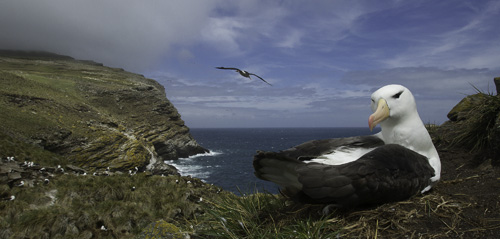
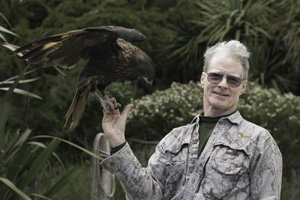
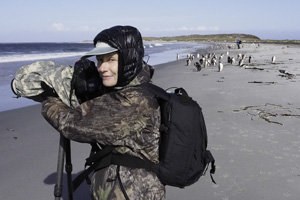
Striated Caracaras, one of the world's rarest raptors, are bold, and at one island the cook has conditioned birds to perch on his hand. There is a reason why falconers wear heavy leather gloves! Mary is wearing her typical outfit, down jacket and a windbreaker, while waiting for Gentoo Penguins to surf back onto the beach.
We will be offering this tour in December, 2015 and January, 2016
until we have a brochure posted, use this trip report for details.
This will present all the information you might need to choose this trip.
It has been twelve years since Mary and I have done a land-based tour of the Falkland Islands. In the interim, for every other year for the past eight we've visited a few Falkland Islands as part of an Antarctica expedition, giving us a little 'fix' for this great area. Returning once again to a land-based trip, we simply loved it, and reaffirmed our belief that the Falklands are one of the top five wildlife photography locations in the world.
The difference between the two, ship versus land-based trip, is this. From a ship all landings must be made by zodiac, and if the seas are rough or the wind strong a landing can't be made. In contrast, a land-based trip is independent of the weather, and so, once you're on an island you are free to photograph, regardless of the seas or winds. Flights between the islands are rarely cancelled, due to heavy fog or extremely high winds, but even if they are, assuming you're out of the capital town of Stanley, you're at a wildlife destination. Although you might miss a day elsewhere on another island, due to a flight cancellation, you're still at a shooting locale. In years past, when we had completed about ten photo tours here, I think we had one flight cancelled, where we stayed at one location an unplanned, extra day.
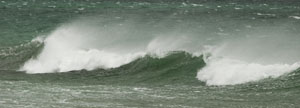 This year, locals were calling this the 'summerless summer,' as it was unusually cold, windy, and dreary for this time of the year. When we met one of our hosts, at Carcass, we were greeted with a "Welcome to winter," by our congenial host, Rob McGill. On any two week trip one can expect to have high winds, rain or sleet or hail, and cold temperatures at some point, while most of the time summer sun and clement temperatures predominate. This year they did not, and we had only a few occasions that were sunny most of the day.
This year, locals were calling this the 'summerless summer,' as it was unusually cold, windy, and dreary for this time of the year. When we met one of our hosts, at Carcass, we were greeted with a "Welcome to winter," by our congenial host, Rob McGill. On any two week trip one can expect to have high winds, rain or sleet or hail, and cold temperatures at some point, while most of the time summer sun and clement temperatures predominate. This year they did not, and we had only a few occasions that were sunny most of the day.
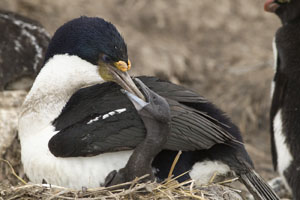 This wasn't a huge inconvenience however, as overcast conditions were often perfect for contrast-free images. I must admit that I did appreciate the sun when we had it, but having a bit of both, instead of just one or the other, made for a diverse portfolio of lighting conditions. And a diverse portfolio, too, as everyone shot a huge number of images. Each evening, if we had time, Mary and I would use BreezeBrowser and do a quick edit and cull, deleting the obvious mistakes or boring shots, and often cutting our files by as much as a half, and always at least by a third, in this process. Even in doing this, both of us ended up keeping over 200 gb, although when we returned home, using our larger monitors, we cut these files by about 90 percent.
This wasn't a huge inconvenience however, as overcast conditions were often perfect for contrast-free images. I must admit that I did appreciate the sun when we had it, but having a bit of both, instead of just one or the other, made for a diverse portfolio of lighting conditions. And a diverse portfolio, too, as everyone shot a huge number of images. Each evening, if we had time, Mary and I would use BreezeBrowser and do a quick edit and cull, deleting the obvious mistakes or boring shots, and often cutting our files by as much as a half, and always at least by a third, in this process. Even in doing this, both of us ended up keeping over 200 gb, although when we returned home, using our larger monitors, we cut these files by about 90 percent.
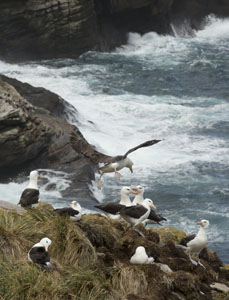 We visited eight different shooting locations in six different islands, and the shooting diverse was incredible. Each island offered something unique, either in terms of subject or in background. For example, we photographed Black-browed Albatrosses at two locations, but the lighting, background, proximity, and stage in nesting differed dramatically, making for quite different and equally rewarding shoots.
We visited eight different shooting locations in six different islands, and the shooting diverse was incredible. Each island offered something unique, either in terms of subject or in background. For example, we photographed Black-browed Albatrosses at two locations, but the lighting, background, proximity, and stage in nesting differed dramatically, making for quite different and equally rewarding shoots.
The shooting was quite diverse, and we photographed at least 30 different species of wildlife, including five species of Penguin (King, Gentoo, Macaroni, Magellanic, and everyone's favorite, the Rockhopper), five marine mammals (Orca, Elephant Seal, Southern Sea Lion, Commerson's Dolphin, and Peale's Dolphin), as well as gulls, geese, ducks, birds of prey, shorebirds, and songbirds. Being land-based, and on each island for at least two days, we had the luxury of spending time with our subjects, enabling us to capture behavior and not just shoot pretty portraits. For everyone, this was a real highlight of the trip, whether that was spending three hours at the beach catching Gentoo Penguins as they surfed in or spending a day at a huge Albatross colony.
The following is the complete blog or report. There will be more of these, for we will be returning to the Falklands for many more tours in our immediate future:
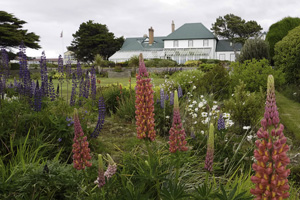
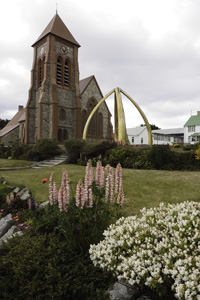
The climate of the Falklands is temperate, and in the gardens and parks
in Stanley flowers grow large in the long days of summer.
Day 1. Stanley
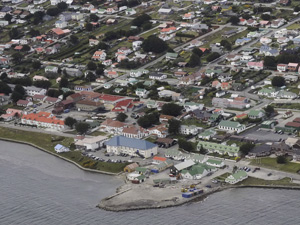 We arrived in Point Pleasant, the semi-commercial, semi-military airport for the Falklands by 2, met our land operator, and traveled the hour long route to Stanley, the capital of the Falklands. A recent referendum had just passed where only three or four of the 2,500 residents voted against the islands staying as part of the British commonwealth, but the vote didn’t offer an alternative. Independence, should it be sought, could leave the country vulnerable to an Argentine take-over, as that neighboring country is always clamoring about their lost Malvinas.
We arrived in Point Pleasant, the semi-commercial, semi-military airport for the Falklands by 2, met our land operator, and traveled the hour long route to Stanley, the capital of the Falklands. A recent referendum had just passed where only three or four of the 2,500 residents voted against the islands staying as part of the British commonwealth, but the vote didn’t offer an alternative. Independence, should it be sought, could leave the country vulnerable to an Argentine take-over, as that neighboring country is always clamoring about their lost Malvinas.
The Malvina Hotel has been renovated extensively since we were last here twelve years ago, and the rooms and the food were outstanding. We were on a full-board basis, which often implies a lousy selection for a dinner menu, but the choices were good and the food was great, tasty and plentiful.
All of us retired early after what has been several days of travel.
Day 2. To Bleaker Island
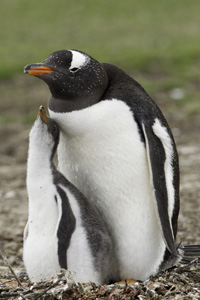 We had a mid-morning departure for Bleaker Island, and with our extra luggage paid nearly $250 in excess baggage. The intra-island transit is a flight system known as FIGAS, or Falkland Island Government Air Service, and was originally designed as a transport for residents visiting one another on various islands. Accordingly, luggage was limited, which made sense when people were literally commuting for a weekend visit or affair. The same luggage restrictions still apply, however, for tourists, limiting travelers to 44 pounds of luggage, barely enough to satisfy camera equipment and tripods. It’s nearly impossible to meet this requirement, although two of our travelers miraculously did. The rest did the best we could, and we paid the extra fees. Later, when speaking with one of the pilots, I learned that FIGAS typically operates at a loss, so the extra luggage, instead of being a headache and hassle for FIGAS, may actually be an important part of the revenue stream. I often wondered why FIGAS didn't have two fee structures, one for the commuting islanders who would usually need to carry little, and tourists, who had luggage and camera gear. Charging an extra fee might be the reason for no change, and if that's the case, one might be a little less worried about carrying extra luggage, provided you are willing to pay the fee.
We had a mid-morning departure for Bleaker Island, and with our extra luggage paid nearly $250 in excess baggage. The intra-island transit is a flight system known as FIGAS, or Falkland Island Government Air Service, and was originally designed as a transport for residents visiting one another on various islands. Accordingly, luggage was limited, which made sense when people were literally commuting for a weekend visit or affair. The same luggage restrictions still apply, however, for tourists, limiting travelers to 44 pounds of luggage, barely enough to satisfy camera equipment and tripods. It’s nearly impossible to meet this requirement, although two of our travelers miraculously did. The rest did the best we could, and we paid the extra fees. Later, when speaking with one of the pilots, I learned that FIGAS typically operates at a loss, so the extra luggage, instead of being a headache and hassle for FIGAS, may actually be an important part of the revenue stream. I often wondered why FIGAS didn't have two fee structures, one for the commuting islanders who would usually need to carry little, and tourists, who had luggage and camera gear. Charging an extra fee might be the reason for no change, and if that's the case, one might be a little less worried about carrying extra luggage, provided you are willing to pay the fee.
At the hotel the evening before
we sorted through our luggage, eliminating items as we could, although I insisted I’d rather pay an extra charge than compromise on any of the photographic gear I’d brought along and planned to use. That gear included a 400mm f5.6 for our longest telephoto, a 28-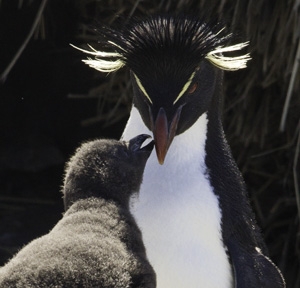 300mm for our over-all shooting, a 16-35mm wide angle, and a backup lens, a 70-300mm for me and a 70-200mm for Mary, in case one of the bigger lenses went down. The latter two lenses also are fast-focusing and extremely sharp, and we planned on using them for birds in flight.
300mm for our over-all shooting, a 16-35mm wide angle, and a backup lens, a 70-300mm for me and a 70-200mm for Mary, in case one of the bigger lenses went down. The latter two lenses also are fast-focusing and extremely sharp, and we planned on using them for birds in flight.
I also tried something completely different, using a 4/3rds format Olympus OM-D E-M1 camera. This camera uses an electronic viewfinder or a LCD monitor, which had some real pluses and one negative. On the positive side, this little camera felt like a real camera, just smaller and more convenient to carry. Shutter and aperture buttons were well placed, and setting an exposure was extremely 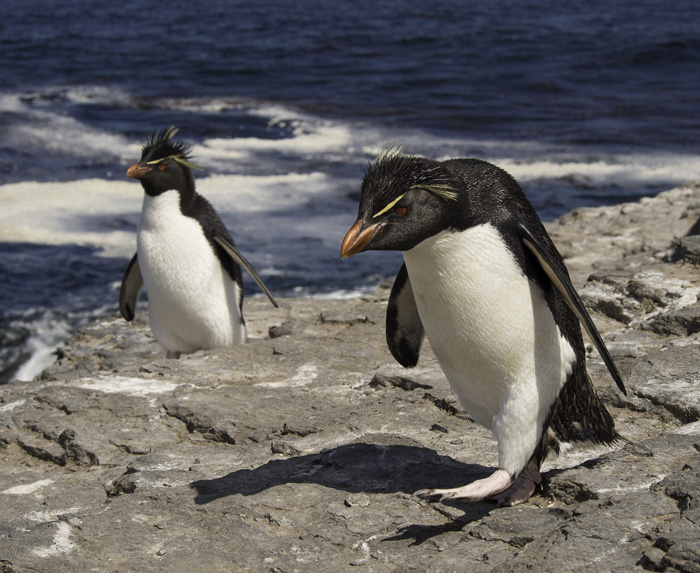 easy, as i could simply look through the viewfinder and turn dials until the image looked correct. An EV and a real time histogram visible in the viewfinder were also helpful at times. What I really liked about the camerawas the flip out LCD monitor, which allowed me to hold the camera at odd angles, or lay it on the ground, and still compose accurately. My Canon cameras lack this feature, which is maddening for me when doing low angle work, and I'd guess even more so for photographers shooting sports, crowded press conferences, and other events. The only negative I had was when I'd be shooting a motor drive burst (which was surprisingly fast), where, if I paused in firing, the
easy, as i could simply look through the viewfinder and turn dials until the image looked correct. An EV and a real time histogram visible in the viewfinder were also helpful at times. What I really liked about the camerawas the flip out LCD monitor, which allowed me to hold the camera at odd angles, or lay it on the ground, and still compose accurately. My Canon cameras lack this feature, which is maddening for me when doing low angle work, and I'd guess even more so for photographers shooting sports, crowded press conferences, and other events. The only negative I had was when I'd be shooting a motor drive burst (which was surprisingly fast), where, if I paused in firing, the 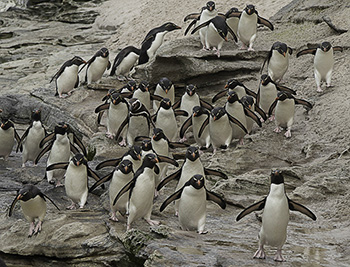 viewfinder or monitor would display the last frame. This would confuse me as I was trying to follow a subject. To be fair, there might be a setting that would eliminate this, but, hey, who reads manuals! I promise I will, I just didn't have the time to do so before I received the camera and began the trip. I'll be doing a more thorough review of this camera soon, but I really would encourage photographers who are either worried about weight (I'm thinking trips to Botswana or the Falklands or arctic where small planes might have luggage restrictions) or who have physical limitations and who cannot easily manage with a traditional, full size camera and the bigger, heavier lenses. In fact, one of our participants on this trap left all of his Canon equipment behind and shot with a 4/3rds camera and several lenses. His photo backpack was enviably small and light weight, and with his assortment of lenses he had wide-angle, macro, and the equivalent of a zoom reaching to 600mm. All in a package that would have fitted inside my Kiboko 22L backpack! I really liked the camera, and although I was only using just two lenses, the 40-150mm (equivalent of 80-300) and the 12mm wide-angle, I had plenty of chances to use it. It was so convenient to carry and always have on hand, and with it I photographed the Falkland Islands and the Andes for the first time while I was flying en route.
viewfinder or monitor would display the last frame. This would confuse me as I was trying to follow a subject. To be fair, there might be a setting that would eliminate this, but, hey, who reads manuals! I promise I will, I just didn't have the time to do so before I received the camera and began the trip. I'll be doing a more thorough review of this camera soon, but I really would encourage photographers who are either worried about weight (I'm thinking trips to Botswana or the Falklands or arctic where small planes might have luggage restrictions) or who have physical limitations and who cannot easily manage with a traditional, full size camera and the bigger, heavier lenses. In fact, one of our participants on this trap left all of his Canon equipment behind and shot with a 4/3rds camera and several lenses. His photo backpack was enviably small and light weight, and with his assortment of lenses he had wide-angle, macro, and the equivalent of a zoom reaching to 600mm. All in a package that would have fitted inside my Kiboko 22L backpack! I really liked the camera, and although I was only using just two lenses, the 40-150mm (equivalent of 80-300) and the 12mm wide-angle, I had plenty of chances to use it. It was so convenient to carry and always have on hand, and with it I photographed the Falkland Islands and the Andes for the first time while I was flying en route.
Both of us carried relatively light weight Really Right Stuff tripods (I used a RRS TVC 23 and Mary used her TVC 24L) and the smaller BH-40 ballheads as well. This was the first time I used the light TVC 23 and I loved it, as it provided sufficient support for my biggest lens, the 400mm. Both of us used our new Kiboko 22L backpacks, which made for a bit tighter fit than we have with our Bataflae packs, but every ounce counted with FIGAS and the backs were perfect for what we were planning on using on the trip. Since I switched to these Gura Gear bags I've paid a bit more attention to what other photographers are carrying, and I'm happy to say my switch reflects a trend. Most photographers are using these bags, including most European shooters I've seen, no doubt because the bags are extremely light weight for the durability and strength, and well designed.
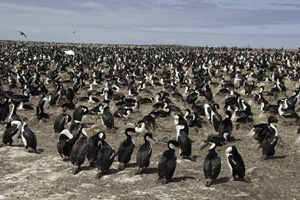 This was our first visit to Bleaker and we heard mixed reviews, with some raving about this island and others saying that the shooting was rather limited. After being picked up at their airfield we were driven around for a quick tour that passed Gentoo, Rockhopper, and Magellanic Penguins, an enormous King Cormorant Colony, and several ponds with Black-necked Swans and Silver Grebes.
This was our first visit to Bleaker and we heard mixed reviews, with some raving about this island and others saying that the shooting was rather limited. After being picked up at their airfield we were driven around for a quick tour that passed Gentoo, Rockhopper, and Magellanic Penguins, an enormous King Cormorant Colony, and several ponds with Black-necked Swans and Silver Grebes.
In 2011 a new guest house was added, with four rooms, to supplement their older guesthouse, and both houses are perhaps the best accommodations we’ve had on the islands. Clean, spacious, comfortable – perfect.
After lunch we walked up to the King Cormorant colony where we photographed birds swooping back to the nest, and where, later, Mary captured a Skua eating a lizard-like baby cormorant it had captured. The rest of us had moved on to the Rockhopper Penguin colony, which is probably the most accessible and photogenic colony of this species I’ve seen. Along the cliff there are several small colonies, with several ‘highways’ leading from the sea to the nesting area. Several nests were somewhat isolated, giving a nice, clean background, and the highways had multiple vantages for clean shots.
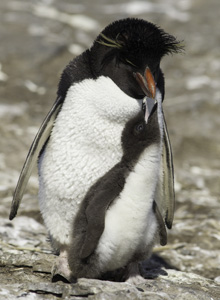
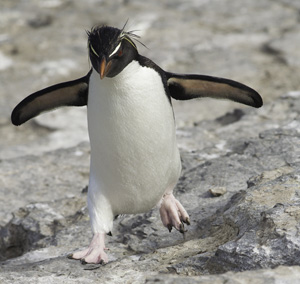
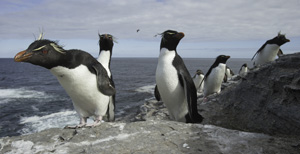
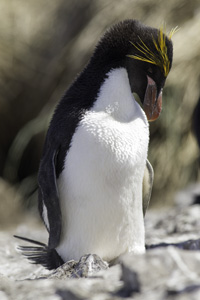 An added bonus was the lone, lonely Macaroni Penguin that had claimed a territory among the rockhoppers. Most of the time the bird simply sits on its plot, pathetically gathering twigs or pebbles, but several of us saw the bird actively courting, calling by raising its head high and following that with a comical march, circling an unimpressed Rockhopper repeatedly.
An added bonus was the lone, lonely Macaroni Penguin that had claimed a territory among the rockhoppers. Most of the time the bird simply sits on its plot, pathetically gathering twigs or pebbles, but several of us saw the bird actively courting, calling by raising its head high and following that with a comical march, circling an unimpressed Rockhopper repeatedly.
After dinner several of us hiked back to the King Cormorants which were bathed in a soft gold light and framed against dark blue clouds/sky, and where Falkland Skuas with chicks proved extremely tolerant. Normally these birds can be aggressive, dive-bombing an intruder that approaches a nest. These birds seemingly couldn’t care less.
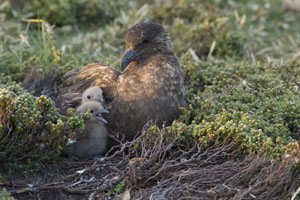
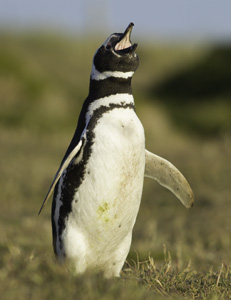
A Falkland Skua broods two small chicks, unconcerned by anyone nearby. As evening approached Magellanic Penguins, who often spend their days
in their nest burrows, emerge to bray, giving them the nickname Jackass Penguins.
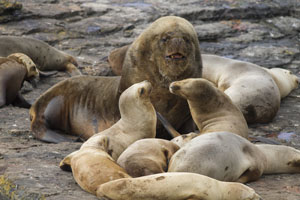 Day 3. Mike, the owner of the island, drove us to a distant overlook where we photographed forty Southern Sealions hauled up on a flat tidal shelf. The difference between the lone bull and the females was dramatic. Females were sleek and seal-like, as you’d expect, but the bull was a monster from Star Wars, with a squished in face, huge dome-like forehead and massive neck. We’d just spent a lot of time with Antarctic fur seals, and the contrast was striking – fur seal bulls are puppies in comparison.
Day 3. Mike, the owner of the island, drove us to a distant overlook where we photographed forty Southern Sealions hauled up on a flat tidal shelf. The difference between the lone bull and the females was dramatic. Females were sleek and seal-like, as you’d expect, but the bull was a monster from Star Wars, with a squished in face, huge dome-like forehead and massive neck. We’d just spent a lot of time with Antarctic fur seals, and the contrast was striking – fur seal bulls are puppies in comparison.
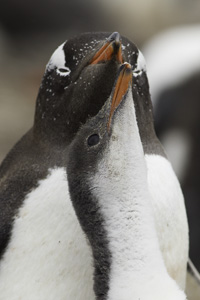
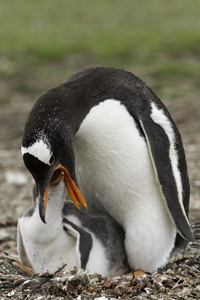
Afterwards we were driven to a large colony of Gentoo Penguins, with chicks of varying ages from nearly naked reptilian-looking babies to chicks nearly old enough to pursue their mother for food. A pair of Skuas nearby acted 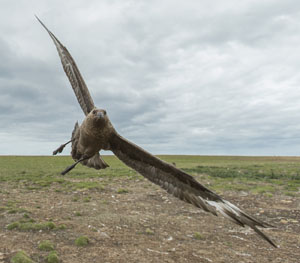 extremely aggressively, and I tried with limited success to photograph the birds as they swooped within two feet of my head. Skuas are big, heavy birds, and quite intimidating, and I was grateful to have a camera and lens
extremely aggressively, and I tried with limited success to photograph the birds as they swooped within two feet of my head. Skuas are big, heavy birds, and quite intimidating, and I was grateful to have a camera and lens
held before me as a block.
The colonies extend up and over a hilltop where birds converge from opposite sides of the thin island. Several of us went to the sand beach where Gentoo and Magellanic Penguins surfed and scampered ashore, challenging us to try to get birds as they were airborne. Occasionally we could see the dark outline of a bird speeding through the curl of a wave, and sometimes that bird would launch into the air, but most jumps were unexpected, and missed.
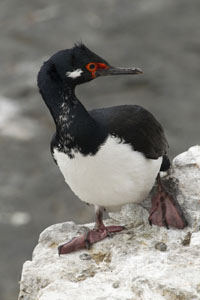 Hoping to have a repeat of the wonderful Rockhopper experience of yesterday, we left the beach early and hiked nearly two miles through the rolling, tundra-like landscape to the colony. Unlike true tundra, however, the ground is dry and hard, and walking is easy. Clouds had built up and the light was poor, and the wind strong, and the shooting was poor compared to the previous day. I spent much of the remainder of the afternoon walking back and forth towards the beach, looking for Mary who had lagged behind. She was okay, but being nearly two hours behind the rest of the group is always a cause for concern.
Hoping to have a repeat of the wonderful Rockhopper experience of yesterday, we left the beach early and hiked nearly two miles through the rolling, tundra-like landscape to the colony. Unlike true tundra, however, the ground is dry and hard, and walking is easy. Clouds had built up and the light was poor, and the wind strong, and the shooting was poor compared to the previous day. I spent much of the remainder of the afternoon walking back and forth towards the beach, looking for Mary who had lagged behind. She was okay, but being nearly two hours behind the rest of the group is always a cause for concern.
Day 4. Bleaker to Saunders
We had one of the earlier flights from Bleaker to Saunders, leaving at 9:30 and arriving on Saunders about 25 minutes later. The second plane (we needed two for the group) arrived within a few minutes and after loading up, driving to the settlement to drop off unneeded bags and to buy some last groceries, we started out on the bumpy one hour drive to the Portacabin where we’d spend the next two nights at the neck.
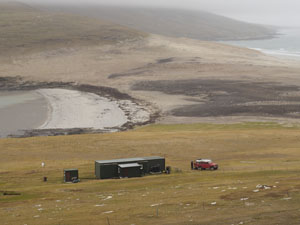 The cabin is a refurbished truck container, but with windows, aluminum exterior, and dry-walled and painted interior, it doesn’t feel like the inside of a tractor trailer hull. The cabin is divided into four sections, a small entranceway with an adjoining bathroom (with shower, sink, and toilet), a living area that is approximately 22x12 feet, and two bedroom areas, with four beds, bunk bed style, in each. A gas stove, small refrigerator, and 24 hour electricity finish the description, and the cabin is cozy but quite comfortable.
The cabin is a refurbished truck container, but with windows, aluminum exterior, and dry-walled and painted interior, it doesn’t feel like the inside of a tractor trailer hull. The cabin is divided into four sections, a small entranceway with an adjoining bathroom (with shower, sink, and toilet), a living area that is approximately 22x12 feet, and two bedroom areas, with four beds, bunk bed style, in each. A gas stove, small refrigerator, and 24 hour electricity finish the description, and the cabin is cozy but quite comfortable.
It was raining when we arrived, a light mist that had us hovering between staying in, and waiting it out, or dealing with the drizzle and seeing the island. After Mary’s lunch of tuna fish sandwiches and chips, we headed out and within 45 minutes the mist had stopped and the day grew progressively better. A few times the sky actually broke and we had nearly sunny conditions, but throughout most of the afternoon it was cloudy, but relatively bright. It didn’t matter… without rain, it was wonderful, and the birds cooperated just fine.
Mary hiked up to the Rockhopper Penguin colony where, about a month ago on our Antarctica cruise, we had stopped and seen a pair of Macaroni Penguins nesting here. The Macaronis were gone, and we suspect that continual harassment from the smaller, feisty Rockhoppers may have driven them out. It will be interesting to see if tomorrow they’ve returned, although we doubt it.
Judy and Don continued along the ridge and photographed, and thoroughly enjoyed, the Black-browed Albatross colony, with tiny hatchlings and adults continually swooping overhead. I headed to the beach and the pools where the Rockhoppers often float and bathe, and where I hoped to place an EWA bag for some looking up at the birds from underwater. The water was shallower than I expected, and after a day exposed at low tide, greenish and foul.
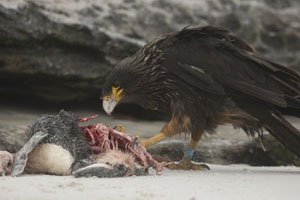 Several Striated Caracaras were clustered around a penguin carcass, with Turkey Vultures perched surprisingly close nearby. The caracaras were unconcerned by my approach and relative closeness, as these birds are bold and often quite pesky. The island owner, David Pole-Evans, told us that their huge Gentoo Penguin colonies have few chicks. Approximately twenty colonies are scattered along the Neck, the sandy isthmus separating the northern headland of the island from the principle land mass, and normally at this time of year every pair would have chicks. David said that over ninety Striated Caracaras had been visiting and mobbing the colony, and he believes the birds had wiped out the young. I was thinking over-fishing, and nest collapse from this, but David’s report of the increased number of predatory birds was probably the cause. Interestingly, he saw a Turkey Vulture carrying a penguin chick in its beak while in flight, something he’d never seen before, and something I didn’t believe possible. Later, I saw a Turkey Vulture eating a penguin chick high up on a cliff ledge, at a location where the prey had to be carried to the spot. A caracara later joined the bird and snatched part of the prey, hopping off to a higher ledge to feed. The vulture didn’t seem to mind.
Several Striated Caracaras were clustered around a penguin carcass, with Turkey Vultures perched surprisingly close nearby. The caracaras were unconcerned by my approach and relative closeness, as these birds are bold and often quite pesky. The island owner, David Pole-Evans, told us that their huge Gentoo Penguin colonies have few chicks. Approximately twenty colonies are scattered along the Neck, the sandy isthmus separating the northern headland of the island from the principle land mass, and normally at this time of year every pair would have chicks. David said that over ninety Striated Caracaras had been visiting and mobbing the colony, and he believes the birds had wiped out the young. I was thinking over-fishing, and nest collapse from this, but David’s report of the increased number of predatory birds was probably the cause. Interestingly, he saw a Turkey Vulture carrying a penguin chick in its beak while in flight, something he’d never seen before, and something I didn’t believe possible. Later, I saw a Turkey Vulture eating a penguin chick high up on a cliff ledge, at a location where the prey had to be carried to the spot. A caracara later joined the bird and snatched part of the prey, hopping off to a higher ledge to feed. The vulture didn’t seem to mind.
Most of us spent the majority of the afternoon, until nearly 6:30PM, with Rockhoppers hopping along the cliff ledges, jumping into the surf, or surfing to shore in large rafts of birds. There is a crevice I’d forgotten about where birds traveling to or from one section of colony had to leap across, and it was fun to photograph and to watch the birds doing so. While I suspect adults travel this route constantly, most appeared confused and at a loss when they arrived at the ledge, as if this obstacle was unexpected. Some spent several minutes mulling over the choice, moving higher up, then lower, until finally jumping.
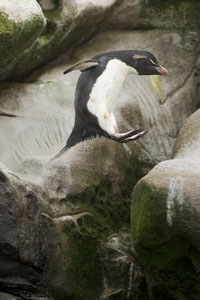
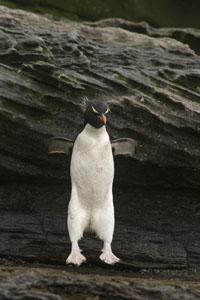
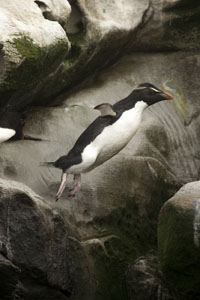
A few missed, and slid into the crevasse that marked the ledge. I was afraid that a bird would be wedged but none were, and after a few minutes trying to scramble up, the birds would drop, ungracefully, the last four feet to the rocks below, sometimes napping their heads back when their beak hit a rock outcrop on the way down.
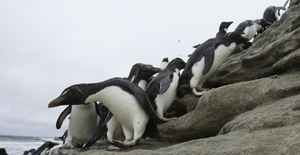 Some birds would end up on ledges leading to a dead end, where they would shake their heads, and circle about, looking for a way down. Although some birds would drop from as far as four feet, most chose smaller drops, and heights greater than four feet were too much. Again, I wondered how the birds could make these wrong moves, as the routes are followed constantly.
Some birds would end up on ledges leading to a dead end, where they would shake their heads, and circle about, looking for a way down. Although some birds would drop from as far as four feet, most chose smaller drops, and heights greater than four feet were too much. Again, I wondered how the birds could make these wrong moves, as the routes are followed constantly.
The birds would porpoise in, with a few birds visible at a time, but underwater they turned direction constantly, and following, or predicting, the birds location or next appearance was nearly 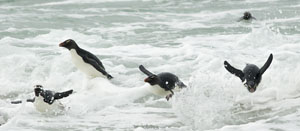 impossible. Low tide was around 1, and by 6 all of the rocks where we had initially set up to photograph from were either underwater or pounded by the rolling waves. We moved continually higher up onto the beach, as the tide progressively claimed rocks as it moved from right to left, north to southwest, swallowing the land as it did so.
impossible. Low tide was around 1, and by 6 all of the rocks where we had initially set up to photograph from were either underwater or pounded by the rolling waves. We moved continually higher up onto the beach, as the tide progressively claimed rocks as it moved from right to left, north to southwest, swallowing the land as it did so.
Day 5. Saunders Island
The weather forecast for today was predicted to be bad, and to reinforce that worry a cruise ship, schedule for today, visited Saunders yesterday. This morning we were awakened by the sound of the wind buffeting the cabin, and the tap of heavy rain hitting the windows. By 10AM the storm hadn’t abated, and although the rain was intermittent and light, the wind was strong, and discouraging.
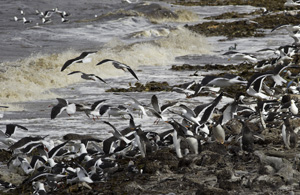
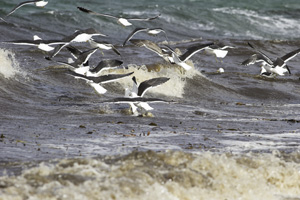
After lunch the rain had stopped and the light was breaking, but the wind continued. Judy and Don walked down to the beach to photograph the Rockhoppers, and I had planned to join them. As I neared the beach the tendrils of sand blowing across the beach swept to the corner where the penguins hauled out, and Judy, in the distance, was nearly obscured in blowing sand. I, wisely I thought, headed uphill, to join Keith, Eric, and Mary at the albatrosses.
Don and Judy, however, did get some nice atmospheric shots of penguins on the beach, almost hidden by blowing sand. Their videos showed penguins sometimes disappearing in a cloud of sand, and most of the time only the heads and upper flippers showed above the blowing sand.
With the wind, I completely missed Mary and the group hunkered down by a Black-browed Albatross colony and I walked on to the furthest colony where, in a deep gully, the wind was blocked. The birds were inactive, simply sitting on their mud nests and occasionally grooming, with one chick infrequently revealed as the adult stood. I shot and did some video, but felt I achieved little.
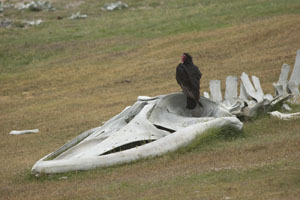 Meanwhile, while I was walking to and from the furthest colony, the rest of the group were shooting the albatrosses and did capture some nice shots, with adults feeding their chicks quite close to their position. At one point, when Mary was answering my radio call, her camera bag was dislodged by the wind and started rolling downhill, but Keith caught the bag an instant before it crashed into a nest.
Meanwhile, while I was walking to and from the furthest colony, the rest of the group were shooting the albatrosses and did capture some nice shots, with adults feeding their chicks quite close to their position. At one point, when Mary was answering my radio call, her camera bag was dislodged by the wind and started rolling downhill, but Keith caught the bag an instant before it crashed into a nest.
By 4PM the light had failed and the wind hadn’t changed and we headed back to the cabin. The trip was arduous, as we stumbled against the wind, reminiscent of Torres del Paine just a few weeks ago. Don and Judy, on the beach and sand-blasted, had to walk backwards to avoid having their faces buffed to the bone by the blowing sand. Judy did one shot of Don hunched down low, and obscured by the sand so that he looked as if he was in a snow blizzard.
By 9:30, as we prepared for bed, the wind still howled, and periodic rain showers slapped staccato beats on our glass windows.
Day 6. Saunders
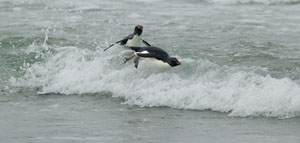 We were scheduled for a 11:30AM pickup to transport us back to the settlement, where we’d overnight and, in the afternoon, visit another rookery. The tide was still high, and Don and I headed to the Rockhopper colony where we filmed the birds as they surfed in, or scrambled among the rocks. The light was backlighted, but with the high seas at high tide the shooting was fairly productive.
We were scheduled for a 11:30AM pickup to transport us back to the settlement, where we’d overnight and, in the afternoon, visit another rookery. The tide was still high, and Don and I headed to the Rockhopper colony where we filmed the birds as they surfed in, or scrambled among the rocks. The light was backlighted, but with the high seas at high tide the shooting was fairly productive.
By the time we reached the settlement the clouds had returned and rain splattered the cottage windows. David, the owner of the island, drove Eric, Judy, Keith, and I out to a spectacular Rockhopper colony, probably the best one in all the Falklands. Unfortunately a driving rain made shooting virtually impossible, and the only work we did was with Judy’s GoPro where I positioned the camera along the penguin highway and she operated the camera remotely, via her phone. After an hour or two we were soaked and cold and returned to the settlement where David’s wife, Susan, made a surprisingly tasty dinner of roast lamb.
Day 7. Saunders to Carcass Island
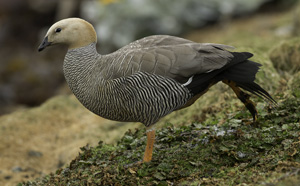 We had an early flight, although we were somewhat hoping that with the high winds the flight would be cancelled. The winds were strong, but with fairly clear weather, ‘though overcast, the FIGAS flight arrived on time. Rob McGill, the island owner, met us at the airstrip and with Rob driving one Landrover, and me in the other (and with Mary giving backseat directions beside me!) we headed to the settlement.
We had an early flight, although we were somewhat hoping that with the high winds the flight would be cancelled. The winds were strong, but with fairly clear weather, ‘though overcast, the FIGAS flight arrived on time. Rob McGill, the island owner, met us at the airstrip and with Rob driving one Landrover, and me in the other (and with Mary giving backseat directions beside me!) we headed to the settlement.
Carcass Island is named for a British ship that visited the islands in the late 1700s,
although those not knowing this envision a more grisly reason.
It was dreary and overcast and raining slightly when we arrived, and very cold, but by 4PM the weather broke, at least without rain, and everyone headed out to the beach to shoot the low tide life. Mary worked on Magellanic Penguins, Pied Oystercatchers, and Striated Caracaras, while I headed to wet areas, hoping to find Falkland Snipe.
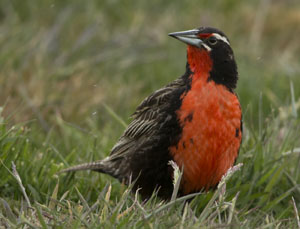 In these wet areas I did quite well with the beautiful, red-breasted Long-tailed Meadowlark and Falkland Thrushes, a robin-look-alike. The Meadowlarks were feeding upon the pupae stages of what I presume where beetles, and immature birds that exhibited no fear grabbed several within almost minimum focusing distance for my 400.
In these wet areas I did quite well with the beautiful, red-breasted Long-tailed Meadowlark and Falkland Thrushes, a robin-look-alike. The Meadowlarks were feeding upon the pupae stages of what I presume where beetles, and immature birds that exhibited no fear grabbed several within almost minimum focusing distance for my 400.
I headed to the beach where a Cobb’s Wren, a house wren-like bird, tempted me to stop. I settled down on the grass at the border of the beach and wrack from high tide and soon Tussock birds, dark, blackbird-looking birds that are called Cinclodes in mainland South America, visited me fearlessly. Both Judy (at a different location) and I had Tussock Birds hopping onto our feet or legs, and I suspect this fearless behavior stems from the ‘old days’ when thousands of seals covered these beaches and these birds would pick at seal skin, scabs, or ecoparasites. Today, the seals are gone from most islands, although this behavior is still commonly seen on Sea Lion Island, which we’ll visit soon, and probably exhibited on us, the nearest thing to a seal programmed into their genetic behavior.
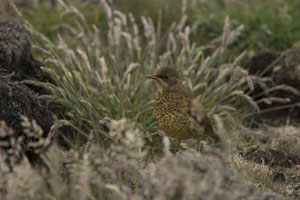
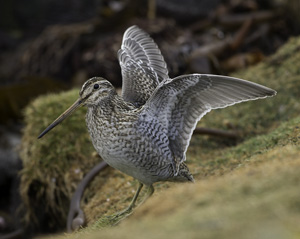
I stayed in one spot and soon had a Falkland Thrush or two come close, multiple Tussock Birds, and finally the bird I was after – a Falkland Snipe. This fed along the edge of the grasses, at the beach line, and over time probed and scuttled to within frame-filling distance of my 400. While I watched, I noticed two other Snipe sitting nearby, and I wondered how long they were there before my ‘search image’ detected them in the beach rocks.
A cold wind blew in by 5PM and the light failed, and everyone headed in to the guest house where we were treated to a spectacular, tasty, tender beef dinner. The meat literally was cut by a fork, but sliced thin, and we wondered how it hadn’t broken apart simply in the carving. Great food!
Day 8. West Point Island
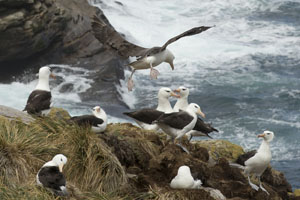 Sometime over the next two days we had scheduled, weather-permitting, a boat trip to a nearby island, West Point, the site of a great Black-browed Albatross colony and a scattered colony of Rockhopper Penguins. While we had planned on doing this trip tomorrow, two different cruise ships were scheduled to visit, leaving today our only viable option. It proved to be a great choice.
Sometime over the next two days we had scheduled, weather-permitting, a boat trip to a nearby island, West Point, the site of a great Black-browed Albatross colony and a scattered colony of Rockhopper Penguins. While we had planned on doing this trip tomorrow, two different cruise ships were scheduled to visit, leaving today our only viable option. It proved to be a great choice.
We left at 9:15 under dreary, overcast 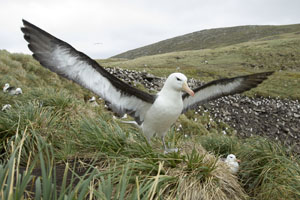 skies and a sufficient wind to make the seas choppy, and the small fishing vessel we used tossed and tilted in the waves. Periodically the bow of the boat dipped beneath the sea, reminding me of our recent trip through the Drake Passage, the infamous stretch of southern sea between the Antarctic Peninsula and the tip of South America. Fortunately we were driven the 1.5 miles uphill to the rookery, where we were dropped off by 11:30AM (after tea and cookies at the settlement here). I’ve been here before for brief visits on Antarctica cruises where we spent too little time, barely enough to do this island justice.
skies and a sufficient wind to make the seas choppy, and the small fishing vessel we used tossed and tilted in the waves. Periodically the bow of the boat dipped beneath the sea, reminding me of our recent trip through the Drake Passage, the infamous stretch of southern sea between the Antarctic Peninsula and the tip of South America. Fortunately we were driven the 1.5 miles uphill to the rookery, where we were dropped off by 11:30AM (after tea and cookies at the settlement here). I’ve been here before for brief visits on Antarctica cruises where we spent too little time, barely enough to do this island justice.
We needed the time, for the rookery location deserved it. We photographed here until nearly 4PM, and as the skies finally cleared and the wind died down we felt that we could have been here to sunset. Unlike the egg brooders of Saunders, the Albatrosses here were now sitting on one-third grown chicks, and periodically would regurgitate a slurry of food into the 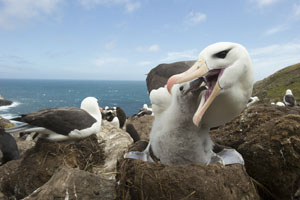 fuzzy white chicks’ mouths. We were able to shoot close, incorporating wide-angle portraits with spectacular landscapes. Mary worked both here and at a Rockhopper spot where birds bathed or showered.
fuzzy white chicks’ mouths. We were able to shoot close, incorporating wide-angle portraits with spectacular landscapes. Mary worked both here and at a Rockhopper spot where birds bathed or showered.
When we left the skies had cleared wonderfully and our boat captain, with a following sea, motored along, hoping we’d have Peale’s Dolphins and Commerson Dolphins. We were nearly two-thirds of the way across the straight from West Point to Carcass when at least four Peale’s and several Commerson Dolphins joined us, racing in front of our ship, sometimes arching out of the water, sometimes rolling completely over, yet continuing ahead of our ship. It was a great show, and a wonderful conclusion to what may be the most successful and rewarding day we’ve had on the Falklands, this trip.
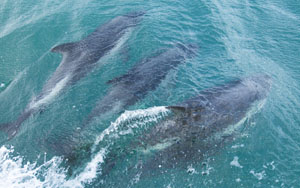
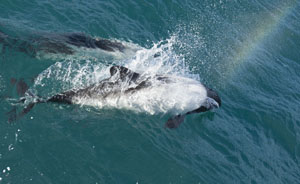
Day 9. Carcass
We awoke to a cloudless blue sky and relatively little wind, and for the first time we actually felt warm, almost uncomfortably so, when standing in the direct sun. With the bright, sharp light photography around the settlement was actually somewhat compromised, as the contrast was great. Mary was fairly successful with a Falkland Snipe, which she was after, and I went after Meadowlarks, without success. Perhaps yesterday’s gymnastics in worming through tussock grass for Albatross angles wore me out more than I thought, for in the warmth and sunshine I found I had no energy. Instead, I stretched out on the grasses out of the little wind and snoozed for 1.5 hours, enjoying that time immensely.
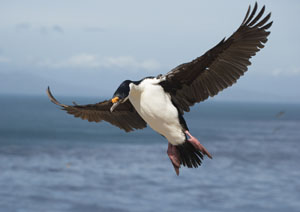
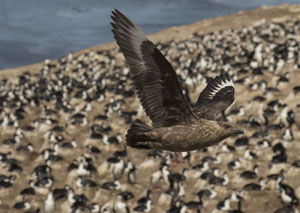
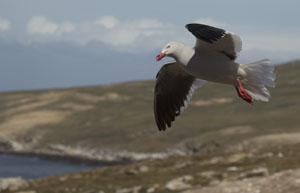
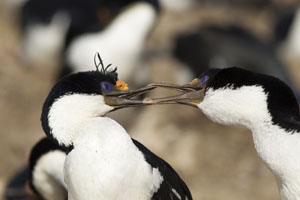
From upper left, clockwise: King Cormorant, Falkland Skua, King Cormorant, Dolphin Gull
After lunch we headed to the large King Cormorant colony on the opposite side of the island. I hadn’t been to this site for nearly twelve years, and the colony has grown. When we arrived birds were flying in carrying nesting material, and the shooting was fast and productive. Soon, however, it slowed, and the many birds that flew in were empty-beaked. Mary spotted one Cormorant with two chicks, and we photographed several courting or mating, all with the sun and the wind to our back, giving us great light and perfect fly-bys as the birds typically fly into the wind to land. We had to park on a ridge high above the colony, and the hike back to the vehicles was a bit invigorating, but only took about 15 minutes for nearly everyone.
After dinner Mary and I tried walking off another huge meal, as the one problem with the Falklands is it is too easy to get fat! The food everywhere has been great, but the chef here at Carcass, a good-natured English-speaking man from Santiago, is perhaps the very best. Food, in the form of fruit or pastries, is available around the clock, and only the barest of self-control keep us from simply staying at the table. The walk, hopefully, settled us down!
Day 10. Carcass to Sea Lion Island
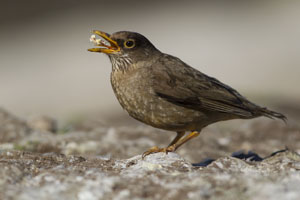 Under somewhat overcast skies we headed to Carcass’s airfield around 9:15 for the 45 minute flight to Sea Lion, often considered the Crown Jewel of the Falklands. We arrived to near perfect conditions, with no wind and bright sunshine warming the land to almost uncomfortable temperatures, since we were now accustomed to near Falkland winter conditions. We were met by Jenny, the lodge manager who we’ve known for years, and before lunch I did a quick 35 minute hike through the likely areas, including the Elephant Seal beach, the Neck, the Gentoo Colonies, and the beaches, and confirmed that there was a lot to shoot quite close to the lodge. After a very good lunch Eric, Mary, and I headed south towards the Elephant Seal beach, while Judy, Don, and Keith headed towards the Gentoo Penguin colonies and the flat beaches of this island’s Neck.
Under somewhat overcast skies we headed to Carcass’s airfield around 9:15 for the 45 minute flight to Sea Lion, often considered the Crown Jewel of the Falklands. We arrived to near perfect conditions, with no wind and bright sunshine warming the land to almost uncomfortable temperatures, since we were now accustomed to near Falkland winter conditions. We were met by Jenny, the lodge manager who we’ve known for years, and before lunch I did a quick 35 minute hike through the likely areas, including the Elephant Seal beach, the Neck, the Gentoo Colonies, and the beaches, and confirmed that there was a lot to shoot quite close to the lodge. After a very good lunch Eric, Mary, and I headed south towards the Elephant Seal beach, while Judy, Don, and Keith headed towards the Gentoo Penguin colonies and the flat beaches of this island’s Neck.
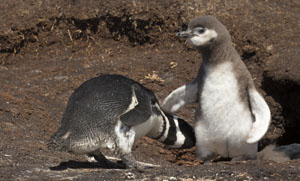 Almost immediately the three of us were shooting Magellanic Penguins, the most cooperative and tame we’ve found on the Falklands. Their chicks are now quite large, and the back ends have shed the juvenile down to reveal adult feathers. Fortunately their forequarters, face, and neck are still down-covered and quite cute, and I suspect that there might be survival advantage to this. Maintaining the ‘baby look’ at the front, adults might be more inclined to feed and nurture their young longer than if the face and front looked like an independent immature, which might be rejected. At any rate, we had great luck with penguins with chicks, in contrast to most areas where the chicks shyly disappear into their burrows at our approach.
Almost immediately the three of us were shooting Magellanic Penguins, the most cooperative and tame we’ve found on the Falklands. Their chicks are now quite large, and the back ends have shed the juvenile down to reveal adult feathers. Fortunately their forequarters, face, and neck are still down-covered and quite cute, and I suspect that there might be survival advantage to this. Maintaining the ‘baby look’ at the front, adults might be more inclined to feed and nurture their young longer than if the face and front looked like an independent immature, which might be rejected. At any rate, we had great luck with penguins with chicks, in contrast to most areas where the chicks shyly disappear into their burrows at our approach.
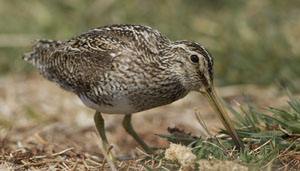 At one point Mary was behind me when a Falkland Snipe flew in and began to feed. When Mary finished shooting I took over, lying on my belly on the warm, short grass for an eye-level view of the unconcerned snipe. The bird would prodded and poke, hammering like a woodpecker as it hunted for worms and grubs. Although the action was too fast for me to see, the camera captured several shots where the bird gobbled up small worms or fat grubs, either of a beetle or, perhaps, a moth.
At one point Mary was behind me when a Falkland Snipe flew in and began to feed. When Mary finished shooting I took over, lying on my belly on the warm, short grass for an eye-level view of the unconcerned snipe. The bird would prodded and poke, hammering like a woodpecker as it hunted for worms and grubs. Although the action was too fast for me to see, the camera captured several shots where the bird gobbled up small worms or fat grubs, either of a beetle or, perhaps, a moth.
While I filmed the weather changed and the warm summer vanished under a steady, intensifying wind. I left the penguins and continued on, finally meeting Mary at the Elephant Seal beach where she was waiting on more penguins. A family of Kelp Geese, the black and white female and two 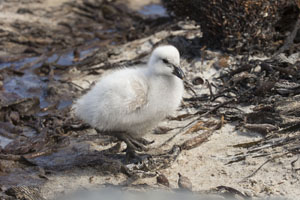 downy chicks, walked across the walks quite close to us, stopping at a small pool to drink. The pure white male stood guard nearby, circled, and joined the group as they continued feeding up the beach.
downy chicks, walked across the walks quite close to us, stopping at a small pool to drink. The pure white male stood guard nearby, circled, and joined the group as they continued feeding up the beach.
In the distance, down near the Neck, the wind had kicked up a Sahara-like sandstorm, and the air above the beach was a cloud of brown. Using Live View and increasing the magnification to 10X I could barely make out Don and Judy, contending with the blowing sand while still trying to shoot. At this point the wind was blowing from the north and directly into their faces, making conditions brutal. As we watched, however, the wind shifted to the south and with the change Mary and I decided to work the beaches for sandstorm shots of the penguins. Previously, at Saunder’s Neck, Judy had captured some iconic images of Rockhopper Penguins half-obscured by sand, and we hoped to do something similar with the Gentoos.
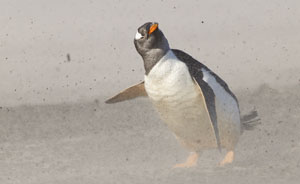
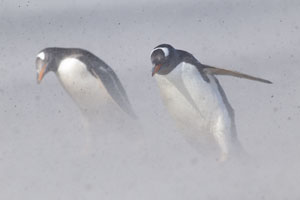
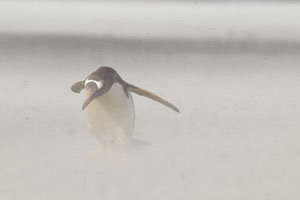
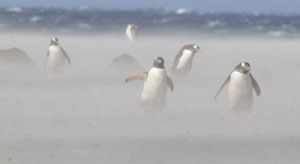
The conditions were brutal and to photograph we had to keep our faces, and the front of our lenses, away from the wind. Blowing sand and black grit filled the air, often completely hiding the penguins as they tottered along, fighting their way back to their nests.
With a blasting wind that literally pushed us forward at times, we tried several different views, starting with penguins at their colony and later, as we built our confidence, along the sandy beach where the sand blew hardest. Covering our 400mm and camera with a FotoSharp raincover, our equipment stayed safe from the sand. I had placed my Kiboko backpack on the sand for more comfort, and by the end of the shoot, an hour or so later, the mesh side pockets and any gap or cranny was filled with sand.
The shooting was spectacular, however, with birds struggling against the wind and sand, pushing forward in a maelstrom of debris. Gentoos often swung their heads far to the left and right, probably to clear their vision, while Magellanic Penguins really suffered in the wind, swaying and rocking, and looking more like us in the way they handled, or mishandled, the wind. We were in a perfect position, with nearly every wave of penguins emerging from the surf eventually walking nearby, and our shooting was constant, with well over 1,500 images shot in the hour.
The wind intensified, and our short walk back to the lodge took a half hour as we fought both wind, blowing sand, and blinding debris. A pair of Striated Caracaras nest somewhere in the high grass and even in this wind the birds were still defensive. Mary’s camera was whacked by one bird, and I had my hat hit hard by another when we accidentally walked too close to the nest. Fighting the wind and watching for burrow openings of Magellanic Penguins, while keeping an eye over our shoulder for a dive-bombing Caracara made for a taxing walk, and we were exhausted by the time we reached the lodge.
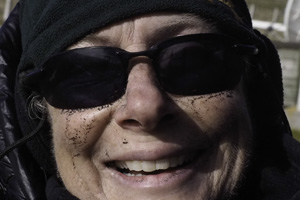
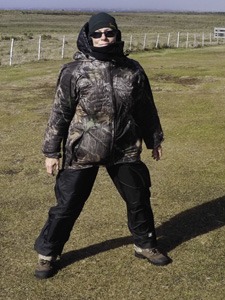
That's not a series of tattoos on Mary's face. That's the remains of the blowing sand from the sandstorm we photographed in. Mary's odd pose is from the heavy wind, still blowing when we returned to the lodge.
After dinner the sky cleared briefly, although the wind continued, and I was tempted to return to the beach for some late light. Strangely, however, the sand was gone, as if the wind had completely blown clear any loose sand. From the lodge, using binoculars, I studied the beaches for any sign of blowing sand but it was gone. Birds, too, seemed absent from the beach although a friend of our’s, also staying here, hiked down and reported birds were returning on the surf, tossed around madly in the unstable seas. Soon, however, a cloud blocked the sun and a rain squall hammered our windows, dampening any temptation I had to head back out into the wind.
Day 11. Sea Lion
The wind continued, with periodic rain squalls, and we spent the morning catching up on editing, writing, and relaxing. A few went out, but the wind, after two months of dealing with it in Antarctica and Torres del Paine, discouraged us into being, happily (or guiltily) lazy.
This proved to be a mistake. Judy, Eric, Keith, and Don had hiked the short distance to the Elephant Seal beach where they were mostly out of the wind and had a wonderful morning photographing the seals fighting almost constantly for the three hours they were there. For example, Eric shot over 2,000 images during that time.
After lunch several of us headed back out, with Mary and I first stopping at the seals but mid-day the seals were dormant, just slug-like blobs lying together on the sand. Mary continued down the beach towards the eastern point, where she photographed South American Terns hovering overhead, Giant Petrels sailing by, great Cobb’s Wren, Flightless Steamer Duck, Two-banded Plover, and Sanderlings.
I headed inland, hoping to find a workable Falkland Skua nest with chicks, and I’d only hiked a hundred yards or so when I found a good nest in low vegetation and a small chick sitting beside the adult. The adult was very 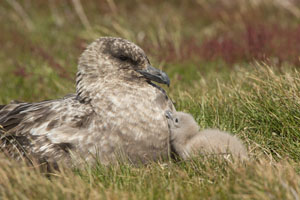 tolerant and within a short time I had shuffled forward on my butt to a nice distance. The chick was hungry and would frequently half-circle the female, pecking at her beak and several times grabbing the female’s breast feathers in its beak. The female would rise, lifting the chick off the ground in doing so. Periodically the female would shift about as if settling herself, and I wondered if she had an egg hatching beneath her.
tolerant and within a short time I had shuffled forward on my butt to a nice distance. The chick was hungry and would frequently half-circle the female, pecking at her beak and several times grabbing the female’s breast feathers in its beak. The female would rise, lifting the chick off the ground in doing so. Periodically the female would shift about as if settling herself, and I wondered if she had an egg hatching beneath her.
At one point, two Turkey Vultures sailed overhead and to my surprise the female left the nest and took off after the vultures. Although vultures rarely, if ever, catch live prey (at Saunders, David said they will take penguin chicks), they vaguely resemble other predatory birds and this may have triggered the response. Nonetheless, leaving the nest left the chicks (there were two, one about a third smaller and probably a day or two younger) vulnerable to gulls or Striated Caracaras. Fortunately no other predator appeared and the skua returned to the nest.
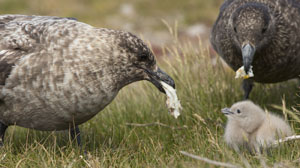 A short time later a distant Skua appeared, and from its flight I guessed that it might be this bird’s mate as it flew straight towards us. The female took off and a short flight followed, before both birds landed a short distance from the nest. The male flew closer to the nest, and the female followed, where, when they landed, the female bobbed and weaved and nibbled at the male’s beak, soliciting food. The behavior reminded me of foxes or jackals, with a mate or a pup hounding a returning adult to regurgitate food. The response was the same and the adult male (I presume, a much darker bird) regurgitated fish or squid which the female grabbed.
A short time later a distant Skua appeared, and from its flight I guessed that it might be this bird’s mate as it flew straight towards us. The female took off and a short flight followed, before both birds landed a short distance from the nest. The male flew closer to the nest, and the female followed, where, when they landed, the female bobbed and weaved and nibbled at the male’s beak, soliciting food. The behavior reminded me of foxes or jackals, with a mate or a pup hounding a returning adult to regurgitate food. The response was the same and the adult male (I presume, a much darker bird) regurgitated fish or squid which the female grabbed.
Meanwhile, the larger of the two chicks, the one that had been out and about the entire time, ran over and began to beg. Both adults leaned over and offered tidbits, although the female did most of the feeding as she had the bulk of the food. The smaller chick cheeped away, but remained in the nest and was never fed. After the food was finished the male walked over to the nest and settled on top of the smaller chick and the larger chick returned, settling next to the adult as it had previously.
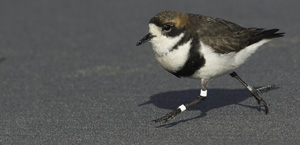 Meanwhile, Mary had crossed the Neck and was now at the beach, waiting for Gentoo Penguins to surf in to the beach. Using Live View, I hit the zoom button and had a 10X view of the 400mm lens, or 4,000mm, so from several hundred yards away I could just make her out. I headed over.
Meanwhile, Mary had crossed the Neck and was now at the beach, waiting for Gentoo Penguins to surf in to the beach. Using Live View, I hit the zoom button and had a 10X view of the 400mm lens, or 4,000mm, so from several hundred yards away I could just make her out. I headed over.
Over the next three hours Mary, Judy, Eric, and I photographed the penguins as they returned to the beach. Most came in at the wrong spot, too far away in either direction, but Mary got some very nice shots regardless. I did poorly. Surprisingly, at one point two Steamer Ducks – I suspect Flying Steamers, actually flew in towards the beach, mostly just skimming the water’s surface but getting airborne at one point.
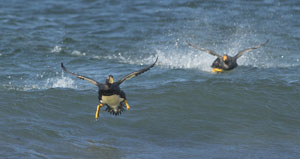
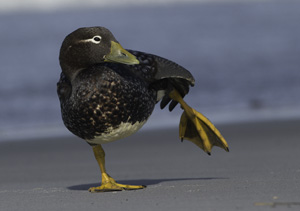
Flying Steamer Ducks are poor flyers, while the very similar looking Flightless species usually just paddles, kind of light a paddle-wheel, which may have given rise to their name Steamer. The two species are so similar that identification is difficult, and Mary thinks the two were Flightless, while I think they were the Flying species.
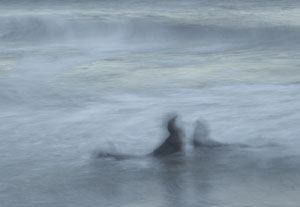 After dinner I returned to the Elephant Seal beach and the seals were a bit more active than they were in the afternoon, with a few pairs periodically sparring on the beach and surf. As the light dropped lower I shot some very slow shutter speed shots for an ethereal effect, including wave action on rocks, but the shooting was marginal as I raced against the failing light.
After dinner I returned to the Elephant Seal beach and the seals were a bit more active than they were in the afternoon, with a few pairs periodically sparring on the beach and surf. As the light dropped lower I shot some very slow shutter speed shots for an ethereal effect, including wave action on rocks, but the shooting was marginal as I raced against the failing light.
Birds on Sea Lion are perhaps the most habituated of any on the islands, and I was continually surprised to find the normally skittish Pied Oystercatchers sitting amongst the washed up kelp, just a few feet from where I stood.
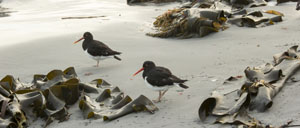
Day 12. Sea Lion to Stanley
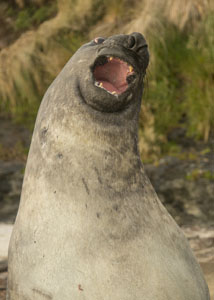 Although we were hoping for a late morning flight back to Stanley our flight was early, leaving at 9:20. I was still hoping to get some Elephant Seals and so I left at 6AM for the beach. Over the next 1.5 hours there was plenty of action, and rarely more than five minutes went by before some seals began to spar. Most ‘fights’ were simply friendly tests of strength, with seals rearing high and banging heads and necks, and open-mouthed biting where jaws were not closed and no injuries resulted. One pair, however, got rough, with one male dominating the other, biting its neck and obviously causing the other seal some pain and stress.
Although we were hoping for a late morning flight back to Stanley our flight was early, leaving at 9:20. I was still hoping to get some Elephant Seals and so I left at 6AM for the beach. Over the next 1.5 hours there was plenty of action, and rarely more than five minutes went by before some seals began to spar. Most ‘fights’ were simply friendly tests of strength, with seals rearing high and banging heads and necks, and open-mouthed biting where jaws were not closed and no injuries resulted. One pair, however, got rough, with one male dominating the other, biting its neck and obviously causing the other seal some pain and stress.
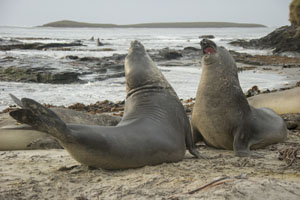 I was under a deadline, promising to return back to the lodge by 7:45 to help Mary back for our departure. As I started backed I glanced out to sea, and spotted the dorsal fins of Orcas! For the past several years a pod of Orcas, or Killer Whales, have appeared off the coast of Sea Lion Island, feeding on Elephant Seals at one time of year, and newly fledged penguins later in the season. The caretaker at the lodge said that in October and early November the Orcas were taking Elephant Seals nearly daily, but now are making a kill once or twice a week. Most kills were of young seals, but adults were also taken, and hunts often occurred right at dawn.
I was under a deadline, promising to return back to the lodge by 7:45 to help Mary back for our departure. As I started backed I glanced out to sea, and spotted the dorsal fins of Orcas! For the past several years a pod of Orcas, or Killer Whales, have appeared off the coast of Sea Lion Island, feeding on Elephant Seals at one time of year, and newly fledged penguins later in the season. The caretaker at the lodge said that in October and early November the Orcas were taking Elephant Seals nearly daily, but now are making a kill once or twice a week. Most kills were of young seals, but adults were also taken, and hunts often occurred right at dawn.
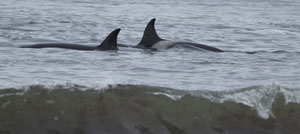 Yesterday eleven Orcas were spotted outside ‘the pools,’ a tidal area where Orcas often hunt. Today there were seven, and at one point they swam right outside the crest of waves. Years ago, Mary and I were given two-way radios from a BBC film crew here on SLI, with the intention being we’d radio the crew if we had Orcas on the south side of the beach, and they’d radio us if they saw them on the north side. Mary was keeping the radio and, much to her continual harassment, turned off the radio to save the battery, intending to turn it on if we had whales. She did not turn it on otherwise, and so the radio messages the BBC was sending, with whales on the north beach, went unheard! Those whales were hunting Gentoo Penguins, but we saw none that day.
Yesterday eleven Orcas were spotted outside ‘the pools,’ a tidal area where Orcas often hunt. Today there were seven, and at one point they swam right outside the crest of waves. Years ago, Mary and I were given two-way radios from a BBC film crew here on SLI, with the intention being we’d radio the crew if we had Orcas on the south side of the beach, and they’d radio us if they saw them on the north side. Mary was keeping the radio and, much to her continual harassment, turned off the radio to save the battery, intending to turn it on if we had whales. She did not turn it on otherwise, and so the radio messages the BBC was sending, with whales on the north beach, went unheard! Those whales were hunting Gentoo Penguins, but we saw none that day.
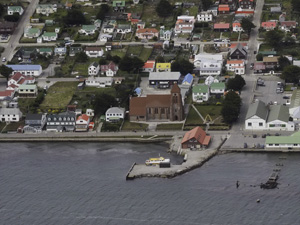 At 9 we walked the short distance to the airfield for an uneventful flight back to Stanley. As we neared the town, the pilot graciously circled the town, giving me an aerial view from the harbor side for some nice photos. After lunch, we visited the small but interesting Falkland Museum. There I was most interested in learning more about the Warrah, the Falkland Islands only endemic mammal, a canine that resembled a large fox. DNA analysis of the only remaining mounted specimens of this extinct mammal show that it is most closely related to the
At 9 we walked the short distance to the airfield for an uneventful flight back to Stanley. As we neared the town, the pilot graciously circled the town, giving me an aerial view from the harbor side for some nice photos. After lunch, we visited the small but interesting Falkland Museum. There I was most interested in learning more about the Warrah, the Falkland Islands only endemic mammal, a canine that resembled a large fox. DNA analysis of the only remaining mounted specimens of this extinct mammal show that it is most closely related to the 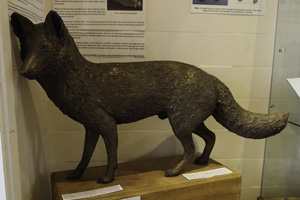 Maned Wolf of mainland South America. By the late 1870’s this mammal, once abundant throughout the islands, was extinct. Its presence on the islands was an intriguing mystery, as the Falklands are 800 miles from South America and this canine represented the most remote colonization of a terrestrial mammal by natural (?) means. One hypothesis was that an errant group of Fuegian Indians made it to the islands with a domesticated, dog-like animal. The Indians didn’t survive but the dog did, and became the Warrah. Another guess had the Chinese investigating these islands long ago, and leaving behind their canine. The DNA analysis, however, shows that the link to the Maned Wolf goes back 200,000 years, nearly 10 times older than the supposed arrival of Indians in southern South America.
Maned Wolf of mainland South America. By the late 1870’s this mammal, once abundant throughout the islands, was extinct. Its presence on the islands was an intriguing mystery, as the Falklands are 800 miles from South America and this canine represented the most remote colonization of a terrestrial mammal by natural (?) means. One hypothesis was that an errant group of Fuegian Indians made it to the islands with a domesticated, dog-like animal. The Indians didn’t survive but the dog did, and became the Warrah. Another guess had the Chinese investigating these islands long ago, and leaving behind their canine. The DNA analysis, however, shows that the link to the Maned Wolf goes back 200,000 years, nearly 10 times older than the supposed arrival of Indians in southern South America.
Current, and probably accurate, thinking is this. During one of the several Ice Ages, the Warrah made its way across the ice sheet that extended north from Antarctica and extended from South America to the Falklands, and beyond. This canine could have hunted the ice sheet edge for seals and penguins, as this edge would have held much life. In just one season, its possible that a canine could move 800 miles, and establish itself on the Falklands.
Sadly, only six specimens of this once abundant Canine exist. Charles Darwin, after observing its fearless nature, predicted that it would soon join the Dodo bird in extinction. Within fifty years, he was proved correct. The Warrah fed upon penguins, fish, and various birds, and sheep, once they were introduced, and the latter cemented its fate. As the island’s top predator it was fearless, and is said to have been killed as easily as holding a knife in one hand, to slice the animal’s throat, while baiting it with meat in the other hand. Today, in the museum, only a bronze life-size cast and some old skull bones are all that’s left of the Warrah in the Falklands.
Day 13. The Cape
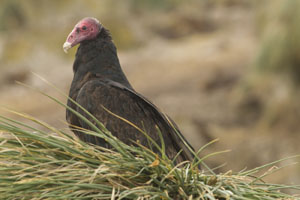 The weather forecast was bad, and as we started a land-based excursion to a remote northern point on East Falkland we were pessimistic about the day’s shooting. We needn't’t be, for the weather broke when we arrived 2.5 hours later, after the last hour’s drive over the moorland on a somewhat bumpy ride.
The weather forecast was bad, and as we started a land-based excursion to a remote northern point on East Falkland we were pessimistic about the day’s shooting. We needn't’t be, for the weather broke when we arrived 2.5 hours later, after the last hour’s drive over the moorland on a somewhat bumpy ride.
Stretched in front of us was the front of the southern Atlantic, and between us and the sea one of the prettiest coastlines on the Falklands. Along the cliffs Peregrine Falcons nest, although we saw none today, and on the flats a nice colony of King Cormorants and Rockhopper Penguins nest. Amongst the Rockhoppers at least two Macaroni Penguin pairs nest as well, and Mary spotted a hybrid between the two, with the yellow eyebrow of the Rockhopper but the foppish feather tuffs, heavier bill, and larger size, of the Macaroni. In the tussock grasses behind us and on the sea cliffs and chutes leading to the sea a very large colony of somewhat skittish Southern Sea Lions lay scattered.
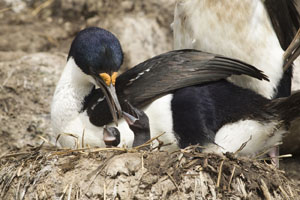 Unlike the preceding two colonies, at Bleacher and at Carcass, many of the King Cormorants here had chicks, ranging in size from new hatchlings with naked skins, thin necks, and huge heads that remind us of small snakes, hence the ‘snake babies’ we labeled them, to birds about a third-grown, covered in black down. Some nests had babies ranging in size from the tiny snake babies, still sporting an egg tooth, to the largest babies. In these, when the adult fed, the large chicks received the food and we wondered if the youngest, smallest, would survive. In a good fish year all three might, for a big chick, when full, will allow the smallest to feed, but only then.
Unlike the preceding two colonies, at Bleacher and at Carcass, many of the King Cormorants here had chicks, ranging in size from new hatchlings with naked skins, thin necks, and huge heads that remind us of small snakes, hence the ‘snake babies’ we labeled them, to birds about a third-grown, covered in black down. Some nests had babies ranging in size from the tiny snake babies, still sporting an egg tooth, to the largest babies. In these, when the adult fed, the large chicks received the food and we wondered if the youngest, smallest, would survive. In a good fish year all three might, for a big chick, when full, will allow the smallest to feed, but only then.
It was amazing to watch the cormorants feed, as it was a classic sword-swallowing act. Chicks would constantly be bobbing and weaving, periodically looking upwards or tapping at the chest, neck, face, or beak of the adult, although most begging seemed to be ignored. When the female did feed, she’d open her mouth and the baby would insert its entire head, and sometimes a good portion of the neck, into the adult’s mouth and throat, so deep that it looked as if the chick could actually scrounge about in the adult’s belly! The young would stay in this position for several seconds while the female jerked her neck slightly, probably regurgitating the fish.
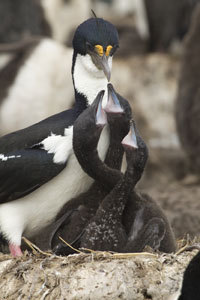 Tiny snake babies were fed slightly differently. Here the adult would attempt to almost pluck the babies head between her (assuming a female here) beak, lining up the baby’s head with the line of her beak. When she regurgitated, the chick’s lower beak would nearly rest inside the throat or skin of the lower beak, and small portions of food would trickle down into the baby’s open mouth.
Tiny snake babies were fed slightly differently. Here the adult would attempt to almost pluck the babies head between her (assuming a female here) beak, lining up the baby’s head with the line of her beak. When she regurgitated, the chick’s lower beak would nearly rest inside the throat or skin of the lower beak, and small portions of food would trickle down into the baby’s open mouth.
We had great views of some of the Macaroni Penguins, but unfortunately the adult birds were scuffed and muddy and not particularly attractive. The one chick I observed was nearly as large as the adult, looked nearly exactly like a Rockhopper, and gave a constant, whistling keening.
Rockhopper chicks were large, and at the nest with the mud and dirt the setting was not attractive. Much better shooting occurred along the rock pathways leading to and from the sea, or near the ocean’s edge where birds bathed in a large tidal pool or surfed into the rocks on the surging tides. Birds returning had pure white breasts, washed spotless from the sea, while those hopping down the rocks ranged from white and nearly clean to almost red and completely bedraggled with mud. I set up a remote and tried some shots with a wide-angle but the positions couldn’t capture the breadth of the scene as I had wished.
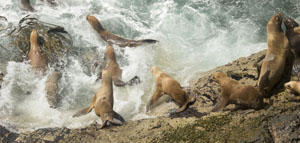 The Southern Sea Lions were a bit skittish, and we had to be careful not to start a stampede. Both huge bulls and subadults lounged amongst the tussock grass, and combinations of bulls, cows, and subadults lined the cliffs and sea chutes. The shooting was good, but a bit nerve-wracking as we were afraid to startle the sea lions into fleeing.
The Southern Sea Lions were a bit skittish, and we had to be careful not to start a stampede. Both huge bulls and subadults lounged amongst the tussock grass, and combinations of bulls, cows, and subadults lined the cliffs and sea chutes. The shooting was good, but a bit nerve-wracking as we were afraid to startle the sea lions into fleeing.
At 2:30 we had to start back for home but within a few minutes of our drive clouds gathered and it rained, continuing almost all the way back to Stanley. The change in weather made palatable the leaving, as otherwise it would have been killing us to leave this beautiful spot.
Day 14. Volunteer Point
Perhaps the iconic bird of the Falklands and certainly the most colorful of the penguins is the King, which nest at Volunteer Point, a 2 hour plus drive from Stanley. The last hour is rough, crossing the moorland and weaving to and fro through gaps, gullies, dried ponds, hills, and assorted other bumps. Years ago, this route was even worse, requiring either a taxing cross country route along a ridge or, if the tide was right, along a rocky shoreline. Today, a new road leads directly to the final farm, bypassing all that fun, before one needs to go off track.
 About 800 pairs of King Penguins nest at Volunteer Point, now permanently staffed by a warden who supervises that everyone maintains the proper distance from the penguins. A ring of white rocks encircle the colony, but penguins often huddle quite close to the edge and getting frame-filling shots is not difficult. Birds were on eggs, incubating, but this is done with the single egg resting on the feet of an adult and never touching the ground. During an egg exchange, adults will stand toe-to-toe and nudge the egg from one set of feet to the other. Normally, the egg is hidden by the broad
About 800 pairs of King Penguins nest at Volunteer Point, now permanently staffed by a warden who supervises that everyone maintains the proper distance from the penguins. A ring of white rocks encircle the colony, but penguins often huddle quite close to the edge and getting frame-filling shots is not difficult. Birds were on eggs, incubating, but this is done with the single egg resting on the feet of an adult and never touching the ground. During an egg exchange, adults will stand toe-to-toe and nudge the egg from one set of feet to the other. Normally, the egg is hidden by the broad 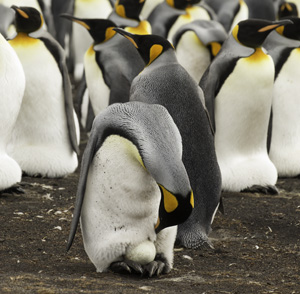 flap of loose skin that droops like a grotesque beer belly, covering all but the tip of the birds’ feet. Occasionally a bird will contract this skin, lifting it so that the egg is visible, which the adult inspects.
flap of loose skin that droops like a grotesque beer belly, covering all but the tip of the birds’ feet. Occasionally a bird will contract this skin, lifting it so that the egg is visible, which the adult inspects.
Some birds sky pointed, lifting their beaks to the sky and trumpeting, and throughout the day this trumpeting is constant. Our weather failed, and a southern cold front had blown in, bringing with it high winds and cold temperatures, so much that we could see our breath. By 1, an hour and a half earlier than planned, we decided to head back to Stanley, as the penguins were not doing anything unique that five to fifteen minutes didn’t cover.
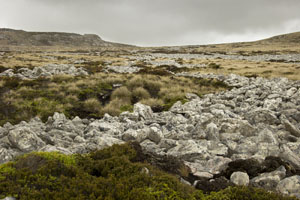
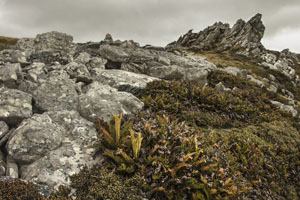
On the route back we stopped at the unique Stone Rivers, boulder fields that run down the hillsides like streams. The exact origin of the stone rivers isn’t known, but it is believed that the rocks were split and cracked during the last ice age, as any crevice would split with repeated freezing and thawing. The rocks are huge and varied, from Volkswagen size to baseball size, but today they are immobile. In the past, perhaps during the end of the last ice age, these rocks may have slipped downhill, carried by smaller, rounder rocks at the base layer which may have functioned like ball bearings.
At 6:30 we met to review highlights of the trip, from favorite location, lodge, food, photo subject, to the three best shots each person made. The answers were diverse, reflecting the enormous variety of experiences and opportunities we had. We’ll be back, and we can’t wait for our next trip, in 2015.
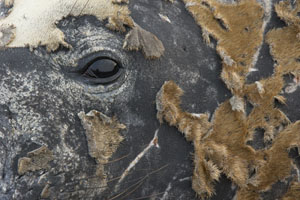
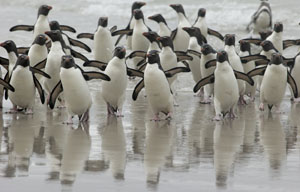
If you are interested in joining us for a future Falkland Island Wildlife Photography Tour, contact our office at info@hoothollow.com. We will be doing two trips, at the end of 2015 and beginning of 2016. The trip is limited to only six participants.
Falklands Islands
2013-14
Trip Report



Striated Caracaras, one of the world's rarest raptors, are bold, and at one island the cook has conditioned birds to perch on his hand. There is a reason why falconers wear heavy leather gloves! Mary is wearing her typical outfit, down jacket and a windbreaker, while waiting for Gentoo Penguins to surf back onto the beach.
We will be offering this tour in December, 2015 and January, 2016
until we have a brochure posted, use this trip report for details.
This will present all the information you might need to choose this trip.
It has been twelve years since Mary and I have done a land-based tour of the Falkland Islands. In the interim, for every other year for the past eight we've visited a few Falkland Islands as part of an Antarctica expedition, giving us a little 'fix' for this great area. Returning once again to a land-based trip, we simply loved it, and reaffirmed our belief that the Falklands are one of the top five wildlife photography locations in the world.
The difference between the two, ship versus land-based trip, is this. From a ship all landings must be made by zodiac, and if the seas are rough or the wind strong a landing can't be made. In contrast, a land-based trip is independent of the weather, and so, once you're on an island you are free to photograph, regardless of the seas or winds. Flights between the islands are rarely cancelled, due to heavy fog or extremely high winds, but even if they are, assuming you're out of the capital town of Stanley, you're at a wildlife destination. Although you might miss a day elsewhere on another island, due to a flight cancellation, you're still at a shooting locale. In years past, when we had completed about ten photo tours here, I think we had one flight cancelled, where we stayed at one location an unplanned, extra day.
 This year, locals were calling this the 'summerless summer,' as it was unusually cold, windy, and dreary for this time of the year. When we met one of our hosts, at Carcass, we were greeted with a "Welcome to winter," by our congenial host, Rob McGill. On any two week trip one can expect to have high winds, rain or sleet or hail, and cold temperatures at some point, while most of the time summer sun and clement temperatures predominate. This year they did not, and we had only a few occasions that were sunny most of the day.
This year, locals were calling this the 'summerless summer,' as it was unusually cold, windy, and dreary for this time of the year. When we met one of our hosts, at Carcass, we were greeted with a "Welcome to winter," by our congenial host, Rob McGill. On any two week trip one can expect to have high winds, rain or sleet or hail, and cold temperatures at some point, while most of the time summer sun and clement temperatures predominate. This year they did not, and we had only a few occasions that were sunny most of the day.
 This wasn't a huge inconvenience however, as overcast conditions were often perfect for contrast-free images. I must admit that I did appreciate the sun when we had it, but having a bit of both, instead of just one or the other, made for a diverse portfolio of lighting conditions. And a diverse portfolio, too, as everyone shot a huge number of images. Each evening, if we had time, Mary and I would use BreezeBrowser and do a quick edit and cull, deleting the obvious mistakes or boring shots, and often cutting our files by as much as a half, and always at least by a third, in this process. Even in doing this, both of us ended up keeping over 200 gb, although when we returned home, using our larger monitors, we cut these files by about 90 percent.
This wasn't a huge inconvenience however, as overcast conditions were often perfect for contrast-free images. I must admit that I did appreciate the sun when we had it, but having a bit of both, instead of just one or the other, made for a diverse portfolio of lighting conditions. And a diverse portfolio, too, as everyone shot a huge number of images. Each evening, if we had time, Mary and I would use BreezeBrowser and do a quick edit and cull, deleting the obvious mistakes or boring shots, and often cutting our files by as much as a half, and always at least by a third, in this process. Even in doing this, both of us ended up keeping over 200 gb, although when we returned home, using our larger monitors, we cut these files by about 90 percent.
 We visited eight different shooting locations in six different islands, and the shooting diverse was incredible. Each island offered something unique, either in terms of subject or in background. For example, we photographed Black-browed Albatrosses at two locations, but the lighting, background, proximity, and stage in nesting differed dramatically, making for quite different and equally rewarding shoots.
We visited eight different shooting locations in six different islands, and the shooting diverse was incredible. Each island offered something unique, either in terms of subject or in background. For example, we photographed Black-browed Albatrosses at two locations, but the lighting, background, proximity, and stage in nesting differed dramatically, making for quite different and equally rewarding shoots.
The shooting was quite diverse, and we photographed at least 30 different species of wildlife, including five species of Penguin (King, Gentoo, Macaroni, Magellanic, and everyone's favorite, the Rockhopper), five marine mammals (Orca, Elephant Seal, Southern Sea Lion, Commerson's Dolphin, and Peale's Dolphin), as well as gulls, geese, ducks, birds of prey, shorebirds, and songbirds. Being land-based, and on each island for at least two days, we had the luxury of spending time with our subjects, enabling us to capture behavior and not just shoot pretty portraits. For everyone, this was a real highlight of the trip, whether that was spending three hours at the beach catching Gentoo Penguins as they surfed in or spending a day at a huge Albatross colony.
The following is the complete blog or report. There will be more of these, for we will be returning to the Falklands for many more tours in our immediate future:


The climate of the Falklands is temperate, and in the gardens and parks
in Stanley flowers grow large in the long days of summer.
Day 1. Stanley
 We arrived in Point Pleasant, the semi-commercial, semi-military airport for the Falklands by 2, met our land operator, and traveled the hour long route to Stanley, the capital of the Falklands. A recent referendum had just passed where only three or four of the 2,500 residents voted against the islands staying as part of the British commonwealth, but the vote didn’t offer an alternative. Independence, should it be sought, could leave the country vulnerable to an Argentine take-over, as that neighboring country is always clamoring about their lost Malvinas.
We arrived in Point Pleasant, the semi-commercial, semi-military airport for the Falklands by 2, met our land operator, and traveled the hour long route to Stanley, the capital of the Falklands. A recent referendum had just passed where only three or four of the 2,500 residents voted against the islands staying as part of the British commonwealth, but the vote didn’t offer an alternative. Independence, should it be sought, could leave the country vulnerable to an Argentine take-over, as that neighboring country is always clamoring about their lost Malvinas.
The Malvina Hotel has been renovated extensively since we were last here twelve years ago, and the rooms and the food were outstanding. We were on a full-board basis, which often implies a lousy selection for a dinner menu, but the choices were good and the food was great, tasty and plentiful.
All of us retired early after what has been several days of travel.
Day 2. To Bleaker Island
 We had a mid-morning departure for Bleaker Island, and with our extra luggage paid nearly $250 in excess baggage. The intra-island transit is a flight system known as FIGAS, or Falkland Island Government Air Service, and was originally designed as a transport for residents visiting one another on various islands. Accordingly, luggage was limited, which made sense when people were literally commuting for a weekend visit or affair. The same luggage restrictions still apply, however, for tourists, limiting travelers to 44 pounds of luggage, barely enough to satisfy camera equipment and tripods. It’s nearly impossible to meet this requirement, although two of our travelers miraculously did. The rest did the best we could, and we paid the extra fees. Later, when speaking with one of the pilots, I learned that FIGAS typically operates at a loss, so the extra luggage, instead of being a headache and hassle for FIGAS, may actually be an important part of the revenue stream. I often wondered why FIGAS didn't have two fee structures, one for the commuting islanders who would usually need to carry little, and tourists, who had luggage and camera gear. Charging an extra fee might be the reason for no change, and if that's the case, one might be a little less worried about carrying extra luggage, provided you are willing to pay the fee.
We had a mid-morning departure for Bleaker Island, and with our extra luggage paid nearly $250 in excess baggage. The intra-island transit is a flight system known as FIGAS, or Falkland Island Government Air Service, and was originally designed as a transport for residents visiting one another on various islands. Accordingly, luggage was limited, which made sense when people were literally commuting for a weekend visit or affair. The same luggage restrictions still apply, however, for tourists, limiting travelers to 44 pounds of luggage, barely enough to satisfy camera equipment and tripods. It’s nearly impossible to meet this requirement, although two of our travelers miraculously did. The rest did the best we could, and we paid the extra fees. Later, when speaking with one of the pilots, I learned that FIGAS typically operates at a loss, so the extra luggage, instead of being a headache and hassle for FIGAS, may actually be an important part of the revenue stream. I often wondered why FIGAS didn't have two fee structures, one for the commuting islanders who would usually need to carry little, and tourists, who had luggage and camera gear. Charging an extra fee might be the reason for no change, and if that's the case, one might be a little less worried about carrying extra luggage, provided you are willing to pay the fee.
At the hotel the evening before
we sorted through our luggage, eliminating items as we could, although I insisted I’d rather pay an extra charge than compromise on any of the photographic gear I’d brought along and planned to use. That gear included a 400mm f5.6 for our longest telephoto, a 28- 300mm for our over-all shooting, a 16-35mm wide angle, and a backup lens, a 70-300mm for me and a 70-200mm for Mary, in case one of the bigger lenses went down. The latter two lenses also are fast-focusing and extremely sharp, and we planned on using them for birds in flight.
300mm for our over-all shooting, a 16-35mm wide angle, and a backup lens, a 70-300mm for me and a 70-200mm for Mary, in case one of the bigger lenses went down. The latter two lenses also are fast-focusing and extremely sharp, and we planned on using them for birds in flight.
I also tried something completely different, using a 4/3rds format Olympus OM-D E-M1 camera. This camera uses an electronic viewfinder or a LCD monitor, which had some real pluses and one negative. On the positive side, this little camera felt like a real camera, just smaller and more convenient to carry. Shutter and aperture buttons were well placed, and setting an exposure was extremely  easy, as i could simply look through the viewfinder and turn dials until the image looked correct. An EV and a real time histogram visible in the viewfinder were also helpful at times. What I really liked about the camerawas the flip out LCD monitor, which allowed me to hold the camera at odd angles, or lay it on the ground, and still compose accurately. My Canon cameras lack this feature, which is maddening for me when doing low angle work, and I'd guess even more so for photographers shooting sports, crowded press conferences, and other events. The only negative I had was when I'd be shooting a motor drive burst (which was surprisingly fast), where, if I paused in firing, the
easy, as i could simply look through the viewfinder and turn dials until the image looked correct. An EV and a real time histogram visible in the viewfinder were also helpful at times. What I really liked about the camerawas the flip out LCD monitor, which allowed me to hold the camera at odd angles, or lay it on the ground, and still compose accurately. My Canon cameras lack this feature, which is maddening for me when doing low angle work, and I'd guess even more so for photographers shooting sports, crowded press conferences, and other events. The only negative I had was when I'd be shooting a motor drive burst (which was surprisingly fast), where, if I paused in firing, the  viewfinder or monitor would display the last frame. This would confuse me as I was trying to follow a subject. To be fair, there might be a setting that would eliminate this, but, hey, who reads manuals! I promise I will, I just didn't have the time to do so before I received the camera and began the trip. I'll be doing a more thorough review of this camera soon, but I really would encourage photographers who are either worried about weight (I'm thinking trips to Botswana or the Falklands or arctic where small planes might have luggage restrictions) or who have physical limitations and who cannot easily manage with a traditional, full size camera and the bigger, heavier lenses. In fact, one of our participants on this trap left all of his Canon equipment behind and shot with a 4/3rds camera and several lenses. His photo backpack was enviably small and light weight, and with his assortment of lenses he had wide-angle, macro, and the equivalent of a zoom reaching to 600mm. All in a package that would have fitted inside my Kiboko 22L backpack! I really liked the camera, and although I was only using just two lenses, the 40-150mm (equivalent of 80-300) and the 12mm wide-angle, I had plenty of chances to use it. It was so convenient to carry and always have on hand, and with it I photographed the Falkland Islands and the Andes for the first time while I was flying en route.
viewfinder or monitor would display the last frame. This would confuse me as I was trying to follow a subject. To be fair, there might be a setting that would eliminate this, but, hey, who reads manuals! I promise I will, I just didn't have the time to do so before I received the camera and began the trip. I'll be doing a more thorough review of this camera soon, but I really would encourage photographers who are either worried about weight (I'm thinking trips to Botswana or the Falklands or arctic where small planes might have luggage restrictions) or who have physical limitations and who cannot easily manage with a traditional, full size camera and the bigger, heavier lenses. In fact, one of our participants on this trap left all of his Canon equipment behind and shot with a 4/3rds camera and several lenses. His photo backpack was enviably small and light weight, and with his assortment of lenses he had wide-angle, macro, and the equivalent of a zoom reaching to 600mm. All in a package that would have fitted inside my Kiboko 22L backpack! I really liked the camera, and although I was only using just two lenses, the 40-150mm (equivalent of 80-300) and the 12mm wide-angle, I had plenty of chances to use it. It was so convenient to carry and always have on hand, and with it I photographed the Falkland Islands and the Andes for the first time while I was flying en route.
Both of us carried relatively light weight Really Right Stuff tripods (I used a RRS TVC 23 and Mary used her TVC 24L) and the smaller BH-40 ballheads as well. This was the first time I used the light TVC 23 and I loved it, as it provided sufficient support for my biggest lens, the 400mm. Both of us used our new Kiboko 22L backpacks, which made for a bit tighter fit than we have with our Bataflae packs, but every ounce counted with FIGAS and the backs were perfect for what we were planning on using on the trip. Since I switched to these Gura Gear bags I've paid a bit more attention to what other photographers are carrying, and I'm happy to say my switch reflects a trend. Most photographers are using these bags, including most European shooters I've seen, no doubt because the bags are extremely light weight for the durability and strength, and well designed.
 This was our first visit to Bleaker and we heard mixed reviews, with some raving about this island and others saying that the shooting was rather limited. After being picked up at their airfield we were driven around for a quick tour that passed Gentoo, Rockhopper, and Magellanic Penguins, an enormous King Cormorant Colony, and several ponds with Black-necked Swans and Silver Grebes.
This was our first visit to Bleaker and we heard mixed reviews, with some raving about this island and others saying that the shooting was rather limited. After being picked up at their airfield we were driven around for a quick tour that passed Gentoo, Rockhopper, and Magellanic Penguins, an enormous King Cormorant Colony, and several ponds with Black-necked Swans and Silver Grebes.
In 2011 a new guest house was added, with four rooms, to supplement their older guesthouse, and both houses are perhaps the best accommodations we’ve had on the islands. Clean, spacious, comfortable – perfect.
After lunch we walked up to the King Cormorant colony where we photographed birds swooping back to the nest, and where, later, Mary captured a Skua eating a lizard-like baby cormorant it had captured. The rest of us had moved on to the Rockhopper Penguin colony, which is probably the most accessible and photogenic colony of this species I’ve seen. Along the cliff there are several small colonies, with several ‘highways’ leading from the sea to the nesting area. Several nests were somewhat isolated, giving a nice, clean background, and the highways had multiple vantages for clean shots.



 An added bonus was the lone, lonely Macaroni Penguin that had claimed a territory among the rockhoppers. Most of the time the bird simply sits on its plot, pathetically gathering twigs or pebbles, but several of us saw the bird actively courting, calling by raising its head high and following that with a comical march, circling an unimpressed Rockhopper repeatedly.
An added bonus was the lone, lonely Macaroni Penguin that had claimed a territory among the rockhoppers. Most of the time the bird simply sits on its plot, pathetically gathering twigs or pebbles, but several of us saw the bird actively courting, calling by raising its head high and following that with a comical march, circling an unimpressed Rockhopper repeatedly.
After dinner several of us hiked back to the King Cormorants which were bathed in a soft gold light and framed against dark blue clouds/sky, and where Falkland Skuas with chicks proved extremely tolerant. Normally these birds can be aggressive, dive-bombing an intruder that approaches a nest. These birds seemingly couldn’t care less.


A Falkland Skua broods two small chicks, unconcerned by anyone nearby. As evening approached Magellanic Penguins, who often spend their days
in their nest burrows, emerge to bray, giving them the nickname Jackass Penguins.
 Day 3. Mike, the owner of the island, drove us to a distant overlook where we photographed forty Southern Sealions hauled up on a flat tidal shelf. The difference between the lone bull and the females was dramatic. Females were sleek and seal-like, as you’d expect, but the bull was a monster from Star Wars, with a squished in face, huge dome-like forehead and massive neck. We’d just spent a lot of time with Antarctic fur seals, and the contrast was striking – fur seal bulls are puppies in comparison.
Day 3. Mike, the owner of the island, drove us to a distant overlook where we photographed forty Southern Sealions hauled up on a flat tidal shelf. The difference between the lone bull and the females was dramatic. Females were sleek and seal-like, as you’d expect, but the bull was a monster from Star Wars, with a squished in face, huge dome-like forehead and massive neck. We’d just spent a lot of time with Antarctic fur seals, and the contrast was striking – fur seal bulls are puppies in comparison.


Afterwards we were driven to a large colony of Gentoo Penguins, with chicks of varying ages from nearly naked reptilian-looking babies to chicks nearly old enough to pursue their mother for food. A pair of Skuas nearby acted  extremely aggressively, and I tried with limited success to photograph the birds as they swooped within two feet of my head. Skuas are big, heavy birds, and quite intimidating, and I was grateful to have a camera and lens
extremely aggressively, and I tried with limited success to photograph the birds as they swooped within two feet of my head. Skuas are big, heavy birds, and quite intimidating, and I was grateful to have a camera and lens
held before me as a block.
The colonies extend up and over a hilltop where birds converge from opposite sides of the thin island. Several of us went to the sand beach where Gentoo and Magellanic Penguins surfed and scampered ashore, challenging us to try to get birds as they were airborne. Occasionally we could see the dark outline of a bird speeding through the curl of a wave, and sometimes that bird would launch into the air, but most jumps were unexpected, and missed.
 Hoping to have a repeat of the wonderful Rockhopper experience of yesterday, we left the beach early and hiked nearly two miles through the rolling, tundra-like landscape to the colony. Unlike true tundra, however, the ground is dry and hard, and walking is easy. Clouds had built up and the light was poor, and the wind strong, and the shooting was poor compared to the previous day. I spent much of the remainder of the afternoon walking back and forth towards the beach, looking for Mary who had lagged behind. She was okay, but being nearly two hours behind the rest of the group is always a cause for concern.
Hoping to have a repeat of the wonderful Rockhopper experience of yesterday, we left the beach early and hiked nearly two miles through the rolling, tundra-like landscape to the colony. Unlike true tundra, however, the ground is dry and hard, and walking is easy. Clouds had built up and the light was poor, and the wind strong, and the shooting was poor compared to the previous day. I spent much of the remainder of the afternoon walking back and forth towards the beach, looking for Mary who had lagged behind. She was okay, but being nearly two hours behind the rest of the group is always a cause for concern.
Day 4. Bleaker to Saunders
We had one of the earlier flights from Bleaker to Saunders, leaving at 9:30 and arriving on Saunders about 25 minutes later. The second plane (we needed two for the group) arrived within a few minutes and after loading up, driving to the settlement to drop off unneeded bags and to buy some last groceries, we started out on the bumpy one hour drive to the Portacabin where we’d spend the next two nights at the neck.
 The cabin is a refurbished truck container, but with windows, aluminum exterior, and dry-walled and painted interior, it doesn’t feel like the inside of a tractor trailer hull. The cabin is divided into four sections, a small entranceway with an adjoining bathroom (with shower, sink, and toilet), a living area that is approximately 22x12 feet, and two bedroom areas, with four beds, bunk bed style, in each. A gas stove, small refrigerator, and 24 hour electricity finish the description, and the cabin is cozy but quite comfortable.
The cabin is a refurbished truck container, but with windows, aluminum exterior, and dry-walled and painted interior, it doesn’t feel like the inside of a tractor trailer hull. The cabin is divided into four sections, a small entranceway with an adjoining bathroom (with shower, sink, and toilet), a living area that is approximately 22x12 feet, and two bedroom areas, with four beds, bunk bed style, in each. A gas stove, small refrigerator, and 24 hour electricity finish the description, and the cabin is cozy but quite comfortable.
It was raining when we arrived, a light mist that had us hovering between staying in, and waiting it out, or dealing with the drizzle and seeing the island. After Mary’s lunch of tuna fish sandwiches and chips, we headed out and within 45 minutes the mist had stopped and the day grew progressively better. A few times the sky actually broke and we had nearly sunny conditions, but throughout most of the afternoon it was cloudy, but relatively bright. It didn’t matter… without rain, it was wonderful, and the birds cooperated just fine.
Mary hiked up to the Rockhopper Penguin colony where, about a month ago on our Antarctica cruise, we had stopped and seen a pair of Macaroni Penguins nesting here. The Macaronis were gone, and we suspect that continual harassment from the smaller, feisty Rockhoppers may have driven them out. It will be interesting to see if tomorrow they’ve returned, although we doubt it.
Judy and Don continued along the ridge and photographed, and thoroughly enjoyed, the Black-browed Albatross colony, with tiny hatchlings and adults continually swooping overhead. I headed to the beach and the pools where the Rockhoppers often float and bathe, and where I hoped to place an EWA bag for some looking up at the birds from underwater. The water was shallower than I expected, and after a day exposed at low tide, greenish and foul.
 Several Striated Caracaras were clustered around a penguin carcass, with Turkey Vultures perched surprisingly close nearby. The caracaras were unconcerned by my approach and relative closeness, as these birds are bold and often quite pesky. The island owner, David Pole-Evans, told us that their huge Gentoo Penguin colonies have few chicks. Approximately twenty colonies are scattered along the Neck, the sandy isthmus separating the northern headland of the island from the principle land mass, and normally at this time of year every pair would have chicks. David said that over ninety Striated Caracaras had been visiting and mobbing the colony, and he believes the birds had wiped out the young. I was thinking over-fishing, and nest collapse from this, but David’s report of the increased number of predatory birds was probably the cause. Interestingly, he saw a Turkey Vulture carrying a penguin chick in its beak while in flight, something he’d never seen before, and something I didn’t believe possible. Later, I saw a Turkey Vulture eating a penguin chick high up on a cliff ledge, at a location where the prey had to be carried to the spot. A caracara later joined the bird and snatched part of the prey, hopping off to a higher ledge to feed. The vulture didn’t seem to mind.
Several Striated Caracaras were clustered around a penguin carcass, with Turkey Vultures perched surprisingly close nearby. The caracaras were unconcerned by my approach and relative closeness, as these birds are bold and often quite pesky. The island owner, David Pole-Evans, told us that their huge Gentoo Penguin colonies have few chicks. Approximately twenty colonies are scattered along the Neck, the sandy isthmus separating the northern headland of the island from the principle land mass, and normally at this time of year every pair would have chicks. David said that over ninety Striated Caracaras had been visiting and mobbing the colony, and he believes the birds had wiped out the young. I was thinking over-fishing, and nest collapse from this, but David’s report of the increased number of predatory birds was probably the cause. Interestingly, he saw a Turkey Vulture carrying a penguin chick in its beak while in flight, something he’d never seen before, and something I didn’t believe possible. Later, I saw a Turkey Vulture eating a penguin chick high up on a cliff ledge, at a location where the prey had to be carried to the spot. A caracara later joined the bird and snatched part of the prey, hopping off to a higher ledge to feed. The vulture didn’t seem to mind.
Most of us spent the majority of the afternoon, until nearly 6:30PM, with Rockhoppers hopping along the cliff ledges, jumping into the surf, or surfing to shore in large rafts of birds. There is a crevice I’d forgotten about where birds traveling to or from one section of colony had to leap across, and it was fun to photograph and to watch the birds doing so. While I suspect adults travel this route constantly, most appeared confused and at a loss when they arrived at the ledge, as if this obstacle was unexpected. Some spent several minutes mulling over the choice, moving higher up, then lower, until finally jumping.



A few missed, and slid into the crevasse that marked the ledge. I was afraid that a bird would be wedged but none were, and after a few minutes trying to scramble up, the birds would drop, ungracefully, the last four feet to the rocks below, sometimes napping their heads back when their beak hit a rock outcrop on the way down.
 Some birds would end up on ledges leading to a dead end, where they would shake their heads, and circle about, looking for a way down. Although some birds would drop from as far as four feet, most chose smaller drops, and heights greater than four feet were too much. Again, I wondered how the birds could make these wrong moves, as the routes are followed constantly.
Some birds would end up on ledges leading to a dead end, where they would shake their heads, and circle about, looking for a way down. Although some birds would drop from as far as four feet, most chose smaller drops, and heights greater than four feet were too much. Again, I wondered how the birds could make these wrong moves, as the routes are followed constantly.
The birds would porpoise in, with a few birds visible at a time, but underwater they turned direction constantly, and following, or predicting, the birds location or next appearance was nearly  impossible. Low tide was around 1, and by 6 all of the rocks where we had initially set up to photograph from were either underwater or pounded by the rolling waves. We moved continually higher up onto the beach, as the tide progressively claimed rocks as it moved from right to left, north to southwest, swallowing the land as it did so.
impossible. Low tide was around 1, and by 6 all of the rocks where we had initially set up to photograph from were either underwater or pounded by the rolling waves. We moved continually higher up onto the beach, as the tide progressively claimed rocks as it moved from right to left, north to southwest, swallowing the land as it did so.
Day 5. Saunders Island
The weather forecast for today was predicted to be bad, and to reinforce that worry a cruise ship, schedule for today, visited Saunders yesterday. This morning we were awakened by the sound of the wind buffeting the cabin, and the tap of heavy rain hitting the windows. By 10AM the storm hadn’t abated, and although the rain was intermittent and light, the wind was strong, and discouraging.


After lunch the rain had stopped and the light was breaking, but the wind continued. Judy and Don walked down to the beach to photograph the Rockhoppers, and I had planned to join them. As I neared the beach the tendrils of sand blowing across the beach swept to the corner where the penguins hauled out, and Judy, in the distance, was nearly obscured in blowing sand. I, wisely I thought, headed uphill, to join Keith, Eric, and Mary at the albatrosses.
Don and Judy, however, did get some nice atmospheric shots of penguins on the beach, almost hidden by blowing sand. Their videos showed penguins sometimes disappearing in a cloud of sand, and most of the time only the heads and upper flippers showed above the blowing sand.
With the wind, I completely missed Mary and the group hunkered down by a Black-browed Albatross colony and I walked on to the furthest colony where, in a deep gully, the wind was blocked. The birds were inactive, simply sitting on their mud nests and occasionally grooming, with one chick infrequently revealed as the adult stood. I shot and did some video, but felt I achieved little.
 Meanwhile, while I was walking to and from the furthest colony, the rest of the group were shooting the albatrosses and did capture some nice shots, with adults feeding their chicks quite close to their position. At one point, when Mary was answering my radio call, her camera bag was dislodged by the wind and started rolling downhill, but Keith caught the bag an instant before it crashed into a nest.
Meanwhile, while I was walking to and from the furthest colony, the rest of the group were shooting the albatrosses and did capture some nice shots, with adults feeding their chicks quite close to their position. At one point, when Mary was answering my radio call, her camera bag was dislodged by the wind and started rolling downhill, but Keith caught the bag an instant before it crashed into a nest.
By 4PM the light had failed and the wind hadn’t changed and we headed back to the cabin. The trip was arduous, as we stumbled against the wind, reminiscent of Torres del Paine just a few weeks ago. Don and Judy, on the beach and sand-blasted, had to walk backwards to avoid having their faces buffed to the bone by the blowing sand. Judy did one shot of Don hunched down low, and obscured by the sand so that he looked as if he was in a snow blizzard.
By 9:30, as we prepared for bed, the wind still howled, and periodic rain showers slapped staccato beats on our glass windows.
Day 6. Saunders
 We were scheduled for a 11:30AM pickup to transport us back to the settlement, where we’d overnight and, in the afternoon, visit another rookery. The tide was still high, and Don and I headed to the Rockhopper colony where we filmed the birds as they surfed in, or scrambled among the rocks. The light was backlighted, but with the high seas at high tide the shooting was fairly productive.
We were scheduled for a 11:30AM pickup to transport us back to the settlement, where we’d overnight and, in the afternoon, visit another rookery. The tide was still high, and Don and I headed to the Rockhopper colony where we filmed the birds as they surfed in, or scrambled among the rocks. The light was backlighted, but with the high seas at high tide the shooting was fairly productive.
By the time we reached the settlement the clouds had returned and rain splattered the cottage windows. David, the owner of the island, drove Eric, Judy, Keith, and I out to a spectacular Rockhopper colony, probably the best one in all the Falklands. Unfortunately a driving rain made shooting virtually impossible, and the only work we did was with Judy’s GoPro where I positioned the camera along the penguin highway and she operated the camera remotely, via her phone. After an hour or two we were soaked and cold and returned to the settlement where David’s wife, Susan, made a surprisingly tasty dinner of roast lamb.
Day 7. Saunders to Carcass Island
 We had an early flight, although we were somewhat hoping that with the high winds the flight would be cancelled. The winds were strong, but with fairly clear weather, ‘though overcast, the FIGAS flight arrived on time. Rob McGill, the island owner, met us at the airstrip and with Rob driving one Landrover, and me in the other (and with Mary giving backseat directions beside me!) we headed to the settlement.
We had an early flight, although we were somewhat hoping that with the high winds the flight would be cancelled. The winds were strong, but with fairly clear weather, ‘though overcast, the FIGAS flight arrived on time. Rob McGill, the island owner, met us at the airstrip and with Rob driving one Landrover, and me in the other (and with Mary giving backseat directions beside me!) we headed to the settlement.
Carcass Island is named for a British ship that visited the islands in the late 1700s,
although those not knowing this envision a more grisly reason.
It was dreary and overcast and raining slightly when we arrived, and very cold, but by 4PM the weather broke, at least without rain, and everyone headed out to the beach to shoot the low tide life. Mary worked on Magellanic Penguins, Pied Oystercatchers, and Striated Caracaras, while I headed to wet areas, hoping to find Falkland Snipe.
 In these wet areas I did quite well with the beautiful, red-breasted Long-tailed Meadowlark and Falkland Thrushes, a robin-look-alike. The Meadowlarks were feeding upon the pupae stages of what I presume where beetles, and immature birds that exhibited no fear grabbed several within almost minimum focusing distance for my 400.
In these wet areas I did quite well with the beautiful, red-breasted Long-tailed Meadowlark and Falkland Thrushes, a robin-look-alike. The Meadowlarks were feeding upon the pupae stages of what I presume where beetles, and immature birds that exhibited no fear grabbed several within almost minimum focusing distance for my 400.
I headed to the beach where a Cobb’s Wren, a house wren-like bird, tempted me to stop. I settled down on the grass at the border of the beach and wrack from high tide and soon Tussock birds, dark, blackbird-looking birds that are called Cinclodes in mainland South America, visited me fearlessly. Both Judy (at a different location) and I had Tussock Birds hopping onto our feet or legs, and I suspect this fearless behavior stems from the ‘old days’ when thousands of seals covered these beaches and these birds would pick at seal skin, scabs, or ecoparasites. Today, the seals are gone from most islands, although this behavior is still commonly seen on Sea Lion Island, which we’ll visit soon, and probably exhibited on us, the nearest thing to a seal programmed into their genetic behavior.


I stayed in one spot and soon had a Falkland Thrush or two come close, multiple Tussock Birds, and finally the bird I was after – a Falkland Snipe. This fed along the edge of the grasses, at the beach line, and over time probed and scuttled to within frame-filling distance of my 400. While I watched, I noticed two other Snipe sitting nearby, and I wondered how long they were there before my ‘search image’ detected them in the beach rocks.
A cold wind blew in by 5PM and the light failed, and everyone headed in to the guest house where we were treated to a spectacular, tasty, tender beef dinner. The meat literally was cut by a fork, but sliced thin, and we wondered how it hadn’t broken apart simply in the carving. Great food!
Day 8. West Point Island
 Sometime over the next two days we had scheduled, weather-permitting, a boat trip to a nearby island, West Point, the site of a great Black-browed Albatross colony and a scattered colony of Rockhopper Penguins. While we had planned on doing this trip tomorrow, two different cruise ships were scheduled to visit, leaving today our only viable option. It proved to be a great choice.
Sometime over the next two days we had scheduled, weather-permitting, a boat trip to a nearby island, West Point, the site of a great Black-browed Albatross colony and a scattered colony of Rockhopper Penguins. While we had planned on doing this trip tomorrow, two different cruise ships were scheduled to visit, leaving today our only viable option. It proved to be a great choice.
We left at 9:15 under dreary, overcast  skies and a sufficient wind to make the seas choppy, and the small fishing vessel we used tossed and tilted in the waves. Periodically the bow of the boat dipped beneath the sea, reminding me of our recent trip through the Drake Passage, the infamous stretch of southern sea between the Antarctic Peninsula and the tip of South America. Fortunately we were driven the 1.5 miles uphill to the rookery, where we were dropped off by 11:30AM (after tea and cookies at the settlement here). I’ve been here before for brief visits on Antarctica cruises where we spent too little time, barely enough to do this island justice.
skies and a sufficient wind to make the seas choppy, and the small fishing vessel we used tossed and tilted in the waves. Periodically the bow of the boat dipped beneath the sea, reminding me of our recent trip through the Drake Passage, the infamous stretch of southern sea between the Antarctic Peninsula and the tip of South America. Fortunately we were driven the 1.5 miles uphill to the rookery, where we were dropped off by 11:30AM (after tea and cookies at the settlement here). I’ve been here before for brief visits on Antarctica cruises where we spent too little time, barely enough to do this island justice.
We needed the time, for the rookery location deserved it. We photographed here until nearly 4PM, and as the skies finally cleared and the wind died down we felt that we could have been here to sunset. Unlike the egg brooders of Saunders, the Albatrosses here were now sitting on one-third grown chicks, and periodically would regurgitate a slurry of food into the  fuzzy white chicks’ mouths. We were able to shoot close, incorporating wide-angle portraits with spectacular landscapes. Mary worked both here and at a Rockhopper spot where birds bathed or showered.
fuzzy white chicks’ mouths. We were able to shoot close, incorporating wide-angle portraits with spectacular landscapes. Mary worked both here and at a Rockhopper spot where birds bathed or showered.
When we left the skies had cleared wonderfully and our boat captain, with a following sea, motored along, hoping we’d have Peale’s Dolphins and Commerson Dolphins. We were nearly two-thirds of the way across the straight from West Point to Carcass when at least four Peale’s and several Commerson Dolphins joined us, racing in front of our ship, sometimes arching out of the water, sometimes rolling completely over, yet continuing ahead of our ship. It was a great show, and a wonderful conclusion to what may be the most successful and rewarding day we’ve had on the Falklands, this trip.


Day 9. Carcass
We awoke to a cloudless blue sky and relatively little wind, and for the first time we actually felt warm, almost uncomfortably so, when standing in the direct sun. With the bright, sharp light photography around the settlement was actually somewhat compromised, as the contrast was great. Mary was fairly successful with a Falkland Snipe, which she was after, and I went after Meadowlarks, without success. Perhaps yesterday’s gymnastics in worming through tussock grass for Albatross angles wore me out more than I thought, for in the warmth and sunshine I found I had no energy. Instead, I stretched out on the grasses out of the little wind and snoozed for 1.5 hours, enjoying that time immensely.




From upper left, clockwise: King Cormorant, Falkland Skua, King Cormorant, Dolphin Gull
After lunch we headed to the large King Cormorant colony on the opposite side of the island. I hadn’t been to this site for nearly twelve years, and the colony has grown. When we arrived birds were flying in carrying nesting material, and the shooting was fast and productive. Soon, however, it slowed, and the many birds that flew in were empty-beaked. Mary spotted one Cormorant with two chicks, and we photographed several courting or mating, all with the sun and the wind to our back, giving us great light and perfect fly-bys as the birds typically fly into the wind to land. We had to park on a ridge high above the colony, and the hike back to the vehicles was a bit invigorating, but only took about 15 minutes for nearly everyone.
After dinner Mary and I tried walking off another huge meal, as the one problem with the Falklands is it is too easy to get fat! The food everywhere has been great, but the chef here at Carcass, a good-natured English-speaking man from Santiago, is perhaps the very best. Food, in the form of fruit or pastries, is available around the clock, and only the barest of self-control keep us from simply staying at the table. The walk, hopefully, settled us down!
Day 10. Carcass to Sea Lion Island
 Under somewhat overcast skies we headed to Carcass’s airfield around 9:15 for the 45 minute flight to Sea Lion, often considered the Crown Jewel of the Falklands. We arrived to near perfect conditions, with no wind and bright sunshine warming the land to almost uncomfortable temperatures, since we were now accustomed to near Falkland winter conditions. We were met by Jenny, the lodge manager who we’ve known for years, and before lunch I did a quick 35 minute hike through the likely areas, including the Elephant Seal beach, the Neck, the Gentoo Colonies, and the beaches, and confirmed that there was a lot to shoot quite close to the lodge. After a very good lunch Eric, Mary, and I headed south towards the Elephant Seal beach, while Judy, Don, and Keith headed towards the Gentoo Penguin colonies and the flat beaches of this island’s Neck.
Under somewhat overcast skies we headed to Carcass’s airfield around 9:15 for the 45 minute flight to Sea Lion, often considered the Crown Jewel of the Falklands. We arrived to near perfect conditions, with no wind and bright sunshine warming the land to almost uncomfortable temperatures, since we were now accustomed to near Falkland winter conditions. We were met by Jenny, the lodge manager who we’ve known for years, and before lunch I did a quick 35 minute hike through the likely areas, including the Elephant Seal beach, the Neck, the Gentoo Colonies, and the beaches, and confirmed that there was a lot to shoot quite close to the lodge. After a very good lunch Eric, Mary, and I headed south towards the Elephant Seal beach, while Judy, Don, and Keith headed towards the Gentoo Penguin colonies and the flat beaches of this island’s Neck.
 Almost immediately the three of us were shooting Magellanic Penguins, the most cooperative and tame we’ve found on the Falklands. Their chicks are now quite large, and the back ends have shed the juvenile down to reveal adult feathers. Fortunately their forequarters, face, and neck are still down-covered and quite cute, and I suspect that there might be survival advantage to this. Maintaining the ‘baby look’ at the front, adults might be more inclined to feed and nurture their young longer than if the face and front looked like an independent immature, which might be rejected. At any rate, we had great luck with penguins with chicks, in contrast to most areas where the chicks shyly disappear into their burrows at our approach.
Almost immediately the three of us were shooting Magellanic Penguins, the most cooperative and tame we’ve found on the Falklands. Their chicks are now quite large, and the back ends have shed the juvenile down to reveal adult feathers. Fortunately their forequarters, face, and neck are still down-covered and quite cute, and I suspect that there might be survival advantage to this. Maintaining the ‘baby look’ at the front, adults might be more inclined to feed and nurture their young longer than if the face and front looked like an independent immature, which might be rejected. At any rate, we had great luck with penguins with chicks, in contrast to most areas where the chicks shyly disappear into their burrows at our approach.
 At one point Mary was behind me when a Falkland Snipe flew in and began to feed. When Mary finished shooting I took over, lying on my belly on the warm, short grass for an eye-level view of the unconcerned snipe. The bird would prodded and poke, hammering like a woodpecker as it hunted for worms and grubs. Although the action was too fast for me to see, the camera captured several shots where the bird gobbled up small worms or fat grubs, either of a beetle or, perhaps, a moth.
At one point Mary was behind me when a Falkland Snipe flew in and began to feed. When Mary finished shooting I took over, lying on my belly on the warm, short grass for an eye-level view of the unconcerned snipe. The bird would prodded and poke, hammering like a woodpecker as it hunted for worms and grubs. Although the action was too fast for me to see, the camera captured several shots where the bird gobbled up small worms or fat grubs, either of a beetle or, perhaps, a moth.
While I filmed the weather changed and the warm summer vanished under a steady, intensifying wind. I left the penguins and continued on, finally meeting Mary at the Elephant Seal beach where she was waiting on more penguins. A family of Kelp Geese, the black and white female and two  downy chicks, walked across the walks quite close to us, stopping at a small pool to drink. The pure white male stood guard nearby, circled, and joined the group as they continued feeding up the beach.
downy chicks, walked across the walks quite close to us, stopping at a small pool to drink. The pure white male stood guard nearby, circled, and joined the group as they continued feeding up the beach.
In the distance, down near the Neck, the wind had kicked up a Sahara-like sandstorm, and the air above the beach was a cloud of brown. Using Live View and increasing the magnification to 10X I could barely make out Don and Judy, contending with the blowing sand while still trying to shoot. At this point the wind was blowing from the north and directly into their faces, making conditions brutal. As we watched, however, the wind shifted to the south and with the change Mary and I decided to work the beaches for sandstorm shots of the penguins. Previously, at Saunder’s Neck, Judy had captured some iconic images of Rockhopper Penguins half-obscured by sand, and we hoped to do something similar with the Gentoos.




The conditions were brutal and to photograph we had to keep our faces, and the front of our lenses, away from the wind. Blowing sand and black grit filled the air, often completely hiding the penguins as they tottered along, fighting their way back to their nests.
With a blasting wind that literally pushed us forward at times, we tried several different views, starting with penguins at their colony and later, as we built our confidence, along the sandy beach where the sand blew hardest. Covering our 400mm and camera with a FotoSharp raincover, our equipment stayed safe from the sand. I had placed my Kiboko backpack on the sand for more comfort, and by the end of the shoot, an hour or so later, the mesh side pockets and any gap or cranny was filled with sand.
The shooting was spectacular, however, with birds struggling against the wind and sand, pushing forward in a maelstrom of debris. Gentoos often swung their heads far to the left and right, probably to clear their vision, while Magellanic Penguins really suffered in the wind, swaying and rocking, and looking more like us in the way they handled, or mishandled, the wind. We were in a perfect position, with nearly every wave of penguins emerging from the surf eventually walking nearby, and our shooting was constant, with well over 1,500 images shot in the hour.
The wind intensified, and our short walk back to the lodge took a half hour as we fought both wind, blowing sand, and blinding debris. A pair of Striated Caracaras nest somewhere in the high grass and even in this wind the birds were still defensive. Mary’s camera was whacked by one bird, and I had my hat hit hard by another when we accidentally walked too close to the nest. Fighting the wind and watching for burrow openings of Magellanic Penguins, while keeping an eye over our shoulder for a dive-bombing Caracara made for a taxing walk, and we were exhausted by the time we reached the lodge.


That's not a series of tattoos on Mary's face. That's the remains of the blowing sand from the sandstorm we photographed in. Mary's odd pose is from the heavy wind, still blowing when we returned to the lodge.
After dinner the sky cleared briefly, although the wind continued, and I was tempted to return to the beach for some late light. Strangely, however, the sand was gone, as if the wind had completely blown clear any loose sand. From the lodge, using binoculars, I studied the beaches for any sign of blowing sand but it was gone. Birds, too, seemed absent from the beach although a friend of our’s, also staying here, hiked down and reported birds were returning on the surf, tossed around madly in the unstable seas. Soon, however, a cloud blocked the sun and a rain squall hammered our windows, dampening any temptation I had to head back out into the wind.
Day 11. Sea Lion
The wind continued, with periodic rain squalls, and we spent the morning catching up on editing, writing, and relaxing. A few went out, but the wind, after two months of dealing with it in Antarctica and Torres del Paine, discouraged us into being, happily (or guiltily) lazy.
This proved to be a mistake. Judy, Eric, Keith, and Don had hiked the short distance to the Elephant Seal beach where they were mostly out of the wind and had a wonderful morning photographing the seals fighting almost constantly for the three hours they were there. For example, Eric shot over 2,000 images during that time.
After lunch several of us headed back out, with Mary and I first stopping at the seals but mid-day the seals were dormant, just slug-like blobs lying together on the sand. Mary continued down the beach towards the eastern point, where she photographed South American Terns hovering overhead, Giant Petrels sailing by, great Cobb’s Wren, Flightless Steamer Duck, Two-banded Plover, and Sanderlings.
I headed inland, hoping to find a workable Falkland Skua nest with chicks, and I’d only hiked a hundred yards or so when I found a good nest in low vegetation and a small chick sitting beside the adult. The adult was very  tolerant and within a short time I had shuffled forward on my butt to a nice distance. The chick was hungry and would frequently half-circle the female, pecking at her beak and several times grabbing the female’s breast feathers in its beak. The female would rise, lifting the chick off the ground in doing so. Periodically the female would shift about as if settling herself, and I wondered if she had an egg hatching beneath her.
tolerant and within a short time I had shuffled forward on my butt to a nice distance. The chick was hungry and would frequently half-circle the female, pecking at her beak and several times grabbing the female’s breast feathers in its beak. The female would rise, lifting the chick off the ground in doing so. Periodically the female would shift about as if settling herself, and I wondered if she had an egg hatching beneath her.
At one point, two Turkey Vultures sailed overhead and to my surprise the female left the nest and took off after the vultures. Although vultures rarely, if ever, catch live prey (at Saunders, David said they will take penguin chicks), they vaguely resemble other predatory birds and this may have triggered the response. Nonetheless, leaving the nest left the chicks (there were two, one about a third smaller and probably a day or two younger) vulnerable to gulls or Striated Caracaras. Fortunately no other predator appeared and the skua returned to the nest.
 A short time later a distant Skua appeared, and from its flight I guessed that it might be this bird’s mate as it flew straight towards us. The female took off and a short flight followed, before both birds landed a short distance from the nest. The male flew closer to the nest, and the female followed, where, when they landed, the female bobbed and weaved and nibbled at the male’s beak, soliciting food. The behavior reminded me of foxes or jackals, with a mate or a pup hounding a returning adult to regurgitate food. The response was the same and the adult male (I presume, a much darker bird) regurgitated fish or squid which the female grabbed.
A short time later a distant Skua appeared, and from its flight I guessed that it might be this bird’s mate as it flew straight towards us. The female took off and a short flight followed, before both birds landed a short distance from the nest. The male flew closer to the nest, and the female followed, where, when they landed, the female bobbed and weaved and nibbled at the male’s beak, soliciting food. The behavior reminded me of foxes or jackals, with a mate or a pup hounding a returning adult to regurgitate food. The response was the same and the adult male (I presume, a much darker bird) regurgitated fish or squid which the female grabbed.
Meanwhile, the larger of the two chicks, the one that had been out and about the entire time, ran over and began to beg. Both adults leaned over and offered tidbits, although the female did most of the feeding as she had the bulk of the food. The smaller chick cheeped away, but remained in the nest and was never fed. After the food was finished the male walked over to the nest and settled on top of the smaller chick and the larger chick returned, settling next to the adult as it had previously.
 Meanwhile, Mary had crossed the Neck and was now at the beach, waiting for Gentoo Penguins to surf in to the beach. Using Live View, I hit the zoom button and had a 10X view of the 400mm lens, or 4,000mm, so from several hundred yards away I could just make her out. I headed over.
Meanwhile, Mary had crossed the Neck and was now at the beach, waiting for Gentoo Penguins to surf in to the beach. Using Live View, I hit the zoom button and had a 10X view of the 400mm lens, or 4,000mm, so from several hundred yards away I could just make her out. I headed over.
Over the next three hours Mary, Judy, Eric, and I photographed the penguins as they returned to the beach. Most came in at the wrong spot, too far away in either direction, but Mary got some very nice shots regardless. I did poorly. Surprisingly, at one point two Steamer Ducks – I suspect Flying Steamers, actually flew in towards the beach, mostly just skimming the water’s surface but getting airborne at one point.


Flying Steamer Ducks are poor flyers, while the very similar looking Flightless species usually just paddles, kind of light a paddle-wheel, which may have given rise to their name Steamer. The two species are so similar that identification is difficult, and Mary thinks the two were Flightless, while I think they were the Flying species.
 After dinner I returned to the Elephant Seal beach and the seals were a bit more active than they were in the afternoon, with a few pairs periodically sparring on the beach and surf. As the light dropped lower I shot some very slow shutter speed shots for an ethereal effect, including wave action on rocks, but the shooting was marginal as I raced against the failing light.
After dinner I returned to the Elephant Seal beach and the seals were a bit more active than they were in the afternoon, with a few pairs periodically sparring on the beach and surf. As the light dropped lower I shot some very slow shutter speed shots for an ethereal effect, including wave action on rocks, but the shooting was marginal as I raced against the failing light.
Birds on Sea Lion are perhaps the most habituated of any on the islands, and I was continually surprised to find the normally skittish Pied Oystercatchers sitting amongst the washed up kelp, just a few feet from where I stood.

Day 12. Sea Lion to Stanley
 Although we were hoping for a late morning flight back to Stanley our flight was early, leaving at 9:20. I was still hoping to get some Elephant Seals and so I left at 6AM for the beach. Over the next 1.5 hours there was plenty of action, and rarely more than five minutes went by before some seals began to spar. Most ‘fights’ were simply friendly tests of strength, with seals rearing high and banging heads and necks, and open-mouthed biting where jaws were not closed and no injuries resulted. One pair, however, got rough, with one male dominating the other, biting its neck and obviously causing the other seal some pain and stress.
Although we were hoping for a late morning flight back to Stanley our flight was early, leaving at 9:20. I was still hoping to get some Elephant Seals and so I left at 6AM for the beach. Over the next 1.5 hours there was plenty of action, and rarely more than five minutes went by before some seals began to spar. Most ‘fights’ were simply friendly tests of strength, with seals rearing high and banging heads and necks, and open-mouthed biting where jaws were not closed and no injuries resulted. One pair, however, got rough, with one male dominating the other, biting its neck and obviously causing the other seal some pain and stress.
 I was under a deadline, promising to return back to the lodge by 7:45 to help Mary back for our departure. As I started backed I glanced out to sea, and spotted the dorsal fins of Orcas! For the past several years a pod of Orcas, or Killer Whales, have appeared off the coast of Sea Lion Island, feeding on Elephant Seals at one time of year, and newly fledged penguins later in the season. The caretaker at the lodge said that in October and early November the Orcas were taking Elephant Seals nearly daily, but now are making a kill once or twice a week. Most kills were of young seals, but adults were also taken, and hunts often occurred right at dawn.
I was under a deadline, promising to return back to the lodge by 7:45 to help Mary back for our departure. As I started backed I glanced out to sea, and spotted the dorsal fins of Orcas! For the past several years a pod of Orcas, or Killer Whales, have appeared off the coast of Sea Lion Island, feeding on Elephant Seals at one time of year, and newly fledged penguins later in the season. The caretaker at the lodge said that in October and early November the Orcas were taking Elephant Seals nearly daily, but now are making a kill once or twice a week. Most kills were of young seals, but adults were also taken, and hunts often occurred right at dawn.
 Yesterday eleven Orcas were spotted outside ‘the pools,’ a tidal area where Orcas often hunt. Today there were seven, and at one point they swam right outside the crest of waves. Years ago, Mary and I were given two-way radios from a BBC film crew here on SLI, with the intention being we’d radio the crew if we had Orcas on the south side of the beach, and they’d radio us if they saw them on the north side. Mary was keeping the radio and, much to her continual harassment, turned off the radio to save the battery, intending to turn it on if we had whales. She did not turn it on otherwise, and so the radio messages the BBC was sending, with whales on the north beach, went unheard! Those whales were hunting Gentoo Penguins, but we saw none that day.
Yesterday eleven Orcas were spotted outside ‘the pools,’ a tidal area where Orcas often hunt. Today there were seven, and at one point they swam right outside the crest of waves. Years ago, Mary and I were given two-way radios from a BBC film crew here on SLI, with the intention being we’d radio the crew if we had Orcas on the south side of the beach, and they’d radio us if they saw them on the north side. Mary was keeping the radio and, much to her continual harassment, turned off the radio to save the battery, intending to turn it on if we had whales. She did not turn it on otherwise, and so the radio messages the BBC was sending, with whales on the north beach, went unheard! Those whales were hunting Gentoo Penguins, but we saw none that day.
 At 9 we walked the short distance to the airfield for an uneventful flight back to Stanley. As we neared the town, the pilot graciously circled the town, giving me an aerial view from the harbor side for some nice photos. After lunch, we visited the small but interesting Falkland Museum. There I was most interested in learning more about the Warrah, the Falkland Islands only endemic mammal, a canine that resembled a large fox. DNA analysis of the only remaining mounted specimens of this extinct mammal show that it is most closely related to the
At 9 we walked the short distance to the airfield for an uneventful flight back to Stanley. As we neared the town, the pilot graciously circled the town, giving me an aerial view from the harbor side for some nice photos. After lunch, we visited the small but interesting Falkland Museum. There I was most interested in learning more about the Warrah, the Falkland Islands only endemic mammal, a canine that resembled a large fox. DNA analysis of the only remaining mounted specimens of this extinct mammal show that it is most closely related to the  Maned Wolf of mainland South America. By the late 1870’s this mammal, once abundant throughout the islands, was extinct. Its presence on the islands was an intriguing mystery, as the Falklands are 800 miles from South America and this canine represented the most remote colonization of a terrestrial mammal by natural (?) means. One hypothesis was that an errant group of Fuegian Indians made it to the islands with a domesticated, dog-like animal. The Indians didn’t survive but the dog did, and became the Warrah. Another guess had the Chinese investigating these islands long ago, and leaving behind their canine. The DNA analysis, however, shows that the link to the Maned Wolf goes back 200,000 years, nearly 10 times older than the supposed arrival of Indians in southern South America.
Maned Wolf of mainland South America. By the late 1870’s this mammal, once abundant throughout the islands, was extinct. Its presence on the islands was an intriguing mystery, as the Falklands are 800 miles from South America and this canine represented the most remote colonization of a terrestrial mammal by natural (?) means. One hypothesis was that an errant group of Fuegian Indians made it to the islands with a domesticated, dog-like animal. The Indians didn’t survive but the dog did, and became the Warrah. Another guess had the Chinese investigating these islands long ago, and leaving behind their canine. The DNA analysis, however, shows that the link to the Maned Wolf goes back 200,000 years, nearly 10 times older than the supposed arrival of Indians in southern South America.
Current, and probably accurate, thinking is this. During one of the several Ice Ages, the Warrah made its way across the ice sheet that extended north from Antarctica and extended from South America to the Falklands, and beyond. This canine could have hunted the ice sheet edge for seals and penguins, as this edge would have held much life. In just one season, its possible that a canine could move 800 miles, and establish itself on the Falklands.
Sadly, only six specimens of this once abundant Canine exist. Charles Darwin, after observing its fearless nature, predicted that it would soon join the Dodo bird in extinction. Within fifty years, he was proved correct. The Warrah fed upon penguins, fish, and various birds, and sheep, once they were introduced, and the latter cemented its fate. As the island’s top predator it was fearless, and is said to have been killed as easily as holding a knife in one hand, to slice the animal’s throat, while baiting it with meat in the other hand. Today, in the museum, only a bronze life-size cast and some old skull bones are all that’s left of the Warrah in the Falklands.
Day 13. The Cape
 The weather forecast was bad, and as we started a land-based excursion to a remote northern point on East Falkland we were pessimistic about the day’s shooting. We needn't’t be, for the weather broke when we arrived 2.5 hours later, after the last hour’s drive over the moorland on a somewhat bumpy ride.
The weather forecast was bad, and as we started a land-based excursion to a remote northern point on East Falkland we were pessimistic about the day’s shooting. We needn't’t be, for the weather broke when we arrived 2.5 hours later, after the last hour’s drive over the moorland on a somewhat bumpy ride.
Stretched in front of us was the front of the southern Atlantic, and between us and the sea one of the prettiest coastlines on the Falklands. Along the cliffs Peregrine Falcons nest, although we saw none today, and on the flats a nice colony of King Cormorants and Rockhopper Penguins nest. Amongst the Rockhoppers at least two Macaroni Penguin pairs nest as well, and Mary spotted a hybrid between the two, with the yellow eyebrow of the Rockhopper but the foppish feather tuffs, heavier bill, and larger size, of the Macaroni. In the tussock grasses behind us and on the sea cliffs and chutes leading to the sea a very large colony of somewhat skittish Southern Sea Lions lay scattered.
 Unlike the preceding two colonies, at Bleacher and at Carcass, many of the King Cormorants here had chicks, ranging in size from new hatchlings with naked skins, thin necks, and huge heads that remind us of small snakes, hence the ‘snake babies’ we labeled them, to birds about a third-grown, covered in black down. Some nests had babies ranging in size from the tiny snake babies, still sporting an egg tooth, to the largest babies. In these, when the adult fed, the large chicks received the food and we wondered if the youngest, smallest, would survive. In a good fish year all three might, for a big chick, when full, will allow the smallest to feed, but only then.
Unlike the preceding two colonies, at Bleacher and at Carcass, many of the King Cormorants here had chicks, ranging in size from new hatchlings with naked skins, thin necks, and huge heads that remind us of small snakes, hence the ‘snake babies’ we labeled them, to birds about a third-grown, covered in black down. Some nests had babies ranging in size from the tiny snake babies, still sporting an egg tooth, to the largest babies. In these, when the adult fed, the large chicks received the food and we wondered if the youngest, smallest, would survive. In a good fish year all three might, for a big chick, when full, will allow the smallest to feed, but only then.
It was amazing to watch the cormorants feed, as it was a classic sword-swallowing act. Chicks would constantly be bobbing and weaving, periodically looking upwards or tapping at the chest, neck, face, or beak of the adult, although most begging seemed to be ignored. When the female did feed, she’d open her mouth and the baby would insert its entire head, and sometimes a good portion of the neck, into the adult’s mouth and throat, so deep that it looked as if the chick could actually scrounge about in the adult’s belly! The young would stay in this position for several seconds while the female jerked her neck slightly, probably regurgitating the fish.
 Tiny snake babies were fed slightly differently. Here the adult would attempt to almost pluck the babies head between her (assuming a female here) beak, lining up the baby’s head with the line of her beak. When she regurgitated, the chick’s lower beak would nearly rest inside the throat or skin of the lower beak, and small portions of food would trickle down into the baby’s open mouth.
Tiny snake babies were fed slightly differently. Here the adult would attempt to almost pluck the babies head between her (assuming a female here) beak, lining up the baby’s head with the line of her beak. When she regurgitated, the chick’s lower beak would nearly rest inside the throat or skin of the lower beak, and small portions of food would trickle down into the baby’s open mouth.
We had great views of some of the Macaroni Penguins, but unfortunately the adult birds were scuffed and muddy and not particularly attractive. The one chick I observed was nearly as large as the adult, looked nearly exactly like a Rockhopper, and gave a constant, whistling keening.
Rockhopper chicks were large, and at the nest with the mud and dirt the setting was not attractive. Much better shooting occurred along the rock pathways leading to and from the sea, or near the ocean’s edge where birds bathed in a large tidal pool or surfed into the rocks on the surging tides. Birds returning had pure white breasts, washed spotless from the sea, while those hopping down the rocks ranged from white and nearly clean to almost red and completely bedraggled with mud. I set up a remote and tried some shots with a wide-angle but the positions couldn’t capture the breadth of the scene as I had wished.
 The Southern Sea Lions were a bit skittish, and we had to be careful not to start a stampede. Both huge bulls and subadults lounged amongst the tussock grass, and combinations of bulls, cows, and subadults lined the cliffs and sea chutes. The shooting was good, but a bit nerve-wracking as we were afraid to startle the sea lions into fleeing.
The Southern Sea Lions were a bit skittish, and we had to be careful not to start a stampede. Both huge bulls and subadults lounged amongst the tussock grass, and combinations of bulls, cows, and subadults lined the cliffs and sea chutes. The shooting was good, but a bit nerve-wracking as we were afraid to startle the sea lions into fleeing.
At 2:30 we had to start back for home but within a few minutes of our drive clouds gathered and it rained, continuing almost all the way back to Stanley. The change in weather made palatable the leaving, as otherwise it would have been killing us to leave this beautiful spot.
Day 14. Volunteer Point
Perhaps the iconic bird of the Falklands and certainly the most colorful of the penguins is the King, which nest at Volunteer Point, a 2 hour plus drive from Stanley. The last hour is rough, crossing the moorland and weaving to and fro through gaps, gullies, dried ponds, hills, and assorted other bumps. Years ago, this route was even worse, requiring either a taxing cross country route along a ridge or, if the tide was right, along a rocky shoreline. Today, a new road leads directly to the final farm, bypassing all that fun, before one needs to go off track.
 About 800 pairs of King Penguins nest at Volunteer Point, now permanently staffed by a warden who supervises that everyone maintains the proper distance from the penguins. A ring of white rocks encircle the colony, but penguins often huddle quite close to the edge and getting frame-filling shots is not difficult. Birds were on eggs, incubating, but this is done with the single egg resting on the feet of an adult and never touching the ground. During an egg exchange, adults will stand toe-to-toe and nudge the egg from one set of feet to the other. Normally, the egg is hidden by the broad
About 800 pairs of King Penguins nest at Volunteer Point, now permanently staffed by a warden who supervises that everyone maintains the proper distance from the penguins. A ring of white rocks encircle the colony, but penguins often huddle quite close to the edge and getting frame-filling shots is not difficult. Birds were on eggs, incubating, but this is done with the single egg resting on the feet of an adult and never touching the ground. During an egg exchange, adults will stand toe-to-toe and nudge the egg from one set of feet to the other. Normally, the egg is hidden by the broad  flap of loose skin that droops like a grotesque beer belly, covering all but the tip of the birds’ feet. Occasionally a bird will contract this skin, lifting it so that the egg is visible, which the adult inspects.
flap of loose skin that droops like a grotesque beer belly, covering all but the tip of the birds’ feet. Occasionally a bird will contract this skin, lifting it so that the egg is visible, which the adult inspects.
Some birds sky pointed, lifting their beaks to the sky and trumpeting, and throughout the day this trumpeting is constant. Our weather failed, and a southern cold front had blown in, bringing with it high winds and cold temperatures, so much that we could see our breath. By 1, an hour and a half earlier than planned, we decided to head back to Stanley, as the penguins were not doing anything unique that five to fifteen minutes didn’t cover.


On the route back we stopped at the unique Stone Rivers, boulder fields that run down the hillsides like streams. The exact origin of the stone rivers isn’t known, but it is believed that the rocks were split and cracked during the last ice age, as any crevice would split with repeated freezing and thawing. The rocks are huge and varied, from Volkswagen size to baseball size, but today they are immobile. In the past, perhaps during the end of the last ice age, these rocks may have slipped downhill, carried by smaller, rounder rocks at the base layer which may have functioned like ball bearings.
At 6:30 we met to review highlights of the trip, from favorite location, lodge, food, photo subject, to the three best shots each person made. The answers were diverse, reflecting the enormous variety of experiences and opportunities we had. We’ll be back, and we can’t wait for our next trip, in 2015.


If you are interested in joining us for a future Falkland Island Wildlife Photography Tour, contact our office at info@hoothollow.com. We will be doing two trips, at the end of 2015 and beginning of 2016. The trip is limited to only six participants.
Falklands Islands
2013-14
Trip Report



Striated Caracaras, one of the world's rarest raptors, are bold, and at one island the cook has conditioned birds to perch on his hand. There is a reason why falconers wear heavy leather gloves! Mary is wearing her typical outfit, down jacket and a windbreaker, while waiting for Gentoo Penguins to surf back onto the beach.
We will be offering this tour in December, 2015 and January, 2016
until we have a brochure posted, use this trip report for details.
This will present all the information you might need to choose this trip.
It has been twelve years since Mary and I have done a land-based tour of the Falkland Islands. In the interim, for every other year for the past eight we've visited a few Falkland Islands as part of an Antarctica expedition, giving us a little 'fix' for this great area. Returning once again to a land-based trip, we simply loved it, and reaffirmed our belief that the Falklands are one of the top five wildlife photography locations in the world.
The difference between the two, ship versus land-based trip, is this. From a ship all landings must be made by zodiac, and if the seas are rough or the wind strong a landing can't be made. In contrast, a land-based trip is independent of the weather, and so, once you're on an island you are free to photograph, regardless of the seas or winds. Flights between the islands are rarely cancelled, due to heavy fog or extremely high winds, but even if they are, assuming you're out of the capital town of Stanley, you're at a wildlife destination. Although you might miss a day elsewhere on another island, due to a flight cancellation, you're still at a shooting locale. In years past, when we had completed about ten photo tours here, I think we had one flight cancelled, where we stayed at one location an unplanned, extra day.
 This year, locals were calling this the 'summerless summer,' as it was unusually cold, windy, and dreary for this time of the year. When we met one of our hosts, at Carcass, we were greeted with a "Welcome to winter," by our congenial host, Rob McGill. On any two week trip one can expect to have high winds, rain or sleet or hail, and cold temperatures at some point, while most of the time summer sun and clement temperatures predominate. This year they did not, and we had only a few occasions that were sunny most of the day.
This year, locals were calling this the 'summerless summer,' as it was unusually cold, windy, and dreary for this time of the year. When we met one of our hosts, at Carcass, we were greeted with a "Welcome to winter," by our congenial host, Rob McGill. On any two week trip one can expect to have high winds, rain or sleet or hail, and cold temperatures at some point, while most of the time summer sun and clement temperatures predominate. This year they did not, and we had only a few occasions that were sunny most of the day.
 This wasn't a huge inconvenience however, as overcast conditions were often perfect for contrast-free images. I must admit that I did appreciate the sun when we had it, but having a bit of both, instead of just one or the other, made for a diverse portfolio of lighting conditions. And a diverse portfolio, too, as everyone shot a huge number of images. Each evening, if we had time, Mary and I would use BreezeBrowser and do a quick edit and cull, deleting the obvious mistakes or boring shots, and often cutting our files by as much as a half, and always at least by a third, in this process. Even in doing this, both of us ended up keeping over 200 gb, although when we returned home, using our larger monitors, we cut these files by about 90 percent.
This wasn't a huge inconvenience however, as overcast conditions were often perfect for contrast-free images. I must admit that I did appreciate the sun when we had it, but having a bit of both, instead of just one or the other, made for a diverse portfolio of lighting conditions. And a diverse portfolio, too, as everyone shot a huge number of images. Each evening, if we had time, Mary and I would use BreezeBrowser and do a quick edit and cull, deleting the obvious mistakes or boring shots, and often cutting our files by as much as a half, and always at least by a third, in this process. Even in doing this, both of us ended up keeping over 200 gb, although when we returned home, using our larger monitors, we cut these files by about 90 percent.
 We visited eight different shooting locations in six different islands, and the shooting diverse was incredible. Each island offered something unique, either in terms of subject or in background. For example, we photographed Black-browed Albatrosses at two locations, but the lighting, background, proximity, and stage in nesting differed dramatically, making for quite different and equally rewarding shoots.
We visited eight different shooting locations in six different islands, and the shooting diverse was incredible. Each island offered something unique, either in terms of subject or in background. For example, we photographed Black-browed Albatrosses at two locations, but the lighting, background, proximity, and stage in nesting differed dramatically, making for quite different and equally rewarding shoots.
The shooting was quite diverse, and we photographed at least 30 different species of wildlife, including five species of Penguin (King, Gentoo, Macaroni, Magellanic, and everyone's favorite, the Rockhopper), five marine mammals (Orca, Elephant Seal, Southern Sea Lion, Commerson's Dolphin, and Peale's Dolphin), as well as gulls, geese, ducks, birds of prey, shorebirds, and songbirds. Being land-based, and on each island for at least two days, we had the luxury of spending time with our subjects, enabling us to capture behavior and not just shoot pretty portraits. For everyone, this was a real highlight of the trip, whether that was spending three hours at the beach catching Gentoo Penguins as they surfed in or spending a day at a huge Albatross colony.
The following is the complete blog or report. There will be more of these, for we will be returning to the Falklands for many more tours in our immediate future:


The climate of the Falklands is temperate, and in the gardens and parks
in Stanley flowers grow large in the long days of summer.
Day 1. Stanley
 We arrived in Point Pleasant, the semi-commercial, semi-military airport for the Falklands by 2, met our land operator, and traveled the hour long route to Stanley, the capital of the Falklands. A recent referendum had just passed where only three or four of the 2,500 residents voted against the islands staying as part of the British commonwealth, but the vote didn’t offer an alternative. Independence, should it be sought, could leave the country vulnerable to an Argentine take-over, as that neighboring country is always clamoring about their lost Malvinas.
We arrived in Point Pleasant, the semi-commercial, semi-military airport for the Falklands by 2, met our land operator, and traveled the hour long route to Stanley, the capital of the Falklands. A recent referendum had just passed where only three or four of the 2,500 residents voted against the islands staying as part of the British commonwealth, but the vote didn’t offer an alternative. Independence, should it be sought, could leave the country vulnerable to an Argentine take-over, as that neighboring country is always clamoring about their lost Malvinas.
The Malvina Hotel has been renovated extensively since we were last here twelve years ago, and the rooms and the food were outstanding. We were on a full-board basis, which often implies a lousy selection for a dinner menu, but the choices were good and the food was great, tasty and plentiful.
All of us retired early after what has been several days of travel.
Day 2. To Bleaker Island
 We had a mid-morning departure for Bleaker Island, and with our extra luggage paid nearly $250 in excess baggage. The intra-island transit is a flight system known as FIGAS, or Falkland Island Government Air Service, and was originally designed as a transport for residents visiting one another on various islands. Accordingly, luggage was limited, which made sense when people were literally commuting for a weekend visit or affair. The same luggage restrictions still apply, however, for tourists, limiting travelers to 44 pounds of luggage, barely enough to satisfy camera equipment and tripods. It’s nearly impossible to meet this requirement, although two of our travelers miraculously did. The rest did the best we could, and we paid the extra fees. Later, when speaking with one of the pilots, I learned that FIGAS typically operates at a loss, so the extra luggage, instead of being a headache and hassle for FIGAS, may actually be an important part of the revenue stream. I often wondered why FIGAS didn't have two fee structures, one for the commuting islanders who would usually need to carry little, and tourists, who had luggage and camera gear. Charging an extra fee might be the reason for no change, and if that's the case, one might be a little less worried about carrying extra luggage, provided you are willing to pay the fee.
We had a mid-morning departure for Bleaker Island, and with our extra luggage paid nearly $250 in excess baggage. The intra-island transit is a flight system known as FIGAS, or Falkland Island Government Air Service, and was originally designed as a transport for residents visiting one another on various islands. Accordingly, luggage was limited, which made sense when people were literally commuting for a weekend visit or affair. The same luggage restrictions still apply, however, for tourists, limiting travelers to 44 pounds of luggage, barely enough to satisfy camera equipment and tripods. It’s nearly impossible to meet this requirement, although two of our travelers miraculously did. The rest did the best we could, and we paid the extra fees. Later, when speaking with one of the pilots, I learned that FIGAS typically operates at a loss, so the extra luggage, instead of being a headache and hassle for FIGAS, may actually be an important part of the revenue stream. I often wondered why FIGAS didn't have two fee structures, one for the commuting islanders who would usually need to carry little, and tourists, who had luggage and camera gear. Charging an extra fee might be the reason for no change, and if that's the case, one might be a little less worried about carrying extra luggage, provided you are willing to pay the fee.
At the hotel the evening before
we sorted through our luggage, eliminating items as we could, although I insisted I’d rather pay an extra charge than compromise on any of the photographic gear I’d brought along and planned to use. That gear included a 400mm f5.6 for our longest telephoto, a 28- 300mm for our over-all shooting, a 16-35mm wide angle, and a backup lens, a 70-300mm for me and a 70-200mm for Mary, in case one of the bigger lenses went down. The latter two lenses also are fast-focusing and extremely sharp, and we planned on using them for birds in flight.
300mm for our over-all shooting, a 16-35mm wide angle, and a backup lens, a 70-300mm for me and a 70-200mm for Mary, in case one of the bigger lenses went down. The latter two lenses also are fast-focusing and extremely sharp, and we planned on using them for birds in flight.
I also tried something completely different, using a 4/3rds format Olympus OM-D E-M1 camera. This camera uses an electronic viewfinder or a LCD monitor, which had some real pluses and one negative. On the positive side, this little camera felt like a real camera, just smaller and more convenient to carry. Shutter and aperture buttons were well placed, and setting an exposure was extremely  easy, as i could simply look through the viewfinder and turn dials until the image looked correct. An EV and a real time histogram visible in the viewfinder were also helpful at times. What I really liked about the camerawas the flip out LCD monitor, which allowed me to hold the camera at odd angles, or lay it on the ground, and still compose accurately. My Canon cameras lack this feature, which is maddening for me when doing low angle work, and I'd guess even more so for photographers shooting sports, crowded press conferences, and other events. The only negative I had was when I'd be shooting a motor drive burst (which was surprisingly fast), where, if I paused in firing, the
easy, as i could simply look through the viewfinder and turn dials until the image looked correct. An EV and a real time histogram visible in the viewfinder were also helpful at times. What I really liked about the camerawas the flip out LCD monitor, which allowed me to hold the camera at odd angles, or lay it on the ground, and still compose accurately. My Canon cameras lack this feature, which is maddening for me when doing low angle work, and I'd guess even more so for photographers shooting sports, crowded press conferences, and other events. The only negative I had was when I'd be shooting a motor drive burst (which was surprisingly fast), where, if I paused in firing, the  viewfinder or monitor would display the last frame. This would confuse me as I was trying to follow a subject. To be fair, there might be a setting that would eliminate this, but, hey, who reads manuals! I promise I will, I just didn't have the time to do so before I received the camera and began the trip. I'll be doing a more thorough review of this camera soon, but I really would encourage photographers who are either worried about weight (I'm thinking trips to Botswana or the Falklands or arctic where small planes might have luggage restrictions) or who have physical limitations and who cannot easily manage with a traditional, full size camera and the bigger, heavier lenses. In fact, one of our participants on this trap left all of his Canon equipment behind and shot with a 4/3rds camera and several lenses. His photo backpack was enviably small and light weight, and with his assortment of lenses he had wide-angle, macro, and the equivalent of a zoom reaching to 600mm. All in a package that would have fitted inside my Kiboko 22L backpack! I really liked the camera, and although I was only using just two lenses, the 40-150mm (equivalent of 80-300) and the 12mm wide-angle, I had plenty of chances to use it. It was so convenient to carry and always have on hand, and with it I photographed the Falkland Islands and the Andes for the first time while I was flying en route.
viewfinder or monitor would display the last frame. This would confuse me as I was trying to follow a subject. To be fair, there might be a setting that would eliminate this, but, hey, who reads manuals! I promise I will, I just didn't have the time to do so before I received the camera and began the trip. I'll be doing a more thorough review of this camera soon, but I really would encourage photographers who are either worried about weight (I'm thinking trips to Botswana or the Falklands or arctic where small planes might have luggage restrictions) or who have physical limitations and who cannot easily manage with a traditional, full size camera and the bigger, heavier lenses. In fact, one of our participants on this trap left all of his Canon equipment behind and shot with a 4/3rds camera and several lenses. His photo backpack was enviably small and light weight, and with his assortment of lenses he had wide-angle, macro, and the equivalent of a zoom reaching to 600mm. All in a package that would have fitted inside my Kiboko 22L backpack! I really liked the camera, and although I was only using just two lenses, the 40-150mm (equivalent of 80-300) and the 12mm wide-angle, I had plenty of chances to use it. It was so convenient to carry and always have on hand, and with it I photographed the Falkland Islands and the Andes for the first time while I was flying en route.
Both of us carried relatively light weight Really Right Stuff tripods (I used a RRS TVC 23 and Mary used her TVC 24L) and the smaller BH-40 ballheads as well. This was the first time I used the light TVC 23 and I loved it, as it provided sufficient support for my biggest lens, the 400mm. Both of us used our new Kiboko 22L backpacks, which made for a bit tighter fit than we have with our Bataflae packs, but every ounce counted with FIGAS and the backs were perfect for what we were planning on using on the trip. Since I switched to these Gura Gear bags I've paid a bit more attention to what other photographers are carrying, and I'm happy to say my switch reflects a trend. Most photographers are using these bags, including most European shooters I've seen, no doubt because the bags are extremely light weight for the durability and strength, and well designed.
 This was our first visit to Bleaker and we heard mixed reviews, with some raving about this island and others saying that the shooting was rather limited. After being picked up at their airfield we were driven around for a quick tour that passed Gentoo, Rockhopper, and Magellanic Penguins, an enormous King Cormorant Colony, and several ponds with Black-necked Swans and Silver Grebes.
This was our first visit to Bleaker and we heard mixed reviews, with some raving about this island and others saying that the shooting was rather limited. After being picked up at their airfield we were driven around for a quick tour that passed Gentoo, Rockhopper, and Magellanic Penguins, an enormous King Cormorant Colony, and several ponds with Black-necked Swans and Silver Grebes.
In 2011 a new guest house was added, with four rooms, to supplement their older guesthouse, and both houses are perhaps the best accommodations we’ve had on the islands. Clean, spacious, comfortable – perfect.
After lunch we walked up to the King Cormorant colony where we photographed birds swooping back to the nest, and where, later, Mary captured a Skua eating a lizard-like baby cormorant it had captured. The rest of us had moved on to the Rockhopper Penguin colony, which is probably the most accessible and photogenic colony of this species I’ve seen. Along the cliff there are several small colonies, with several ‘highways’ leading from the sea to the nesting area. Several nests were somewhat isolated, giving a nice, clean background, and the highways had multiple vantages for clean shots.



 An added bonus was the lone, lonely Macaroni Penguin that had claimed a territory among the rockhoppers. Most of the time the bird simply sits on its plot, pathetically gathering twigs or pebbles, but several of us saw the bird actively courting, calling by raising its head high and following that with a comical march, circling an unimpressed Rockhopper repeatedly.
An added bonus was the lone, lonely Macaroni Penguin that had claimed a territory among the rockhoppers. Most of the time the bird simply sits on its plot, pathetically gathering twigs or pebbles, but several of us saw the bird actively courting, calling by raising its head high and following that with a comical march, circling an unimpressed Rockhopper repeatedly.
After dinner several of us hiked back to the King Cormorants which were bathed in a soft gold light and framed against dark blue clouds/sky, and where Falkland Skuas with chicks proved extremely tolerant. Normally these birds can be aggressive, dive-bombing an intruder that approaches a nest. These birds seemingly couldn’t care less.


A Falkland Skua broods two small chicks, unconcerned by anyone nearby. As evening approached Magellanic Penguins, who often spend their days
in their nest burrows, emerge to bray, giving them the nickname Jackass Penguins.
 Day 3. Mike, the owner of the island, drove us to a distant overlook where we photographed forty Southern Sealions hauled up on a flat tidal shelf. The difference between the lone bull and the females was dramatic. Females were sleek and seal-like, as you’d expect, but the bull was a monster from Star Wars, with a squished in face, huge dome-like forehead and massive neck. We’d just spent a lot of time with Antarctic fur seals, and the contrast was striking – fur seal bulls are puppies in comparison.
Day 3. Mike, the owner of the island, drove us to a distant overlook where we photographed forty Southern Sealions hauled up on a flat tidal shelf. The difference between the lone bull and the females was dramatic. Females were sleek and seal-like, as you’d expect, but the bull was a monster from Star Wars, with a squished in face, huge dome-like forehead and massive neck. We’d just spent a lot of time with Antarctic fur seals, and the contrast was striking – fur seal bulls are puppies in comparison.


Afterwards we were driven to a large colony of Gentoo Penguins, with chicks of varying ages from nearly naked reptilian-looking babies to chicks nearly old enough to pursue their mother for food. A pair of Skuas nearby acted  extremely aggressively, and I tried with limited success to photograph the birds as they swooped within two feet of my head. Skuas are big, heavy birds, and quite intimidating, and I was grateful to have a camera and lens
extremely aggressively, and I tried with limited success to photograph the birds as they swooped within two feet of my head. Skuas are big, heavy birds, and quite intimidating, and I was grateful to have a camera and lens
held before me as a block.
The colonies extend up and over a hilltop where birds converge from opposite sides of the thin island. Several of us went to the sand beach where Gentoo and Magellanic Penguins surfed and scampered ashore, challenging us to try to get birds as they were airborne. Occasionally we could see the dark outline of a bird speeding through the curl of a wave, and sometimes that bird would launch into the air, but most jumps were unexpected, and missed.
 Hoping to have a repeat of the wonderful Rockhopper experience of yesterday, we left the beach early and hiked nearly two miles through the rolling, tundra-like landscape to the colony. Unlike true tundra, however, the ground is dry and hard, and walking is easy. Clouds had built up and the light was poor, and the wind strong, and the shooting was poor compared to the previous day. I spent much of the remainder of the afternoon walking back and forth towards the beach, looking for Mary who had lagged behind. She was okay, but being nearly two hours behind the rest of the group is always a cause for concern.
Hoping to have a repeat of the wonderful Rockhopper experience of yesterday, we left the beach early and hiked nearly two miles through the rolling, tundra-like landscape to the colony. Unlike true tundra, however, the ground is dry and hard, and walking is easy. Clouds had built up and the light was poor, and the wind strong, and the shooting was poor compared to the previous day. I spent much of the remainder of the afternoon walking back and forth towards the beach, looking for Mary who had lagged behind. She was okay, but being nearly two hours behind the rest of the group is always a cause for concern.
Day 4. Bleaker to Saunders
We had one of the earlier flights from Bleaker to Saunders, leaving at 9:30 and arriving on Saunders about 25 minutes later. The second plane (we needed two for the group) arrived within a few minutes and after loading up, driving to the settlement to drop off unneeded bags and to buy some last groceries, we started out on the bumpy one hour drive to the Portacabin where we’d spend the next two nights at the neck.
 The cabin is a refurbished truck container, but with windows, aluminum exterior, and dry-walled and painted interior, it doesn’t feel like the inside of a tractor trailer hull. The cabin is divided into four sections, a small entranceway with an adjoining bathroom (with shower, sink, and toilet), a living area that is approximately 22x12 feet, and two bedroom areas, with four beds, bunk bed style, in each. A gas stove, small refrigerator, and 24 hour electricity finish the description, and the cabin is cozy but quite comfortable.
The cabin is a refurbished truck container, but with windows, aluminum exterior, and dry-walled and painted interior, it doesn’t feel like the inside of a tractor trailer hull. The cabin is divided into four sections, a small entranceway with an adjoining bathroom (with shower, sink, and toilet), a living area that is approximately 22x12 feet, and two bedroom areas, with four beds, bunk bed style, in each. A gas stove, small refrigerator, and 24 hour electricity finish the description, and the cabin is cozy but quite comfortable.
It was raining when we arrived, a light mist that had us hovering between staying in, and waiting it out, or dealing with the drizzle and seeing the island. After Mary’s lunch of tuna fish sandwiches and chips, we headed out and within 45 minutes the mist had stopped and the day grew progressively better. A few times the sky actually broke and we had nearly sunny conditions, but throughout most of the afternoon it was cloudy, but relatively bright. It didn’t matter… without rain, it was wonderful, and the birds cooperated just fine.
Mary hiked up to the Rockhopper Penguin colony where, about a month ago on our Antarctica cruise, we had stopped and seen a pair of Macaroni Penguins nesting here. The Macaronis were gone, and we suspect that continual harassment from the smaller, feisty Rockhoppers may have driven them out. It will be interesting to see if tomorrow they’ve returned, although we doubt it.
Judy and Don continued along the ridge and photographed, and thoroughly enjoyed, the Black-browed Albatross colony, with tiny hatchlings and adults continually swooping overhead. I headed to the beach and the pools where the Rockhoppers often float and bathe, and where I hoped to place an EWA bag for some looking up at the birds from underwater. The water was shallower than I expected, and after a day exposed at low tide, greenish and foul.
 Several Striated Caracaras were clustered around a penguin carcass, with Turkey Vultures perched surprisingly close nearby. The caracaras were unconcerned by my approach and relative closeness, as these birds are bold and often quite pesky. The island owner, David Pole-Evans, told us that their huge Gentoo Penguin colonies have few chicks. Approximately twenty colonies are scattered along the Neck, the sandy isthmus separating the northern headland of the island from the principle land mass, and normally at this time of year every pair would have chicks. David said that over ninety Striated Caracaras had been visiting and mobbing the colony, and he believes the birds had wiped out the young. I was thinking over-fishing, and nest collapse from this, but David’s report of the increased number of predatory birds was probably the cause. Interestingly, he saw a Turkey Vulture carrying a penguin chick in its beak while in flight, something he’d never seen before, and something I didn’t believe possible. Later, I saw a Turkey Vulture eating a penguin chick high up on a cliff ledge, at a location where the prey had to be carried to the spot. A caracara later joined the bird and snatched part of the prey, hopping off to a higher ledge to feed. The vulture didn’t seem to mind.
Several Striated Caracaras were clustered around a penguin carcass, with Turkey Vultures perched surprisingly close nearby. The caracaras were unconcerned by my approach and relative closeness, as these birds are bold and often quite pesky. The island owner, David Pole-Evans, told us that their huge Gentoo Penguin colonies have few chicks. Approximately twenty colonies are scattered along the Neck, the sandy isthmus separating the northern headland of the island from the principle land mass, and normally at this time of year every pair would have chicks. David said that over ninety Striated Caracaras had been visiting and mobbing the colony, and he believes the birds had wiped out the young. I was thinking over-fishing, and nest collapse from this, but David’s report of the increased number of predatory birds was probably the cause. Interestingly, he saw a Turkey Vulture carrying a penguin chick in its beak while in flight, something he’d never seen before, and something I didn’t believe possible. Later, I saw a Turkey Vulture eating a penguin chick high up on a cliff ledge, at a location where the prey had to be carried to the spot. A caracara later joined the bird and snatched part of the prey, hopping off to a higher ledge to feed. The vulture didn’t seem to mind.
Most of us spent the majority of the afternoon, until nearly 6:30PM, with Rockhoppers hopping along the cliff ledges, jumping into the surf, or surfing to shore in large rafts of birds. There is a crevice I’d forgotten about where birds traveling to or from one section of colony had to leap across, and it was fun to photograph and to watch the birds doing so. While I suspect adults travel this route constantly, most appeared confused and at a loss when they arrived at the ledge, as if this obstacle was unexpected. Some spent several minutes mulling over the choice, moving higher up, then lower, until finally jumping.



A few missed, and slid into the crevasse that marked the ledge. I was afraid that a bird would be wedged but none were, and after a few minutes trying to scramble up, the birds would drop, ungracefully, the last four feet to the rocks below, sometimes napping their heads back when their beak hit a rock outcrop on the way down.
 Some birds would end up on ledges leading to a dead end, where they would shake their heads, and circle about, looking for a way down. Although some birds would drop from as far as four feet, most chose smaller drops, and heights greater than four feet were too much. Again, I wondered how the birds could make these wrong moves, as the routes are followed constantly.
Some birds would end up on ledges leading to a dead end, where they would shake their heads, and circle about, looking for a way down. Although some birds would drop from as far as four feet, most chose smaller drops, and heights greater than four feet were too much. Again, I wondered how the birds could make these wrong moves, as the routes are followed constantly.
The birds would porpoise in, with a few birds visible at a time, but underwater they turned direction constantly, and following, or predicting, the birds location or next appearance was nearly  impossible. Low tide was around 1, and by 6 all of the rocks where we had initially set up to photograph from were either underwater or pounded by the rolling waves. We moved continually higher up onto the beach, as the tide progressively claimed rocks as it moved from right to left, north to southwest, swallowing the land as it did so.
impossible. Low tide was around 1, and by 6 all of the rocks where we had initially set up to photograph from were either underwater or pounded by the rolling waves. We moved continually higher up onto the beach, as the tide progressively claimed rocks as it moved from right to left, north to southwest, swallowing the land as it did so.
Day 5. Saunders Island
The weather forecast for today was predicted to be bad, and to reinforce that worry a cruise ship, schedule for today, visited Saunders yesterday. This morning we were awakened by the sound of the wind buffeting the cabin, and the tap of heavy rain hitting the windows. By 10AM the storm hadn’t abated, and although the rain was intermittent and light, the wind was strong, and discouraging.


After lunch the rain had stopped and the light was breaking, but the wind continued. Judy and Don walked down to the beach to photograph the Rockhoppers, and I had planned to join them. As I neared the beach the tendrils of sand blowing across the beach swept to the corner where the penguins hauled out, and Judy, in the distance, was nearly obscured in blowing sand. I, wisely I thought, headed uphill, to join Keith, Eric, and Mary at the albatrosses.
Don and Judy, however, did get some nice atmospheric shots of penguins on the beach, almost hidden by blowing sand. Their videos showed penguins sometimes disappearing in a cloud of sand, and most of the time only the heads and upper flippers showed above the blowing sand.
With the wind, I completely missed Mary and the group hunkered down by a Black-browed Albatross colony and I walked on to the furthest colony where, in a deep gully, the wind was blocked. The birds were inactive, simply sitting on their mud nests and occasionally grooming, with one chick infrequently revealed as the adult stood. I shot and did some video, but felt I achieved little.
 Meanwhile, while I was walking to and from the furthest colony, the rest of the group were shooting the albatrosses and did capture some nice shots, with adults feeding their chicks quite close to their position. At one point, when Mary was answering my radio call, her camera bag was dislodged by the wind and started rolling downhill, but Keith caught the bag an instant before it crashed into a nest.
Meanwhile, while I was walking to and from the furthest colony, the rest of the group were shooting the albatrosses and did capture some nice shots, with adults feeding their chicks quite close to their position. At one point, when Mary was answering my radio call, her camera bag was dislodged by the wind and started rolling downhill, but Keith caught the bag an instant before it crashed into a nest.
By 4PM the light had failed and the wind hadn’t changed and we headed back to the cabin. The trip was arduous, as we stumbled against the wind, reminiscent of Torres del Paine just a few weeks ago. Don and Judy, on the beach and sand-blasted, had to walk backwards to avoid having their faces buffed to the bone by the blowing sand. Judy did one shot of Don hunched down low, and obscured by the sand so that he looked as if he was in a snow blizzard.
By 9:30, as we prepared for bed, the wind still howled, and periodic rain showers slapped staccato beats on our glass windows.
Day 6. Saunders
 We were scheduled for a 11:30AM pickup to transport us back to the settlement, where we’d overnight and, in the afternoon, visit another rookery. The tide was still high, and Don and I headed to the Rockhopper colony where we filmed the birds as they surfed in, or scrambled among the rocks. The light was backlighted, but with the high seas at high tide the shooting was fairly productive.
We were scheduled for a 11:30AM pickup to transport us back to the settlement, where we’d overnight and, in the afternoon, visit another rookery. The tide was still high, and Don and I headed to the Rockhopper colony where we filmed the birds as they surfed in, or scrambled among the rocks. The light was backlighted, but with the high seas at high tide the shooting was fairly productive.
By the time we reached the settlement the clouds had returned and rain splattered the cottage windows. David, the owner of the island, drove Eric, Judy, Keith, and I out to a spectacular Rockhopper colony, probably the best one in all the Falklands. Unfortunately a driving rain made shooting virtually impossible, and the only work we did was with Judy’s GoPro where I positioned the camera along the penguin highway and she operated the camera remotely, via her phone. After an hour or two we were soaked and cold and returned to the settlement where David’s wife, Susan, made a surprisingly tasty dinner of roast lamb.
Day 7. Saunders to Carcass Island
 We had an early flight, although we were somewhat hoping that with the high winds the flight would be cancelled. The winds were strong, but with fairly clear weather, ‘though overcast, the FIGAS flight arrived on time. Rob McGill, the island owner, met us at the airstrip and with Rob driving one Landrover, and me in the other (and with Mary giving backseat directions beside me!) we headed to the settlement.
We had an early flight, although we were somewhat hoping that with the high winds the flight would be cancelled. The winds were strong, but with fairly clear weather, ‘though overcast, the FIGAS flight arrived on time. Rob McGill, the island owner, met us at the airstrip and with Rob driving one Landrover, and me in the other (and with Mary giving backseat directions beside me!) we headed to the settlement.
Carcass Island is named for a British ship that visited the islands in the late 1700s,
although those not knowing this envision a more grisly reason.
It was dreary and overcast and raining slightly when we arrived, and very cold, but by 4PM the weather broke, at least without rain, and everyone headed out to the beach to shoot the low tide life. Mary worked on Magellanic Penguins, Pied Oystercatchers, and Striated Caracaras, while I headed to wet areas, hoping to find Falkland Snipe.
 In these wet areas I did quite well with the beautiful, red-breasted Long-tailed Meadowlark and Falkland Thrushes, a robin-look-alike. The Meadowlarks were feeding upon the pupae stages of what I presume where beetles, and immature birds that exhibited no fear grabbed several within almost minimum focusing distance for my 400.
In these wet areas I did quite well with the beautiful, red-breasted Long-tailed Meadowlark and Falkland Thrushes, a robin-look-alike. The Meadowlarks were feeding upon the pupae stages of what I presume where beetles, and immature birds that exhibited no fear grabbed several within almost minimum focusing distance for my 400.
I headed to the beach where a Cobb’s Wren, a house wren-like bird, tempted me to stop. I settled down on the grass at the border of the beach and wrack from high tide and soon Tussock birds, dark, blackbird-looking birds that are called Cinclodes in mainland South America, visited me fearlessly. Both Judy (at a different location) and I had Tussock Birds hopping onto our feet or legs, and I suspect this fearless behavior stems from the ‘old days’ when thousands of seals covered these beaches and these birds would pick at seal skin, scabs, or ecoparasites. Today, the seals are gone from most islands, although this behavior is still commonly seen on Sea Lion Island, which we’ll visit soon, and probably exhibited on us, the nearest thing to a seal programmed into their genetic behavior.


I stayed in one spot and soon had a Falkland Thrush or two come close, multiple Tussock Birds, and finally the bird I was after – a Falkland Snipe. This fed along the edge of the grasses, at the beach line, and over time probed and scuttled to within frame-filling distance of my 400. While I watched, I noticed two other Snipe sitting nearby, and I wondered how long they were there before my ‘search image’ detected them in the beach rocks.
A cold wind blew in by 5PM and the light failed, and everyone headed in to the guest house where we were treated to a spectacular, tasty, tender beef dinner. The meat literally was cut by a fork, but sliced thin, and we wondered how it hadn’t broken apart simply in the carving. Great food!
Day 8. West Point Island
 Sometime over the next two days we had scheduled, weather-permitting, a boat trip to a nearby island, West Point, the site of a great Black-browed Albatross colony and a scattered colony of Rockhopper Penguins. While we had planned on doing this trip tomorrow, two different cruise ships were scheduled to visit, leaving today our only viable option. It proved to be a great choice.
Sometime over the next two days we had scheduled, weather-permitting, a boat trip to a nearby island, West Point, the site of a great Black-browed Albatross colony and a scattered colony of Rockhopper Penguins. While we had planned on doing this trip tomorrow, two different cruise ships were scheduled to visit, leaving today our only viable option. It proved to be a great choice.
We left at 9:15 under dreary, overcast  skies and a sufficient wind to make the seas choppy, and the small fishing vessel we used tossed and tilted in the waves. Periodically the bow of the boat dipped beneath the sea, reminding me of our recent trip through the Drake Passage, the infamous stretch of southern sea between the Antarctic Peninsula and the tip of South America. Fortunately we were driven the 1.5 miles uphill to the rookery, where we were dropped off by 11:30AM (after tea and cookies at the settlement here). I’ve been here before for brief visits on Antarctica cruises where we spent too little time, barely enough to do this island justice.
skies and a sufficient wind to make the seas choppy, and the small fishing vessel we used tossed and tilted in the waves. Periodically the bow of the boat dipped beneath the sea, reminding me of our recent trip through the Drake Passage, the infamous stretch of southern sea between the Antarctic Peninsula and the tip of South America. Fortunately we were driven the 1.5 miles uphill to the rookery, where we were dropped off by 11:30AM (after tea and cookies at the settlement here). I’ve been here before for brief visits on Antarctica cruises where we spent too little time, barely enough to do this island justice.
We needed the time, for the rookery location deserved it. We photographed here until nearly 4PM, and as the skies finally cleared and the wind died down we felt that we could have been here to sunset. Unlike the egg brooders of Saunders, the Albatrosses here were now sitting on one-third grown chicks, and periodically would regurgitate a slurry of food into the  fuzzy white chicks’ mouths. We were able to shoot close, incorporating wide-angle portraits with spectacular landscapes. Mary worked both here and at a Rockhopper spot where birds bathed or showered.
fuzzy white chicks’ mouths. We were able to shoot close, incorporating wide-angle portraits with spectacular landscapes. Mary worked both here and at a Rockhopper spot where birds bathed or showered.
When we left the skies had cleared wonderfully and our boat captain, with a following sea, motored along, hoping we’d have Peale’s Dolphins and Commerson Dolphins. We were nearly two-thirds of the way across the straight from West Point to Carcass when at least four Peale’s and several Commerson Dolphins joined us, racing in front of our ship, sometimes arching out of the water, sometimes rolling completely over, yet continuing ahead of our ship. It was a great show, and a wonderful conclusion to what may be the most successful and rewarding day we’ve had on the Falklands, this trip.


Day 9. Carcass
We awoke to a cloudless blue sky and relatively little wind, and for the first time we actually felt warm, almost uncomfortably so, when standing in the direct sun. With the bright, sharp light photography around the settlement was actually somewhat compromised, as the contrast was great. Mary was fairly successful with a Falkland Snipe, which she was after, and I went after Meadowlarks, without success. Perhaps yesterday’s gymnastics in worming through tussock grass for Albatross angles wore me out more than I thought, for in the warmth and sunshine I found I had no energy. Instead, I stretched out on the grasses out of the little wind and snoozed for 1.5 hours, enjoying that time immensely.




From upper left, clockwise: King Cormorant, Falkland Skua, King Cormorant, Dolphin Gull
After lunch we headed to the large King Cormorant colony on the opposite side of the island. I hadn’t been to this site for nearly twelve years, and the colony has grown. When we arrived birds were flying in carrying nesting material, and the shooting was fast and productive. Soon, however, it slowed, and the many birds that flew in were empty-beaked. Mary spotted one Cormorant with two chicks, and we photographed several courting or mating, all with the sun and the wind to our back, giving us great light and perfect fly-bys as the birds typically fly into the wind to land. We had to park on a ridge high above the colony, and the hike back to the vehicles was a bit invigorating, but only took about 15 minutes for nearly everyone.
After dinner Mary and I tried walking off another huge meal, as the one problem with the Falklands is it is too easy to get fat! The food everywhere has been great, but the chef here at Carcass, a good-natured English-speaking man from Santiago, is perhaps the very best. Food, in the form of fruit or pastries, is available around the clock, and only the barest of self-control keep us from simply staying at the table. The walk, hopefully, settled us down!
Day 10. Carcass to Sea Lion Island
 Under somewhat overcast skies we headed to Carcass’s airfield around 9:15 for the 45 minute flight to Sea Lion, often considered the Crown Jewel of the Falklands. We arrived to near perfect conditions, with no wind and bright sunshine warming the land to almost uncomfortable temperatures, since we were now accustomed to near Falkland winter conditions. We were met by Jenny, the lodge manager who we’ve known for years, and before lunch I did a quick 35 minute hike through the likely areas, including the Elephant Seal beach, the Neck, the Gentoo Colonies, and the beaches, and confirmed that there was a lot to shoot quite close to the lodge. After a very good lunch Eric, Mary, and I headed south towards the Elephant Seal beach, while Judy, Don, and Keith headed towards the Gentoo Penguin colonies and the flat beaches of this island’s Neck.
Under somewhat overcast skies we headed to Carcass’s airfield around 9:15 for the 45 minute flight to Sea Lion, often considered the Crown Jewel of the Falklands. We arrived to near perfect conditions, with no wind and bright sunshine warming the land to almost uncomfortable temperatures, since we were now accustomed to near Falkland winter conditions. We were met by Jenny, the lodge manager who we’ve known for years, and before lunch I did a quick 35 minute hike through the likely areas, including the Elephant Seal beach, the Neck, the Gentoo Colonies, and the beaches, and confirmed that there was a lot to shoot quite close to the lodge. After a very good lunch Eric, Mary, and I headed south towards the Elephant Seal beach, while Judy, Don, and Keith headed towards the Gentoo Penguin colonies and the flat beaches of this island’s Neck.
 Almost immediately the three of us were shooting Magellanic Penguins, the most cooperative and tame we’ve found on the Falklands. Their chicks are now quite large, and the back ends have shed the juvenile down to reveal adult feathers. Fortunately their forequarters, face, and neck are still down-covered and quite cute, and I suspect that there might be survival advantage to this. Maintaining the ‘baby look’ at the front, adults might be more inclined to feed and nurture their young longer than if the face and front looked like an independent immature, which might be rejected. At any rate, we had great luck with penguins with chicks, in contrast to most areas where the chicks shyly disappear into their burrows at our approach.
Almost immediately the three of us were shooting Magellanic Penguins, the most cooperative and tame we’ve found on the Falklands. Their chicks are now quite large, and the back ends have shed the juvenile down to reveal adult feathers. Fortunately their forequarters, face, and neck are still down-covered and quite cute, and I suspect that there might be survival advantage to this. Maintaining the ‘baby look’ at the front, adults might be more inclined to feed and nurture their young longer than if the face and front looked like an independent immature, which might be rejected. At any rate, we had great luck with penguins with chicks, in contrast to most areas where the chicks shyly disappear into their burrows at our approach.
 At one point Mary was behind me when a Falkland Snipe flew in and began to feed. When Mary finished shooting I took over, lying on my belly on the warm, short grass for an eye-level view of the unconcerned snipe. The bird would prodded and poke, hammering like a woodpecker as it hunted for worms and grubs. Although the action was too fast for me to see, the camera captured several shots where the bird gobbled up small worms or fat grubs, either of a beetle or, perhaps, a moth.
At one point Mary was behind me when a Falkland Snipe flew in and began to feed. When Mary finished shooting I took over, lying on my belly on the warm, short grass for an eye-level view of the unconcerned snipe. The bird would prodded and poke, hammering like a woodpecker as it hunted for worms and grubs. Although the action was too fast for me to see, the camera captured several shots where the bird gobbled up small worms or fat grubs, either of a beetle or, perhaps, a moth.
While I filmed the weather changed and the warm summer vanished under a steady, intensifying wind. I left the penguins and continued on, finally meeting Mary at the Elephant Seal beach where she was waiting on more penguins. A family of Kelp Geese, the black and white female and two  downy chicks, walked across the walks quite close to us, stopping at a small pool to drink. The pure white male stood guard nearby, circled, and joined the group as they continued feeding up the beach.
downy chicks, walked across the walks quite close to us, stopping at a small pool to drink. The pure white male stood guard nearby, circled, and joined the group as they continued feeding up the beach.
In the distance, down near the Neck, the wind had kicked up a Sahara-like sandstorm, and the air above the beach was a cloud of brown. Using Live View and increasing the magnification to 10X I could barely make out Don and Judy, contending with the blowing sand while still trying to shoot. At this point the wind was blowing from the north and directly into their faces, making conditions brutal. As we watched, however, the wind shifted to the south and with the change Mary and I decided to work the beaches for sandstorm shots of the penguins. Previously, at Saunder’s Neck, Judy had captured some iconic images of Rockhopper Penguins half-obscured by sand, and we hoped to do something similar with the Gentoos.




The conditions were brutal and to photograph we had to keep our faces, and the front of our lenses, away from the wind. Blowing sand and black grit filled the air, often completely hiding the penguins as they tottered along, fighting their way back to their nests.
With a blasting wind that literally pushed us forward at times, we tried several different views, starting with penguins at their colony and later, as we built our confidence, along the sandy beach where the sand blew hardest. Covering our 400mm and camera with a FotoSharp raincover, our equipment stayed safe from the sand. I had placed my Kiboko backpack on the sand for more comfort, and by the end of the shoot, an hour or so later, the mesh side pockets and any gap or cranny was filled with sand.
The shooting was spectacular, however, with birds struggling against the wind and sand, pushing forward in a maelstrom of debris. Gentoos often swung their heads far to the left and right, probably to clear their vision, while Magellanic Penguins really suffered in the wind, swaying and rocking, and looking more like us in the way they handled, or mishandled, the wind. We were in a perfect position, with nearly every wave of penguins emerging from the surf eventually walking nearby, and our shooting was constant, with well over 1,500 images shot in the hour.
The wind intensified, and our short walk back to the lodge took a half hour as we fought both wind, blowing sand, and blinding debris. A pair of Striated Caracaras nest somewhere in the high grass and even in this wind the birds were still defensive. Mary’s camera was whacked by one bird, and I had my hat hit hard by another when we accidentally walked too close to the nest. Fighting the wind and watching for burrow openings of Magellanic Penguins, while keeping an eye over our shoulder for a dive-bombing Caracara made for a taxing walk, and we were exhausted by the time we reached the lodge.


That's not a series of tattoos on Mary's face. That's the remains of the blowing sand from the sandstorm we photographed in. Mary's odd pose is from the heavy wind, still blowing when we returned to the lodge.
After dinner the sky cleared briefly, although the wind continued, and I was tempted to return to the beach for some late light. Strangely, however, the sand was gone, as if the wind had completely blown clear any loose sand. From the lodge, using binoculars, I studied the beaches for any sign of blowing sand but it was gone. Birds, too, seemed absent from the beach although a friend of our’s, also staying here, hiked down and reported birds were returning on the surf, tossed around madly in the unstable seas. Soon, however, a cloud blocked the sun and a rain squall hammered our windows, dampening any temptation I had to head back out into the wind.
Day 11. Sea Lion
The wind continued, with periodic rain squalls, and we spent the morning catching up on editing, writing, and relaxing. A few went out, but the wind, after two months of dealing with it in Antarctica and Torres del Paine, discouraged us into being, happily (or guiltily) lazy.
This proved to be a mistake. Judy, Eric, Keith, and Don had hiked the short distance to the Elephant Seal beach where they were mostly out of the wind and had a wonderful morning photographing the seals fighting almost constantly for the three hours they were there. For example, Eric shot over 2,000 images during that time.
After lunch several of us headed back out, with Mary and I first stopping at the seals but mid-day the seals were dormant, just slug-like blobs lying together on the sand. Mary continued down the beach towards the eastern point, where she photographed South American Terns hovering overhead, Giant Petrels sailing by, great Cobb’s Wren, Flightless Steamer Duck, Two-banded Plover, and Sanderlings.
I headed inland, hoping to find a workable Falkland Skua nest with chicks, and I’d only hiked a hundred yards or so when I found a good nest in low vegetation and a small chick sitting beside the adult. The adult was very  tolerant and within a short time I had shuffled forward on my butt to a nice distance. The chick was hungry and would frequently half-circle the female, pecking at her beak and several times grabbing the female’s breast feathers in its beak. The female would rise, lifting the chick off the ground in doing so. Periodically the female would shift about as if settling herself, and I wondered if she had an egg hatching beneath her.
tolerant and within a short time I had shuffled forward on my butt to a nice distance. The chick was hungry and would frequently half-circle the female, pecking at her beak and several times grabbing the female’s breast feathers in its beak. The female would rise, lifting the chick off the ground in doing so. Periodically the female would shift about as if settling herself, and I wondered if she had an egg hatching beneath her.
At one point, two Turkey Vultures sailed overhead and to my surprise the female left the nest and took off after the vultures. Although vultures rarely, if ever, catch live prey (at Saunders, David said they will take penguin chicks), they vaguely resemble other predatory birds and this may have triggered the response. Nonetheless, leaving the nest left the chicks (there were two, one about a third smaller and probably a day or two younger) vulnerable to gulls or Striated Caracaras. Fortunately no other predator appeared and the skua returned to the nest.
 A short time later a distant Skua appeared, and from its flight I guessed that it might be this bird’s mate as it flew straight towards us. The female took off and a short flight followed, before both birds landed a short distance from the nest. The male flew closer to the nest, and the female followed, where, when they landed, the female bobbed and weaved and nibbled at the male’s beak, soliciting food. The behavior reminded me of foxes or jackals, with a mate or a pup hounding a returning adult to regurgitate food. The response was the same and the adult male (I presume, a much darker bird) regurgitated fish or squid which the female grabbed.
A short time later a distant Skua appeared, and from its flight I guessed that it might be this bird’s mate as it flew straight towards us. The female took off and a short flight followed, before both birds landed a short distance from the nest. The male flew closer to the nest, and the female followed, where, when they landed, the female bobbed and weaved and nibbled at the male’s beak, soliciting food. The behavior reminded me of foxes or jackals, with a mate or a pup hounding a returning adult to regurgitate food. The response was the same and the adult male (I presume, a much darker bird) regurgitated fish or squid which the female grabbed.
Meanwhile, the larger of the two chicks, the one that had been out and about the entire time, ran over and began to beg. Both adults leaned over and offered tidbits, although the female did most of the feeding as she had the bulk of the food. The smaller chick cheeped away, but remained in the nest and was never fed. After the food was finished the male walked over to the nest and settled on top of the smaller chick and the larger chick returned, settling next to the adult as it had previously.
 Meanwhile, Mary had crossed the Neck and was now at the beach, waiting for Gentoo Penguins to surf in to the beach. Using Live View, I hit the zoom button and had a 10X view of the 400mm lens, or 4,000mm, so from several hundred yards away I could just make her out. I headed over.
Meanwhile, Mary had crossed the Neck and was now at the beach, waiting for Gentoo Penguins to surf in to the beach. Using Live View, I hit the zoom button and had a 10X view of the 400mm lens, or 4,000mm, so from several hundred yards away I could just make her out. I headed over.
Over the next three hours Mary, Judy, Eric, and I photographed the penguins as they returned to the beach. Most came in at the wrong spot, too far away in either direction, but Mary got some very nice shots regardless. I did poorly. Surprisingly, at one point two Steamer Ducks – I suspect Flying Steamers, actually flew in towards the beach, mostly just skimming the water’s surface but getting airborne at one point.


Flying Steamer Ducks are poor flyers, while the very similar looking Flightless species usually just paddles, kind of light a paddle-wheel, which may have given rise to their name Steamer. The two species are so similar that identification is difficult, and Mary thinks the two were Flightless, while I think they were the Flying species.
 After dinner I returned to the Elephant Seal beach and the seals were a bit more active than they were in the afternoon, with a few pairs periodically sparring on the beach and surf. As the light dropped lower I shot some very slow shutter speed shots for an ethereal effect, including wave action on rocks, but the shooting was marginal as I raced against the failing light.
After dinner I returned to the Elephant Seal beach and the seals were a bit more active than they were in the afternoon, with a few pairs periodically sparring on the beach and surf. As the light dropped lower I shot some very slow shutter speed shots for an ethereal effect, including wave action on rocks, but the shooting was marginal as I raced against the failing light.
Birds on Sea Lion are perhaps the most habituated of any on the islands, and I was continually surprised to find the normally skittish Pied Oystercatchers sitting amongst the washed up kelp, just a few feet from where I stood.

Day 12. Sea Lion to Stanley
 Although we were hoping for a late morning flight back to Stanley our flight was early, leaving at 9:20. I was still hoping to get some Elephant Seals and so I left at 6AM for the beach. Over the next 1.5 hours there was plenty of action, and rarely more than five minutes went by before some seals began to spar. Most ‘fights’ were simply friendly tests of strength, with seals rearing high and banging heads and necks, and open-mouthed biting where jaws were not closed and no injuries resulted. One pair, however, got rough, with one male dominating the other, biting its neck and obviously causing the other seal some pain and stress.
Although we were hoping for a late morning flight back to Stanley our flight was early, leaving at 9:20. I was still hoping to get some Elephant Seals and so I left at 6AM for the beach. Over the next 1.5 hours there was plenty of action, and rarely more than five minutes went by before some seals began to spar. Most ‘fights’ were simply friendly tests of strength, with seals rearing high and banging heads and necks, and open-mouthed biting where jaws were not closed and no injuries resulted. One pair, however, got rough, with one male dominating the other, biting its neck and obviously causing the other seal some pain and stress.
 I was under a deadline, promising to return back to the lodge by 7:45 to help Mary back for our departure. As I started backed I glanced out to sea, and spotted the dorsal fins of Orcas! For the past several years a pod of Orcas, or Killer Whales, have appeared off the coast of Sea Lion Island, feeding on Elephant Seals at one time of year, and newly fledged penguins later in the season. The caretaker at the lodge said that in October and early November the Orcas were taking Elephant Seals nearly daily, but now are making a kill once or twice a week. Most kills were of young seals, but adults were also taken, and hunts often occurred right at dawn.
I was under a deadline, promising to return back to the lodge by 7:45 to help Mary back for our departure. As I started backed I glanced out to sea, and spotted the dorsal fins of Orcas! For the past several years a pod of Orcas, or Killer Whales, have appeared off the coast of Sea Lion Island, feeding on Elephant Seals at one time of year, and newly fledged penguins later in the season. The caretaker at the lodge said that in October and early November the Orcas were taking Elephant Seals nearly daily, but now are making a kill once or twice a week. Most kills were of young seals, but adults were also taken, and hunts often occurred right at dawn.
 Yesterday eleven Orcas were spotted outside ‘the pools,’ a tidal area where Orcas often hunt. Today there were seven, and at one point they swam right outside the crest of waves. Years ago, Mary and I were given two-way radios from a BBC film crew here on SLI, with the intention being we’d radio the crew if we had Orcas on the south side of the beach, and they’d radio us if they saw them on the north side. Mary was keeping the radio and, much to her continual harassment, turned off the radio to save the battery, intending to turn it on if we had whales. She did not turn it on otherwise, and so the radio messages the BBC was sending, with whales on the north beach, went unheard! Those whales were hunting Gentoo Penguins, but we saw none that day.
Yesterday eleven Orcas were spotted outside ‘the pools,’ a tidal area where Orcas often hunt. Today there were seven, and at one point they swam right outside the crest of waves. Years ago, Mary and I were given two-way radios from a BBC film crew here on SLI, with the intention being we’d radio the crew if we had Orcas on the south side of the beach, and they’d radio us if they saw them on the north side. Mary was keeping the radio and, much to her continual harassment, turned off the radio to save the battery, intending to turn it on if we had whales. She did not turn it on otherwise, and so the radio messages the BBC was sending, with whales on the north beach, went unheard! Those whales were hunting Gentoo Penguins, but we saw none that day.
 At 9 we walked the short distance to the airfield for an uneventful flight back to Stanley. As we neared the town, the pilot graciously circled the town, giving me an aerial view from the harbor side for some nice photos. After lunch, we visited the small but interesting Falkland Museum. There I was most interested in learning more about the Warrah, the Falkland Islands only endemic mammal, a canine that resembled a large fox. DNA analysis of the only remaining mounted specimens of this extinct mammal show that it is most closely related to the
At 9 we walked the short distance to the airfield for an uneventful flight back to Stanley. As we neared the town, the pilot graciously circled the town, giving me an aerial view from the harbor side for some nice photos. After lunch, we visited the small but interesting Falkland Museum. There I was most interested in learning more about the Warrah, the Falkland Islands only endemic mammal, a canine that resembled a large fox. DNA analysis of the only remaining mounted specimens of this extinct mammal show that it is most closely related to the  Maned Wolf of mainland South America. By the late 1870’s this mammal, once abundant throughout the islands, was extinct. Its presence on the islands was an intriguing mystery, as the Falklands are 800 miles from South America and this canine represented the most remote colonization of a terrestrial mammal by natural (?) means. One hypothesis was that an errant group of Fuegian Indians made it to the islands with a domesticated, dog-like animal. The Indians didn’t survive but the dog did, and became the Warrah. Another guess had the Chinese investigating these islands long ago, and leaving behind their canine. The DNA analysis, however, shows that the link to the Maned Wolf goes back 200,000 years, nearly 10 times older than the supposed arrival of Indians in southern South America.
Maned Wolf of mainland South America. By the late 1870’s this mammal, once abundant throughout the islands, was extinct. Its presence on the islands was an intriguing mystery, as the Falklands are 800 miles from South America and this canine represented the most remote colonization of a terrestrial mammal by natural (?) means. One hypothesis was that an errant group of Fuegian Indians made it to the islands with a domesticated, dog-like animal. The Indians didn’t survive but the dog did, and became the Warrah. Another guess had the Chinese investigating these islands long ago, and leaving behind their canine. The DNA analysis, however, shows that the link to the Maned Wolf goes back 200,000 years, nearly 10 times older than the supposed arrival of Indians in southern South America.
Current, and probably accurate, thinking is this. During one of the several Ice Ages, the Warrah made its way across the ice sheet that extended north from Antarctica and extended from South America to the Falklands, and beyond. This canine could have hunted the ice sheet edge for seals and penguins, as this edge would have held much life. In just one season, its possible that a canine could move 800 miles, and establish itself on the Falklands.
Sadly, only six specimens of this once abundant Canine exist. Charles Darwin, after observing its fearless nature, predicted that it would soon join the Dodo bird in extinction. Within fifty years, he was proved correct. The Warrah fed upon penguins, fish, and various birds, and sheep, once they were introduced, and the latter cemented its fate. As the island’s top predator it was fearless, and is said to have been killed as easily as holding a knife in one hand, to slice the animal’s throat, while baiting it with meat in the other hand. Today, in the museum, only a bronze life-size cast and some old skull bones are all that’s left of the Warrah in the Falklands.
Day 13. The Cape
 The weather forecast was bad, and as we started a land-based excursion to a remote northern point on East Falkland we were pessimistic about the day’s shooting. We needn't’t be, for the weather broke when we arrived 2.5 hours later, after the last hour’s drive over the moorland on a somewhat bumpy ride.
The weather forecast was bad, and as we started a land-based excursion to a remote northern point on East Falkland we were pessimistic about the day’s shooting. We needn't’t be, for the weather broke when we arrived 2.5 hours later, after the last hour’s drive over the moorland on a somewhat bumpy ride.
Stretched in front of us was the front of the southern Atlantic, and between us and the sea one of the prettiest coastlines on the Falklands. Along the cliffs Peregrine Falcons nest, although we saw none today, and on the flats a nice colony of King Cormorants and Rockhopper Penguins nest. Amongst the Rockhoppers at least two Macaroni Penguin pairs nest as well, and Mary spotted a hybrid between the two, with the yellow eyebrow of the Rockhopper but the foppish feather tuffs, heavier bill, and larger size, of the Macaroni. In the tussock grasses behind us and on the sea cliffs and chutes leading to the sea a very large colony of somewhat skittish Southern Sea Lions lay scattered.
 Unlike the preceding two colonies, at Bleacher and at Carcass, many of the King Cormorants here had chicks, ranging in size from new hatchlings with naked skins, thin necks, and huge heads that remind us of small snakes, hence the ‘snake babies’ we labeled them, to birds about a third-grown, covered in black down. Some nests had babies ranging in size from the tiny snake babies, still sporting an egg tooth, to the largest babies. In these, when the adult fed, the large chicks received the food and we wondered if the youngest, smallest, would survive. In a good fish year all three might, for a big chick, when full, will allow the smallest to feed, but only then.
Unlike the preceding two colonies, at Bleacher and at Carcass, many of the King Cormorants here had chicks, ranging in size from new hatchlings with naked skins, thin necks, and huge heads that remind us of small snakes, hence the ‘snake babies’ we labeled them, to birds about a third-grown, covered in black down. Some nests had babies ranging in size from the tiny snake babies, still sporting an egg tooth, to the largest babies. In these, when the adult fed, the large chicks received the food and we wondered if the youngest, smallest, would survive. In a good fish year all three might, for a big chick, when full, will allow the smallest to feed, but only then.
It was amazing to watch the cormorants feed, as it was a classic sword-swallowing act. Chicks would constantly be bobbing and weaving, periodically looking upwards or tapping at the chest, neck, face, or beak of the adult, although most begging seemed to be ignored. When the female did feed, she’d open her mouth and the baby would insert its entire head, and sometimes a good portion of the neck, into the adult’s mouth and throat, so deep that it looked as if the chick could actually scrounge about in the adult’s belly! The young would stay in this position for several seconds while the female jerked her neck slightly, probably regurgitating the fish.
 Tiny snake babies were fed slightly differently. Here the adult would attempt to almost pluck the babies head between her (assuming a female here) beak, lining up the baby’s head with the line of her beak. When she regurgitated, the chick’s lower beak would nearly rest inside the throat or skin of the lower beak, and small portions of food would trickle down into the baby’s open mouth.
Tiny snake babies were fed slightly differently. Here the adult would attempt to almost pluck the babies head between her (assuming a female here) beak, lining up the baby’s head with the line of her beak. When she regurgitated, the chick’s lower beak would nearly rest inside the throat or skin of the lower beak, and small portions of food would trickle down into the baby’s open mouth.
We had great views of some of the Macaroni Penguins, but unfortunately the adult birds were scuffed and muddy and not particularly attractive. The one chick I observed was nearly as large as the adult, looked nearly exactly like a Rockhopper, and gave a constant, whistling keening.
Rockhopper chicks were large, and at the nest with the mud and dirt the setting was not attractive. Much better shooting occurred along the rock pathways leading to and from the sea, or near the ocean’s edge where birds bathed in a large tidal pool or surfed into the rocks on the surging tides. Birds returning had pure white breasts, washed spotless from the sea, while those hopping down the rocks ranged from white and nearly clean to almost red and completely bedraggled with mud. I set up a remote and tried some shots with a wide-angle but the positions couldn’t capture the breadth of the scene as I had wished.
 The Southern Sea Lions were a bit skittish, and we had to be careful not to start a stampede. Both huge bulls and subadults lounged amongst the tussock grass, and combinations of bulls, cows, and subadults lined the cliffs and sea chutes. The shooting was good, but a bit nerve-wracking as we were afraid to startle the sea lions into fleeing.
The Southern Sea Lions were a bit skittish, and we had to be careful not to start a stampede. Both huge bulls and subadults lounged amongst the tussock grass, and combinations of bulls, cows, and subadults lined the cliffs and sea chutes. The shooting was good, but a bit nerve-wracking as we were afraid to startle the sea lions into fleeing.
At 2:30 we had to start back for home but within a few minutes of our drive clouds gathered and it rained, continuing almost all the way back to Stanley. The change in weather made palatable the leaving, as otherwise it would have been killing us to leave this beautiful spot.
Day 14. Volunteer Point
Perhaps the iconic bird of the Falklands and certainly the most colorful of the penguins is the King, which nest at Volunteer Point, a 2 hour plus drive from Stanley. The last hour is rough, crossing the moorland and weaving to and fro through gaps, gullies, dried ponds, hills, and assorted other bumps. Years ago, this route was even worse, requiring either a taxing cross country route along a ridge or, if the tide was right, along a rocky shoreline. Today, a new road leads directly to the final farm, bypassing all that fun, before one needs to go off track.
 About 800 pairs of King Penguins nest at Volunteer Point, now permanently staffed by a warden who supervises that everyone maintains the proper distance from the penguins. A ring of white rocks encircle the colony, but penguins often huddle quite close to the edge and getting frame-filling shots is not difficult. Birds were on eggs, incubating, but this is done with the single egg resting on the feet of an adult and never touching the ground. During an egg exchange, adults will stand toe-to-toe and nudge the egg from one set of feet to the other. Normally, the egg is hidden by the broad
About 800 pairs of King Penguins nest at Volunteer Point, now permanently staffed by a warden who supervises that everyone maintains the proper distance from the penguins. A ring of white rocks encircle the colony, but penguins often huddle quite close to the edge and getting frame-filling shots is not difficult. Birds were on eggs, incubating, but this is done with the single egg resting on the feet of an adult and never touching the ground. During an egg exchange, adults will stand toe-to-toe and nudge the egg from one set of feet to the other. Normally, the egg is hidden by the broad  flap of loose skin that droops like a grotesque beer belly, covering all but the tip of the birds’ feet. Occasionally a bird will contract this skin, lifting it so that the egg is visible, which the adult inspects.
flap of loose skin that droops like a grotesque beer belly, covering all but the tip of the birds’ feet. Occasionally a bird will contract this skin, lifting it so that the egg is visible, which the adult inspects.
Some birds sky pointed, lifting their beaks to the sky and trumpeting, and throughout the day this trumpeting is constant. Our weather failed, and a southern cold front had blown in, bringing with it high winds and cold temperatures, so much that we could see our breath. By 1, an hour and a half earlier than planned, we decided to head back to Stanley, as the penguins were not doing anything unique that five to fifteen minutes didn’t cover.


On the route back we stopped at the unique Stone Rivers, boulder fields that run down the hillsides like streams. The exact origin of the stone rivers isn’t known, but it is believed that the rocks were split and cracked during the last ice age, as any crevice would split with repeated freezing and thawing. The rocks are huge and varied, from Volkswagen size to baseball size, but today they are immobile. In the past, perhaps during the end of the last ice age, these rocks may have slipped downhill, carried by smaller, rounder rocks at the base layer which may have functioned like ball bearings.
At 6:30 we met to review highlights of the trip, from favorite location, lodge, food, photo subject, to the three best shots each person made. The answers were diverse, reflecting the enormous variety of experiences and opportunities we had. We’ll be back, and we can’t wait for our next trip, in 2015.


If you are interested in joining us for a future Falkland Island Wildlife Photography Tour, contact our office at info@hoothollow.com. We will be doing two trips, at the end of 2015 and beginning of 2016. The trip is limited to only six participants.
Falklands Islands
2013-14
Trip Report



Striated Caracaras, one of the world's rarest raptors, are bold, and at one island the cook has conditioned birds to perch on his hand. There is a reason why falconers wear heavy leather gloves! Mary is wearing her typical outfit, down jacket and a windbreaker, while waiting for Gentoo Penguins to surf back onto the beach.
We will be offering this tour in December, 2015 and January, 2016
until we have a brochure posted, use this trip report for details.
This will present all the information you might need to choose this trip.
It has been twelve years since Mary and I have done a land-based tour of the Falkland Islands. In the interim, for every other year for the past eight we've visited a few Falkland Islands as part of an Antarctica expedition, giving us a little 'fix' for this great area. Returning once again to a land-based trip, we simply loved it, and reaffirmed our belief that the Falklands are one of the top five wildlife photography locations in the world.
The difference between the two, ship versus land-based trip, is this. From a ship all landings must be made by zodiac, and if the seas are rough or the wind strong a landing can't be made. In contrast, a land-based trip is independent of the weather, and so, once you're on an island you are free to photograph, regardless of the seas or winds. Flights between the islands are rarely cancelled, due to heavy fog or extremely high winds, but even if they are, assuming you're out of the capital town of Stanley, you're at a wildlife destination. Although you might miss a day elsewhere on another island, due to a flight cancellation, you're still at a shooting locale. In years past, when we had completed about ten photo tours here, I think we had one flight cancelled, where we stayed at one location an unplanned, extra day.
 This year, locals were calling this the 'summerless summer,' as it was unusually cold, windy, and dreary for this time of the year. When we met one of our hosts, at Carcass, we were greeted with a "Welcome to winter," by our congenial host, Rob McGill. On any two week trip one can expect to have high winds, rain or sleet or hail, and cold temperatures at some point, while most of the time summer sun and clement temperatures predominate. This year they did not, and we had only a few occasions that were sunny most of the day.
This year, locals were calling this the 'summerless summer,' as it was unusually cold, windy, and dreary for this time of the year. When we met one of our hosts, at Carcass, we were greeted with a "Welcome to winter," by our congenial host, Rob McGill. On any two week trip one can expect to have high winds, rain or sleet or hail, and cold temperatures at some point, while most of the time summer sun and clement temperatures predominate. This year they did not, and we had only a few occasions that were sunny most of the day.
 This wasn't a huge inconvenience however, as overcast conditions were often perfect for contrast-free images. I must admit that I did appreciate the sun when we had it, but having a bit of both, instead of just one or the other, made for a diverse portfolio of lighting conditions. And a diverse portfolio, too, as everyone shot a huge number of images. Each evening, if we had time, Mary and I would use BreezeBrowser and do a quick edit and cull, deleting the obvious mistakes or boring shots, and often cutting our files by as much as a half, and always at least by a third, in this process. Even in doing this, both of us ended up keeping over 200 gb, although when we returned home, using our larger monitors, we cut these files by about 90 percent.
This wasn't a huge inconvenience however, as overcast conditions were often perfect for contrast-free images. I must admit that I did appreciate the sun when we had it, but having a bit of both, instead of just one or the other, made for a diverse portfolio of lighting conditions. And a diverse portfolio, too, as everyone shot a huge number of images. Each evening, if we had time, Mary and I would use BreezeBrowser and do a quick edit and cull, deleting the obvious mistakes or boring shots, and often cutting our files by as much as a half, and always at least by a third, in this process. Even in doing this, both of us ended up keeping over 200 gb, although when we returned home, using our larger monitors, we cut these files by about 90 percent.
 We visited eight different shooting locations in six different islands, and the shooting diverse was incredible. Each island offered something unique, either in terms of subject or in background. For example, we photographed Black-browed Albatrosses at two locations, but the lighting, background, proximity, and stage in nesting differed dramatically, making for quite different and equally rewarding shoots.
We visited eight different shooting locations in six different islands, and the shooting diverse was incredible. Each island offered something unique, either in terms of subject or in background. For example, we photographed Black-browed Albatrosses at two locations, but the lighting, background, proximity, and stage in nesting differed dramatically, making for quite different and equally rewarding shoots.
The shooting was quite diverse, and we photographed at least 30 different species of wildlife, including five species of Penguin (King, Gentoo, Macaroni, Magellanic, and everyone's favorite, the Rockhopper), five marine mammals (Orca, Elephant Seal, Southern Sea Lion, Commerson's Dolphin, and Peale's Dolphin), as well as gulls, geese, ducks, birds of prey, shorebirds, and songbirds. Being land-based, and on each island for at least two days, we had the luxury of spending time with our subjects, enabling us to capture behavior and not just shoot pretty portraits. For everyone, this was a real highlight of the trip, whether that was spending three hours at the beach catching Gentoo Penguins as they surfed in or spending a day at a huge Albatross colony.
The following is the complete blog or report. There will be more of these, for we will be returning to the Falklands for many more tours in our immediate future:


The climate of the Falklands is temperate, and in the gardens and parks
in Stanley flowers grow large in the long days of summer.
Day 1. Stanley
 We arrived in Point Pleasant, the semi-commercial, semi-military airport for the Falklands by 2, met our land operator, and traveled the hour long route to Stanley, the capital of the Falklands. A recent referendum had just passed where only three or four of the 2,500 residents voted against the islands staying as part of the British commonwealth, but the vote didn’t offer an alternative. Independence, should it be sought, could leave the country vulnerable to an Argentine take-over, as that neighboring country is always clamoring about their lost Malvinas.
We arrived in Point Pleasant, the semi-commercial, semi-military airport for the Falklands by 2, met our land operator, and traveled the hour long route to Stanley, the capital of the Falklands. A recent referendum had just passed where only three or four of the 2,500 residents voted against the islands staying as part of the British commonwealth, but the vote didn’t offer an alternative. Independence, should it be sought, could leave the country vulnerable to an Argentine take-over, as that neighboring country is always clamoring about their lost Malvinas.
The Malvina Hotel has been renovated extensively since we were last here twelve years ago, and the rooms and the food were outstanding. We were on a full-board basis, which often implies a lousy selection for a dinner menu, but the choices were good and the food was great, tasty and plentiful.
All of us retired early after what has been several days of travel.
Day 2. To Bleaker Island
 We had a mid-morning departure for Bleaker Island, and with our extra luggage paid nearly $250 in excess baggage. The intra-island transit is a flight system known as FIGAS, or Falkland Island Government Air Service, and was originally designed as a transport for residents visiting one another on various islands. Accordingly, luggage was limited, which made sense when people were literally commuting for a weekend visit or affair. The same luggage restrictions still apply, however, for tourists, limiting travelers to 44 pounds of luggage, barely enough to satisfy camera equipment and tripods. It’s nearly impossible to meet this requirement, although two of our travelers miraculously did. The rest did the best we could, and we paid the extra fees. Later, when speaking with one of the pilots, I learned that FIGAS typically operates at a loss, so the extra luggage, instead of being a headache and hassle for FIGAS, may actually be an important part of the revenue stream. I often wondered why FIGAS didn't have two fee structures, one for the commuting islanders who would usually need to carry little, and tourists, who had luggage and camera gear. Charging an extra fee might be the reason for no change, and if that's the case, one might be a little less worried about carrying extra luggage, provided you are willing to pay the fee.
We had a mid-morning departure for Bleaker Island, and with our extra luggage paid nearly $250 in excess baggage. The intra-island transit is a flight system known as FIGAS, or Falkland Island Government Air Service, and was originally designed as a transport for residents visiting one another on various islands. Accordingly, luggage was limited, which made sense when people were literally commuting for a weekend visit or affair. The same luggage restrictions still apply, however, for tourists, limiting travelers to 44 pounds of luggage, barely enough to satisfy camera equipment and tripods. It’s nearly impossible to meet this requirement, although two of our travelers miraculously did. The rest did the best we could, and we paid the extra fees. Later, when speaking with one of the pilots, I learned that FIGAS typically operates at a loss, so the extra luggage, instead of being a headache and hassle for FIGAS, may actually be an important part of the revenue stream. I often wondered why FIGAS didn't have two fee structures, one for the commuting islanders who would usually need to carry little, and tourists, who had luggage and camera gear. Charging an extra fee might be the reason for no change, and if that's the case, one might be a little less worried about carrying extra luggage, provided you are willing to pay the fee.
At the hotel the evening before
we sorted through our luggage, eliminating items as we could, although I insisted I’d rather pay an extra charge than compromise on any of the photographic gear I’d brought along and planned to use. That gear included a 400mm f5.6 for our longest telephoto, a 28- 300mm for our over-all shooting, a 16-35mm wide angle, and a backup lens, a 70-300mm for me and a 70-200mm for Mary, in case one of the bigger lenses went down. The latter two lenses also are fast-focusing and extremely sharp, and we planned on using them for birds in flight.
300mm for our over-all shooting, a 16-35mm wide angle, and a backup lens, a 70-300mm for me and a 70-200mm for Mary, in case one of the bigger lenses went down. The latter two lenses also are fast-focusing and extremely sharp, and we planned on using them for birds in flight.
I also tried something completely different, using a 4/3rds format Olympus OM-D E-M1 camera. This camera uses an electronic viewfinder or a LCD monitor, which had some real pluses and one negative. On the positive side, this little camera felt like a real camera, just smaller and more convenient to carry. Shutter and aperture buttons were well placed, and setting an exposure was extremely  easy, as i could simply look through the viewfinder and turn dials until the image looked correct. An EV and a real time histogram visible in the viewfinder were also helpful at times. What I really liked about the camerawas the flip out LCD monitor, which allowed me to hold the camera at odd angles, or lay it on the ground, and still compose accurately. My Canon cameras lack this feature, which is maddening for me when doing low angle work, and I'd guess even more so for photographers shooting sports, crowded press conferences, and other events. The only negative I had was when I'd be shooting a motor drive burst (which was surprisingly fast), where, if I paused in firing, the
easy, as i could simply look through the viewfinder and turn dials until the image looked correct. An EV and a real time histogram visible in the viewfinder were also helpful at times. What I really liked about the camerawas the flip out LCD monitor, which allowed me to hold the camera at odd angles, or lay it on the ground, and still compose accurately. My Canon cameras lack this feature, which is maddening for me when doing low angle work, and I'd guess even more so for photographers shooting sports, crowded press conferences, and other events. The only negative I had was when I'd be shooting a motor drive burst (which was surprisingly fast), where, if I paused in firing, the  viewfinder or monitor would display the last frame. This would confuse me as I was trying to follow a subject. To be fair, there might be a setting that would eliminate this, but, hey, who reads manuals! I promise I will, I just didn't have the time to do so before I received the camera and began the trip. I'll be doing a more thorough review of this camera soon, but I really would encourage photographers who are either worried about weight (I'm thinking trips to Botswana or the Falklands or arctic where small planes might have luggage restrictions) or who have physical limitations and who cannot easily manage with a traditional, full size camera and the bigger, heavier lenses. In fact, one of our participants on this trap left all of his Canon equipment behind and shot with a 4/3rds camera and several lenses. His photo backpack was enviably small and light weight, and with his assortment of lenses he had wide-angle, macro, and the equivalent of a zoom reaching to 600mm. All in a package that would have fitted inside my Kiboko 22L backpack! I really liked the camera, and although I was only using just two lenses, the 40-150mm (equivalent of 80-300) and the 12mm wide-angle, I had plenty of chances to use it. It was so convenient to carry and always have on hand, and with it I photographed the Falkland Islands and the Andes for the first time while I was flying en route.
viewfinder or monitor would display the last frame. This would confuse me as I was trying to follow a subject. To be fair, there might be a setting that would eliminate this, but, hey, who reads manuals! I promise I will, I just didn't have the time to do so before I received the camera and began the trip. I'll be doing a more thorough review of this camera soon, but I really would encourage photographers who are either worried about weight (I'm thinking trips to Botswana or the Falklands or arctic where small planes might have luggage restrictions) or who have physical limitations and who cannot easily manage with a traditional, full size camera and the bigger, heavier lenses. In fact, one of our participants on this trap left all of his Canon equipment behind and shot with a 4/3rds camera and several lenses. His photo backpack was enviably small and light weight, and with his assortment of lenses he had wide-angle, macro, and the equivalent of a zoom reaching to 600mm. All in a package that would have fitted inside my Kiboko 22L backpack! I really liked the camera, and although I was only using just two lenses, the 40-150mm (equivalent of 80-300) and the 12mm wide-angle, I had plenty of chances to use it. It was so convenient to carry and always have on hand, and with it I photographed the Falkland Islands and the Andes for the first time while I was flying en route.
Both of us carried relatively light weight Really Right Stuff tripods (I used a RRS TVC 23 and Mary used her TVC 24L) and the smaller BH-40 ballheads as well. This was the first time I used the light TVC 23 and I loved it, as it provided sufficient support for my biggest lens, the 400mm. Both of us used our new Kiboko 22L backpacks, which made for a bit tighter fit than we have with our Bataflae packs, but every ounce counted with FIGAS and the backs were perfect for what we were planning on using on the trip. Since I switched to these Gura Gear bags I've paid a bit more attention to what other photographers are carrying, and I'm happy to say my switch reflects a trend. Most photographers are using these bags, including most European shooters I've seen, no doubt because the bags are extremely light weight for the durability and strength, and well designed.
 This was our first visit to Bleaker and we heard mixed reviews, with some raving about this island and others saying that the shooting was rather limited. After being picked up at their airfield we were driven around for a quick tour that passed Gentoo, Rockhopper, and Magellanic Penguins, an enormous King Cormorant Colony, and several ponds with Black-necked Swans and Silver Grebes.
This was our first visit to Bleaker and we heard mixed reviews, with some raving about this island and others saying that the shooting was rather limited. After being picked up at their airfield we were driven around for a quick tour that passed Gentoo, Rockhopper, and Magellanic Penguins, an enormous King Cormorant Colony, and several ponds with Black-necked Swans and Silver Grebes.
In 2011 a new guest house was added, with four rooms, to supplement their older guesthouse, and both houses are perhaps the best accommodations we’ve had on the islands. Clean, spacious, comfortable – perfect.
After lunch we walked up to the King Cormorant colony where we photographed birds swooping back to the nest, and where, later, Mary captured a Skua eating a lizard-like baby cormorant it had captured. The rest of us had moved on to the Rockhopper Penguin colony, which is probably the most accessible and photogenic colony of this species I’ve seen. Along the cliff there are several small colonies, with several ‘highways’ leading from the sea to the nesting area. Several nests were somewhat isolated, giving a nice, clean background, and the highways had multiple vantages for clean shots.



 An added bonus was the lone, lonely Macaroni Penguin that had claimed a territory among the rockhoppers. Most of the time the bird simply sits on its plot, pathetically gathering twigs or pebbles, but several of us saw the bird actively courting, calling by raising its head high and following that with a comical march, circling an unimpressed Rockhopper repeatedly.
An added bonus was the lone, lonely Macaroni Penguin that had claimed a territory among the rockhoppers. Most of the time the bird simply sits on its plot, pathetically gathering twigs or pebbles, but several of us saw the bird actively courting, calling by raising its head high and following that with a comical march, circling an unimpressed Rockhopper repeatedly.
After dinner several of us hiked back to the King Cormorants which were bathed in a soft gold light and framed against dark blue clouds/sky, and where Falkland Skuas with chicks proved extremely tolerant. Normally these birds can be aggressive, dive-bombing an intruder that approaches a nest. These birds seemingly couldn’t care less.


A Falkland Skua broods two small chicks, unconcerned by anyone nearby. As evening approached Magellanic Penguins, who often spend their days
in their nest burrows, emerge to bray, giving them the nickname Jackass Penguins.
 Day 3. Mike, the owner of the island, drove us to a distant overlook where we photographed forty Southern Sealions hauled up on a flat tidal shelf. The difference between the lone bull and the females was dramatic. Females were sleek and seal-like, as you’d expect, but the bull was a monster from Star Wars, with a squished in face, huge dome-like forehead and massive neck. We’d just spent a lot of time with Antarctic fur seals, and the contrast was striking – fur seal bulls are puppies in comparison.
Day 3. Mike, the owner of the island, drove us to a distant overlook where we photographed forty Southern Sealions hauled up on a flat tidal shelf. The difference between the lone bull and the females was dramatic. Females were sleek and seal-like, as you’d expect, but the bull was a monster from Star Wars, with a squished in face, huge dome-like forehead and massive neck. We’d just spent a lot of time with Antarctic fur seals, and the contrast was striking – fur seal bulls are puppies in comparison.


Afterwards we were driven to a large colony of Gentoo Penguins, with chicks of varying ages from nearly naked reptilian-looking babies to chicks nearly old enough to pursue their mother for food. A pair of Skuas nearby acted  extremely aggressively, and I tried with limited success to photograph the birds as they swooped within two feet of my head. Skuas are big, heavy birds, and quite intimidating, and I was grateful to have a camera and lens
extremely aggressively, and I tried with limited success to photograph the birds as they swooped within two feet of my head. Skuas are big, heavy birds, and quite intimidating, and I was grateful to have a camera and lens
held before me as a block.
The colonies extend up and over a hilltop where birds converge from opposite sides of the thin island. Several of us went to the sand beach where Gentoo and Magellanic Penguins surfed and scampered ashore, challenging us to try to get birds as they were airborne. Occasionally we could see the dark outline of a bird speeding through the curl of a wave, and sometimes that bird would launch into the air, but most jumps were unexpected, and missed.
 Hoping to have a repeat of the wonderful Rockhopper experience of yesterday, we left the beach early and hiked nearly two miles through the rolling, tundra-like landscape to the colony. Unlike true tundra, however, the ground is dry and hard, and walking is easy. Clouds had built up and the light was poor, and the wind strong, and the shooting was poor compared to the previous day. I spent much of the remainder of the afternoon walking back and forth towards the beach, looking for Mary who had lagged behind. She was okay, but being nearly two hours behind the rest of the group is always a cause for concern.
Hoping to have a repeat of the wonderful Rockhopper experience of yesterday, we left the beach early and hiked nearly two miles through the rolling, tundra-like landscape to the colony. Unlike true tundra, however, the ground is dry and hard, and walking is easy. Clouds had built up and the light was poor, and the wind strong, and the shooting was poor compared to the previous day. I spent much of the remainder of the afternoon walking back and forth towards the beach, looking for Mary who had lagged behind. She was okay, but being nearly two hours behind the rest of the group is always a cause for concern.
Day 4. Bleaker to Saunders
We had one of the earlier flights from Bleaker to Saunders, leaving at 9:30 and arriving on Saunders about 25 minutes later. The second plane (we needed two for the group) arrived within a few minutes and after loading up, driving to the settlement to drop off unneeded bags and to buy some last groceries, we started out on the bumpy one hour drive to the Portacabin where we’d spend the next two nights at the neck.
 The cabin is a refurbished truck container, but with windows, aluminum exterior, and dry-walled and painted interior, it doesn’t feel like the inside of a tractor trailer hull. The cabin is divided into four sections, a small entranceway with an adjoining bathroom (with shower, sink, and toilet), a living area that is approximately 22x12 feet, and two bedroom areas, with four beds, bunk bed style, in each. A gas stove, small refrigerator, and 24 hour electricity finish the description, and the cabin is cozy but quite comfortable.
The cabin is a refurbished truck container, but with windows, aluminum exterior, and dry-walled and painted interior, it doesn’t feel like the inside of a tractor trailer hull. The cabin is divided into four sections, a small entranceway with an adjoining bathroom (with shower, sink, and toilet), a living area that is approximately 22x12 feet, and two bedroom areas, with four beds, bunk bed style, in each. A gas stove, small refrigerator, and 24 hour electricity finish the description, and the cabin is cozy but quite comfortable.
It was raining when we arrived, a light mist that had us hovering between staying in, and waiting it out, or dealing with the drizzle and seeing the island. After Mary’s lunch of tuna fish sandwiches and chips, we headed out and within 45 minutes the mist had stopped and the day grew progressively better. A few times the sky actually broke and we had nearly sunny conditions, but throughout most of the afternoon it was cloudy, but relatively bright. It didn’t matter… without rain, it was wonderful, and the birds cooperated just fine.
Mary hiked up to the Rockhopper Penguin colony where, about a month ago on our Antarctica cruise, we had stopped and seen a pair of Macaroni Penguins nesting here. The Macaronis were gone, and we suspect that continual harassment from the smaller, feisty Rockhoppers may have driven them out. It will be interesting to see if tomorrow they’ve returned, although we doubt it.
Judy and Don continued along the ridge and photographed, and thoroughly enjoyed, the Black-browed Albatross colony, with tiny hatchlings and adults continually swooping overhead. I headed to the beach and the pools where the Rockhoppers often float and bathe, and where I hoped to place an EWA bag for some looking up at the birds from underwater. The water was shallower than I expected, and after a day exposed at low tide, greenish and foul.
 Several Striated Caracaras were clustered around a penguin carcass, with Turkey Vultures perched surprisingly close nearby. The caracaras were unconcerned by my approach and relative closeness, as these birds are bold and often quite pesky. The island owner, David Pole-Evans, told us that their huge Gentoo Penguin colonies have few chicks. Approximately twenty colonies are scattered along the Neck, the sandy isthmus separating the northern headland of the island from the principle land mass, and normally at this time of year every pair would have chicks. David said that over ninety Striated Caracaras had been visiting and mobbing the colony, and he believes the birds had wiped out the young. I was thinking over-fishing, and nest collapse from this, but David’s report of the increased number of predatory birds was probably the cause. Interestingly, he saw a Turkey Vulture carrying a penguin chick in its beak while in flight, something he’d never seen before, and something I didn’t believe possible. Later, I saw a Turkey Vulture eating a penguin chick high up on a cliff ledge, at a location where the prey had to be carried to the spot. A caracara later joined the bird and snatched part of the prey, hopping off to a higher ledge to feed. The vulture didn’t seem to mind.
Several Striated Caracaras were clustered around a penguin carcass, with Turkey Vultures perched surprisingly close nearby. The caracaras were unconcerned by my approach and relative closeness, as these birds are bold and often quite pesky. The island owner, David Pole-Evans, told us that their huge Gentoo Penguin colonies have few chicks. Approximately twenty colonies are scattered along the Neck, the sandy isthmus separating the northern headland of the island from the principle land mass, and normally at this time of year every pair would have chicks. David said that over ninety Striated Caracaras had been visiting and mobbing the colony, and he believes the birds had wiped out the young. I was thinking over-fishing, and nest collapse from this, but David’s report of the increased number of predatory birds was probably the cause. Interestingly, he saw a Turkey Vulture carrying a penguin chick in its beak while in flight, something he’d never seen before, and something I didn’t believe possible. Later, I saw a Turkey Vulture eating a penguin chick high up on a cliff ledge, at a location where the prey had to be carried to the spot. A caracara later joined the bird and snatched part of the prey, hopping off to a higher ledge to feed. The vulture didn’t seem to mind.
Most of us spent the majority of the afternoon, until nearly 6:30PM, with Rockhoppers hopping along the cliff ledges, jumping into the surf, or surfing to shore in large rafts of birds. There is a crevice I’d forgotten about where birds traveling to or from one section of colony had to leap across, and it was fun to photograph and to watch the birds doing so. While I suspect adults travel this route constantly, most appeared confused and at a loss when they arrived at the ledge, as if this obstacle was unexpected. Some spent several minutes mulling over the choice, moving higher up, then lower, until finally jumping.



A few missed, and slid into the crevasse that marked the ledge. I was afraid that a bird would be wedged but none were, and after a few minutes trying to scramble up, the birds would drop, ungracefully, the last four feet to the rocks below, sometimes napping their heads back when their beak hit a rock outcrop on the way down.
 Some birds would end up on ledges leading to a dead end, where they would shake their heads, and circle about, looking for a way down. Although some birds would drop from as far as four feet, most chose smaller drops, and heights greater than four feet were too much. Again, I wondered how the birds could make these wrong moves, as the routes are followed constantly.
Some birds would end up on ledges leading to a dead end, where they would shake their heads, and circle about, looking for a way down. Although some birds would drop from as far as four feet, most chose smaller drops, and heights greater than four feet were too much. Again, I wondered how the birds could make these wrong moves, as the routes are followed constantly.
The birds would porpoise in, with a few birds visible at a time, but underwater they turned direction constantly, and following, or predicting, the birds location or next appearance was nearly  impossible. Low tide was around 1, and by 6 all of the rocks where we had initially set up to photograph from were either underwater or pounded by the rolling waves. We moved continually higher up onto the beach, as the tide progressively claimed rocks as it moved from right to left, north to southwest, swallowing the land as it did so.
impossible. Low tide was around 1, and by 6 all of the rocks where we had initially set up to photograph from were either underwater or pounded by the rolling waves. We moved continually higher up onto the beach, as the tide progressively claimed rocks as it moved from right to left, north to southwest, swallowing the land as it did so.
Day 5. Saunders Island
The weather forecast for today was predicted to be bad, and to reinforce that worry a cruise ship, schedule for today, visited Saunders yesterday. This morning we were awakened by the sound of the wind buffeting the cabin, and the tap of heavy rain hitting the windows. By 10AM the storm hadn’t abated, and although the rain was intermittent and light, the wind was strong, and discouraging.


After lunch the rain had stopped and the light was breaking, but the wind continued. Judy and Don walked down to the beach to photograph the Rockhoppers, and I had planned to join them. As I neared the beach the tendrils of sand blowing across the beach swept to the corner where the penguins hauled out, and Judy, in the distance, was nearly obscured in blowing sand. I, wisely I thought, headed uphill, to join Keith, Eric, and Mary at the albatrosses.
Don and Judy, however, did get some nice atmospheric shots of penguins on the beach, almost hidden by blowing sand. Their videos showed penguins sometimes disappearing in a cloud of sand, and most of the time only the heads and upper flippers showed above the blowing sand.
With the wind, I completely missed Mary and the group hunkered down by a Black-browed Albatross colony and I walked on to the furthest colony where, in a deep gully, the wind was blocked. The birds were inactive, simply sitting on their mud nests and occasionally grooming, with one chick infrequently revealed as the adult stood. I shot and did some video, but felt I achieved little.
 Meanwhile, while I was walking to and from the furthest colony, the rest of the group were shooting the albatrosses and did capture some nice shots, with adults feeding their chicks quite close to their position. At one point, when Mary was answering my radio call, her camera bag was dislodged by the wind and started rolling downhill, but Keith caught the bag an instant before it crashed into a nest.
Meanwhile, while I was walking to and from the furthest colony, the rest of the group were shooting the albatrosses and did capture some nice shots, with adults feeding their chicks quite close to their position. At one point, when Mary was answering my radio call, her camera bag was dislodged by the wind and started rolling downhill, but Keith caught the bag an instant before it crashed into a nest.
By 4PM the light had failed and the wind hadn’t changed and we headed back to the cabin. The trip was arduous, as we stumbled against the wind, reminiscent of Torres del Paine just a few weeks ago. Don and Judy, on the beach and sand-blasted, had to walk backwards to avoid having their faces buffed to the bone by the blowing sand. Judy did one shot of Don hunched down low, and obscured by the sand so that he looked as if he was in a snow blizzard.
By 9:30, as we prepared for bed, the wind still howled, and periodic rain showers slapped staccato beats on our glass windows.
Day 6. Saunders
 We were scheduled for a 11:30AM pickup to transport us back to the settlement, where we’d overnight and, in the afternoon, visit another rookery. The tide was still high, and Don and I headed to the Rockhopper colony where we filmed the birds as they surfed in, or scrambled among the rocks. The light was backlighted, but with the high seas at high tide the shooting was fairly productive.
We were scheduled for a 11:30AM pickup to transport us back to the settlement, where we’d overnight and, in the afternoon, visit another rookery. The tide was still high, and Don and I headed to the Rockhopper colony where we filmed the birds as they surfed in, or scrambled among the rocks. The light was backlighted, but with the high seas at high tide the shooting was fairly productive.
By the time we reached the settlement the clouds had returned and rain splattered the cottage windows. David, the owner of the island, drove Eric, Judy, Keith, and I out to a spectacular Rockhopper colony, probably the best one in all the Falklands. Unfortunately a driving rain made shooting virtually impossible, and the only work we did was with Judy’s GoPro where I positioned the camera along the penguin highway and she operated the camera remotely, via her phone. After an hour or two we were soaked and cold and returned to the settlement where David’s wife, Susan, made a surprisingly tasty dinner of roast lamb.
Day 7. Saunders to Carcass Island
 We had an early flight, although we were somewhat hoping that with the high winds the flight would be cancelled. The winds were strong, but with fairly clear weather, ‘though overcast, the FIGAS flight arrived on time. Rob McGill, the island owner, met us at the airstrip and with Rob driving one Landrover, and me in the other (and with Mary giving backseat directions beside me!) we headed to the settlement.
We had an early flight, although we were somewhat hoping that with the high winds the flight would be cancelled. The winds were strong, but with fairly clear weather, ‘though overcast, the FIGAS flight arrived on time. Rob McGill, the island owner, met us at the airstrip and with Rob driving one Landrover, and me in the other (and with Mary giving backseat directions beside me!) we headed to the settlement.
Carcass Island is named for a British ship that visited the islands in the late 1700s,
although those not knowing this envision a more grisly reason.
It was dreary and overcast and raining slightly when we arrived, and very cold, but by 4PM the weather broke, at least without rain, and everyone headed out to the beach to shoot the low tide life. Mary worked on Magellanic Penguins, Pied Oystercatchers, and Striated Caracaras, while I headed to wet areas, hoping to find Falkland Snipe.
 In these wet areas I did quite well with the beautiful, red-breasted Long-tailed Meadowlark and Falkland Thrushes, a robin-look-alike. The Meadowlarks were feeding upon the pupae stages of what I presume where beetles, and immature birds that exhibited no fear grabbed several within almost minimum focusing distance for my 400.
In these wet areas I did quite well with the beautiful, red-breasted Long-tailed Meadowlark and Falkland Thrushes, a robin-look-alike. The Meadowlarks were feeding upon the pupae stages of what I presume where beetles, and immature birds that exhibited no fear grabbed several within almost minimum focusing distance for my 400.
I headed to the beach where a Cobb’s Wren, a house wren-like bird, tempted me to stop. I settled down on the grass at the border of the beach and wrack from high tide and soon Tussock birds, dark, blackbird-looking birds that are called Cinclodes in mainland South America, visited me fearlessly. Both Judy (at a different location) and I had Tussock Birds hopping onto our feet or legs, and I suspect this fearless behavior stems from the ‘old days’ when thousands of seals covered these beaches and these birds would pick at seal skin, scabs, or ecoparasites. Today, the seals are gone from most islands, although this behavior is still commonly seen on Sea Lion Island, which we’ll visit soon, and probably exhibited on us, the nearest thing to a seal programmed into their genetic behavior.


I stayed in one spot and soon had a Falkland Thrush or two come close, multiple Tussock Birds, and finally the bird I was after – a Falkland Snipe. This fed along the edge of the grasses, at the beach line, and over time probed and scuttled to within frame-filling distance of my 400. While I watched, I noticed two other Snipe sitting nearby, and I wondered how long they were there before my ‘search image’ detected them in the beach rocks.
A cold wind blew in by 5PM and the light failed, and everyone headed in to the guest house where we were treated to a spectacular, tasty, tender beef dinner. The meat literally was cut by a fork, but sliced thin, and we wondered how it hadn’t broken apart simply in the carving. Great food!
Day 8. West Point Island
 Sometime over the next two days we had scheduled, weather-permitting, a boat trip to a nearby island, West Point, the site of a great Black-browed Albatross colony and a scattered colony of Rockhopper Penguins. While we had planned on doing this trip tomorrow, two different cruise ships were scheduled to visit, leaving today our only viable option. It proved to be a great choice.
Sometime over the next two days we had scheduled, weather-permitting, a boat trip to a nearby island, West Point, the site of a great Black-browed Albatross colony and a scattered colony of Rockhopper Penguins. While we had planned on doing this trip tomorrow, two different cruise ships were scheduled to visit, leaving today our only viable option. It proved to be a great choice.
We left at 9:15 under dreary, overcast  skies and a sufficient wind to make the seas choppy, and the small fishing vessel we used tossed and tilted in the waves. Periodically the bow of the boat dipped beneath the sea, reminding me of our recent trip through the Drake Passage, the infamous stretch of southern sea between the Antarctic Peninsula and the tip of South America. Fortunately we were driven the 1.5 miles uphill to the rookery, where we were dropped off by 11:30AM (after tea and cookies at the settlement here). I’ve been here before for brief visits on Antarctica cruises where we spent too little time, barely enough to do this island justice.
skies and a sufficient wind to make the seas choppy, and the small fishing vessel we used tossed and tilted in the waves. Periodically the bow of the boat dipped beneath the sea, reminding me of our recent trip through the Drake Passage, the infamous stretch of southern sea between the Antarctic Peninsula and the tip of South America. Fortunately we were driven the 1.5 miles uphill to the rookery, where we were dropped off by 11:30AM (after tea and cookies at the settlement here). I’ve been here before for brief visits on Antarctica cruises where we spent too little time, barely enough to do this island justice.
We needed the time, for the rookery location deserved it. We photographed here until nearly 4PM, and as the skies finally cleared and the wind died down we felt that we could have been here to sunset. Unlike the egg brooders of Saunders, the Albatrosses here were now sitting on one-third grown chicks, and periodically would regurgitate a slurry of food into the  fuzzy white chicks’ mouths. We were able to shoot close, incorporating wide-angle portraits with spectacular landscapes. Mary worked both here and at a Rockhopper spot where birds bathed or showered.
fuzzy white chicks’ mouths. We were able to shoot close, incorporating wide-angle portraits with spectacular landscapes. Mary worked both here and at a Rockhopper spot where birds bathed or showered.
When we left the skies had cleared wonderfully and our boat captain, with a following sea, motored along, hoping we’d have Peale’s Dolphins and Commerson Dolphins. We were nearly two-thirds of the way across the straight from West Point to Carcass when at least four Peale’s and several Commerson Dolphins joined us, racing in front of our ship, sometimes arching out of the water, sometimes rolling completely over, yet continuing ahead of our ship. It was a great show, and a wonderful conclusion to what may be the most successful and rewarding day we’ve had on the Falklands, this trip.


Day 9. Carcass
We awoke to a cloudless blue sky and relatively little wind, and for the first time we actually felt warm, almost uncomfortably so, when standing in the direct sun. With the bright, sharp light photography around the settlement was actually somewhat compromised, as the contrast was great. Mary was fairly successful with a Falkland Snipe, which she was after, and I went after Meadowlarks, without success. Perhaps yesterday’s gymnastics in worming through tussock grass for Albatross angles wore me out more than I thought, for in the warmth and sunshine I found I had no energy. Instead, I stretched out on the grasses out of the little wind and snoozed for 1.5 hours, enjoying that time immensely.




From upper left, clockwise: King Cormorant, Falkland Skua, King Cormorant, Dolphin Gull
After lunch we headed to the large King Cormorant colony on the opposite side of the island. I hadn’t been to this site for nearly twelve years, and the colony has grown. When we arrived birds were flying in carrying nesting material, and the shooting was fast and productive. Soon, however, it slowed, and the many birds that flew in were empty-beaked. Mary spotted one Cormorant with two chicks, and we photographed several courting or mating, all with the sun and the wind to our back, giving us great light and perfect fly-bys as the birds typically fly into the wind to land. We had to park on a ridge high above the colony, and the hike back to the vehicles was a bit invigorating, but only took about 15 minutes for nearly everyone.
After dinner Mary and I tried walking off another huge meal, as the one problem with the Falklands is it is too easy to get fat! The food everywhere has been great, but the chef here at Carcass, a good-natured English-speaking man from Santiago, is perhaps the very best. Food, in the form of fruit or pastries, is available around the clock, and only the barest of self-control keep us from simply staying at the table. The walk, hopefully, settled us down!
Day 10. Carcass to Sea Lion Island
 Under somewhat overcast skies we headed to Carcass’s airfield around 9:15 for the 45 minute flight to Sea Lion, often considered the Crown Jewel of the Falklands. We arrived to near perfect conditions, with no wind and bright sunshine warming the land to almost uncomfortable temperatures, since we were now accustomed to near Falkland winter conditions. We were met by Jenny, the lodge manager who we’ve known for years, and before lunch I did a quick 35 minute hike through the likely areas, including the Elephant Seal beach, the Neck, the Gentoo Colonies, and the beaches, and confirmed that there was a lot to shoot quite close to the lodge. After a very good lunch Eric, Mary, and I headed south towards the Elephant Seal beach, while Judy, Don, and Keith headed towards the Gentoo Penguin colonies and the flat beaches of this island’s Neck.
Under somewhat overcast skies we headed to Carcass’s airfield around 9:15 for the 45 minute flight to Sea Lion, often considered the Crown Jewel of the Falklands. We arrived to near perfect conditions, with no wind and bright sunshine warming the land to almost uncomfortable temperatures, since we were now accustomed to near Falkland winter conditions. We were met by Jenny, the lodge manager who we’ve known for years, and before lunch I did a quick 35 minute hike through the likely areas, including the Elephant Seal beach, the Neck, the Gentoo Colonies, and the beaches, and confirmed that there was a lot to shoot quite close to the lodge. After a very good lunch Eric, Mary, and I headed south towards the Elephant Seal beach, while Judy, Don, and Keith headed towards the Gentoo Penguin colonies and the flat beaches of this island’s Neck.
 Almost immediately the three of us were shooting Magellanic Penguins, the most cooperative and tame we’ve found on the Falklands. Their chicks are now quite large, and the back ends have shed the juvenile down to reveal adult feathers. Fortunately their forequarters, face, and neck are still down-covered and quite cute, and I suspect that there might be survival advantage to this. Maintaining the ‘baby look’ at the front, adults might be more inclined to feed and nurture their young longer than if the face and front looked like an independent immature, which might be rejected. At any rate, we had great luck with penguins with chicks, in contrast to most areas where the chicks shyly disappear into their burrows at our approach.
Almost immediately the three of us were shooting Magellanic Penguins, the most cooperative and tame we’ve found on the Falklands. Their chicks are now quite large, and the back ends have shed the juvenile down to reveal adult feathers. Fortunately their forequarters, face, and neck are still down-covered and quite cute, and I suspect that there might be survival advantage to this. Maintaining the ‘baby look’ at the front, adults might be more inclined to feed and nurture their young longer than if the face and front looked like an independent immature, which might be rejected. At any rate, we had great luck with penguins with chicks, in contrast to most areas where the chicks shyly disappear into their burrows at our approach.
 At one point Mary was behind me when a Falkland Snipe flew in and began to feed. When Mary finished shooting I took over, lying on my belly on the warm, short grass for an eye-level view of the unconcerned snipe. The bird would prodded and poke, hammering like a woodpecker as it hunted for worms and grubs. Although the action was too fast for me to see, the camera captured several shots where the bird gobbled up small worms or fat grubs, either of a beetle or, perhaps, a moth.
At one point Mary was behind me when a Falkland Snipe flew in and began to feed. When Mary finished shooting I took over, lying on my belly on the warm, short grass for an eye-level view of the unconcerned snipe. The bird would prodded and poke, hammering like a woodpecker as it hunted for worms and grubs. Although the action was too fast for me to see, the camera captured several shots where the bird gobbled up small worms or fat grubs, either of a beetle or, perhaps, a moth.
While I filmed the weather changed and the warm summer vanished under a steady, intensifying wind. I left the penguins and continued on, finally meeting Mary at the Elephant Seal beach where she was waiting on more penguins. A family of Kelp Geese, the black and white female and two  downy chicks, walked across the walks quite close to us, stopping at a small pool to drink. The pure white male stood guard nearby, circled, and joined the group as they continued feeding up the beach.
downy chicks, walked across the walks quite close to us, stopping at a small pool to drink. The pure white male stood guard nearby, circled, and joined the group as they continued feeding up the beach.
In the distance, down near the Neck, the wind had kicked up a Sahara-like sandstorm, and the air above the beach was a cloud of brown. Using Live View and increasing the magnification to 10X I could barely make out Don and Judy, contending with the blowing sand while still trying to shoot. At this point the wind was blowing from the north and directly into their faces, making conditions brutal. As we watched, however, the wind shifted to the south and with the change Mary and I decided to work the beaches for sandstorm shots of the penguins. Previously, at Saunder’s Neck, Judy had captured some iconic images of Rockhopper Penguins half-obscured by sand, and we hoped to do something similar with the Gentoos.




The conditions were brutal and to photograph we had to keep our faces, and the front of our lenses, away from the wind. Blowing sand and black grit filled the air, often completely hiding the penguins as they tottered along, fighting their way back to their nests.
With a blasting wind that literally pushed us forward at times, we tried several different views, starting with penguins at their colony and later, as we built our confidence, along the sandy beach where the sand blew hardest. Covering our 400mm and camera with a FotoSharp raincover, our equipment stayed safe from the sand. I had placed my Kiboko backpack on the sand for more comfort, and by the end of the shoot, an hour or so later, the mesh side pockets and any gap or cranny was filled with sand.
The shooting was spectacular, however, with birds struggling against the wind and sand, pushing forward in a maelstrom of debris. Gentoos often swung their heads far to the left and right, probably to clear their vision, while Magellanic Penguins really suffered in the wind, swaying and rocking, and looking more like us in the way they handled, or mishandled, the wind. We were in a perfect position, with nearly every wave of penguins emerging from the surf eventually walking nearby, and our shooting was constant, with well over 1,500 images shot in the hour.
The wind intensified, and our short walk back to the lodge took a half hour as we fought both wind, blowing sand, and blinding debris. A pair of Striated Caracaras nest somewhere in the high grass and even in this wind the birds were still defensive. Mary’s camera was whacked by one bird, and I had my hat hit hard by another when we accidentally walked too close to the nest. Fighting the wind and watching for burrow openings of Magellanic Penguins, while keeping an eye over our shoulder for a dive-bombing Caracara made for a taxing walk, and we were exhausted by the time we reached the lodge.


That's not a series of tattoos on Mary's face. That's the remains of the blowing sand from the sandstorm we photographed in. Mary's odd pose is from the heavy wind, still blowing when we returned to the lodge.
After dinner the sky cleared briefly, although the wind continued, and I was tempted to return to the beach for some late light. Strangely, however, the sand was gone, as if the wind had completely blown clear any loose sand. From the lodge, using binoculars, I studied the beaches for any sign of blowing sand but it was gone. Birds, too, seemed absent from the beach although a friend of our’s, also staying here, hiked down and reported birds were returning on the surf, tossed around madly in the unstable seas. Soon, however, a cloud blocked the sun and a rain squall hammered our windows, dampening any temptation I had to head back out into the wind.
Day 11. Sea Lion
The wind continued, with periodic rain squalls, and we spent the morning catching up on editing, writing, and relaxing. A few went out, but the wind, after two months of dealing with it in Antarctica and Torres del Paine, discouraged us into being, happily (or guiltily) lazy.
This proved to be a mistake. Judy, Eric, Keith, and Don had hiked the short distance to the Elephant Seal beach where they were mostly out of the wind and had a wonderful morning photographing the seals fighting almost constantly for the three hours they were there. For example, Eric shot over 2,000 images during that time.
After lunch several of us headed back out, with Mary and I first stopping at the seals but mid-day the seals were dormant, just slug-like blobs lying together on the sand. Mary continued down the beach towards the eastern point, where she photographed South American Terns hovering overhead, Giant Petrels sailing by, great Cobb’s Wren, Flightless Steamer Duck, Two-banded Plover, and Sanderlings.
I headed inland, hoping to find a workable Falkland Skua nest with chicks, and I’d only hiked a hundred yards or so when I found a good nest in low vegetation and a small chick sitting beside the adult. The adult was very  tolerant and within a short time I had shuffled forward on my butt to a nice distance. The chick was hungry and would frequently half-circle the female, pecking at her beak and several times grabbing the female’s breast feathers in its beak. The female would rise, lifting the chick off the ground in doing so. Periodically the female would shift about as if settling herself, and I wondered if she had an egg hatching beneath her.
tolerant and within a short time I had shuffled forward on my butt to a nice distance. The chick was hungry and would frequently half-circle the female, pecking at her beak and several times grabbing the female’s breast feathers in its beak. The female would rise, lifting the chick off the ground in doing so. Periodically the female would shift about as if settling herself, and I wondered if she had an egg hatching beneath her.
At one point, two Turkey Vultures sailed overhead and to my surprise the female left the nest and took off after the vultures. Although vultures rarely, if ever, catch live prey (at Saunders, David said they will take penguin chicks), they vaguely resemble other predatory birds and this may have triggered the response. Nonetheless, leaving the nest left the chicks (there were two, one about a third smaller and probably a day or two younger) vulnerable to gulls or Striated Caracaras. Fortunately no other predator appeared and the skua returned to the nest.
 A short time later a distant Skua appeared, and from its flight I guessed that it might be this bird’s mate as it flew straight towards us. The female took off and a short flight followed, before both birds landed a short distance from the nest. The male flew closer to the nest, and the female followed, where, when they landed, the female bobbed and weaved and nibbled at the male’s beak, soliciting food. The behavior reminded me of foxes or jackals, with a mate or a pup hounding a returning adult to regurgitate food. The response was the same and the adult male (I presume, a much darker bird) regurgitated fish or squid which the female grabbed.
A short time later a distant Skua appeared, and from its flight I guessed that it might be this bird’s mate as it flew straight towards us. The female took off and a short flight followed, before both birds landed a short distance from the nest. The male flew closer to the nest, and the female followed, where, when they landed, the female bobbed and weaved and nibbled at the male’s beak, soliciting food. The behavior reminded me of foxes or jackals, with a mate or a pup hounding a returning adult to regurgitate food. The response was the same and the adult male (I presume, a much darker bird) regurgitated fish or squid which the female grabbed.
Meanwhile, the larger of the two chicks, the one that had been out and about the entire time, ran over and began to beg. Both adults leaned over and offered tidbits, although the female did most of the feeding as she had the bulk of the food. The smaller chick cheeped away, but remained in the nest and was never fed. After the food was finished the male walked over to the nest and settled on top of the smaller chick and the larger chick returned, settling next to the adult as it had previously.
 Meanwhile, Mary had crossed the Neck and was now at the beach, waiting for Gentoo Penguins to surf in to the beach. Using Live View, I hit the zoom button and had a 10X view of the 400mm lens, or 4,000mm, so from several hundred yards away I could just make her out. I headed over.
Meanwhile, Mary had crossed the Neck and was now at the beach, waiting for Gentoo Penguins to surf in to the beach. Using Live View, I hit the zoom button and had a 10X view of the 400mm lens, or 4,000mm, so from several hundred yards away I could just make her out. I headed over.
Over the next three hours Mary, Judy, Eric, and I photographed the penguins as they returned to the beach. Most came in at the wrong spot, too far away in either direction, but Mary got some very nice shots regardless. I did poorly. Surprisingly, at one point two Steamer Ducks – I suspect Flying Steamers, actually flew in towards the beach, mostly just skimming the water’s surface but getting airborne at one point.


Flying Steamer Ducks are poor flyers, while the very similar looking Flightless species usually just paddles, kind of light a paddle-wheel, which may have given rise to their name Steamer. The two species are so similar that identification is difficult, and Mary thinks the two were Flightless, while I think they were the Flying species.
 After dinner I returned to the Elephant Seal beach and the seals were a bit more active than they were in the afternoon, with a few pairs periodically sparring on the beach and surf. As the light dropped lower I shot some very slow shutter speed shots for an ethereal effect, including wave action on rocks, but the shooting was marginal as I raced against the failing light.
After dinner I returned to the Elephant Seal beach and the seals were a bit more active than they were in the afternoon, with a few pairs periodically sparring on the beach and surf. As the light dropped lower I shot some very slow shutter speed shots for an ethereal effect, including wave action on rocks, but the shooting was marginal as I raced against the failing light.
Birds on Sea Lion are perhaps the most habituated of any on the islands, and I was continually surprised to find the normally skittish Pied Oystercatchers sitting amongst the washed up kelp, just a few feet from where I stood.

Day 12. Sea Lion to Stanley
 Although we were hoping for a late morning flight back to Stanley our flight was early, leaving at 9:20. I was still hoping to get some Elephant Seals and so I left at 6AM for the beach. Over the next 1.5 hours there was plenty of action, and rarely more than five minutes went by before some seals began to spar. Most ‘fights’ were simply friendly tests of strength, with seals rearing high and banging heads and necks, and open-mouthed biting where jaws were not closed and no injuries resulted. One pair, however, got rough, with one male dominating the other, biting its neck and obviously causing the other seal some pain and stress.
Although we were hoping for a late morning flight back to Stanley our flight was early, leaving at 9:20. I was still hoping to get some Elephant Seals and so I left at 6AM for the beach. Over the next 1.5 hours there was plenty of action, and rarely more than five minutes went by before some seals began to spar. Most ‘fights’ were simply friendly tests of strength, with seals rearing high and banging heads and necks, and open-mouthed biting where jaws were not closed and no injuries resulted. One pair, however, got rough, with one male dominating the other, biting its neck and obviously causing the other seal some pain and stress.
 I was under a deadline, promising to return back to the lodge by 7:45 to help Mary back for our departure. As I started backed I glanced out to sea, and spotted the dorsal fins of Orcas! For the past several years a pod of Orcas, or Killer Whales, have appeared off the coast of Sea Lion Island, feeding on Elephant Seals at one time of year, and newly fledged penguins later in the season. The caretaker at the lodge said that in October and early November the Orcas were taking Elephant Seals nearly daily, but now are making a kill once or twice a week. Most kills were of young seals, but adults were also taken, and hunts often occurred right at dawn.
I was under a deadline, promising to return back to the lodge by 7:45 to help Mary back for our departure. As I started backed I glanced out to sea, and spotted the dorsal fins of Orcas! For the past several years a pod of Orcas, or Killer Whales, have appeared off the coast of Sea Lion Island, feeding on Elephant Seals at one time of year, and newly fledged penguins later in the season. The caretaker at the lodge said that in October and early November the Orcas were taking Elephant Seals nearly daily, but now are making a kill once or twice a week. Most kills were of young seals, but adults were also taken, and hunts often occurred right at dawn.
 Yesterday eleven Orcas were spotted outside ‘the pools,’ a tidal area where Orcas often hunt. Today there were seven, and at one point they swam right outside the crest of waves. Years ago, Mary and I were given two-way radios from a BBC film crew here on SLI, with the intention being we’d radio the crew if we had Orcas on the south side of the beach, and they’d radio us if they saw them on the north side. Mary was keeping the radio and, much to her continual harassment, turned off the radio to save the battery, intending to turn it on if we had whales. She did not turn it on otherwise, and so the radio messages the BBC was sending, with whales on the north beach, went unheard! Those whales were hunting Gentoo Penguins, but we saw none that day.
Yesterday eleven Orcas were spotted outside ‘the pools,’ a tidal area where Orcas often hunt. Today there were seven, and at one point they swam right outside the crest of waves. Years ago, Mary and I were given two-way radios from a BBC film crew here on SLI, with the intention being we’d radio the crew if we had Orcas on the south side of the beach, and they’d radio us if they saw them on the north side. Mary was keeping the radio and, much to her continual harassment, turned off the radio to save the battery, intending to turn it on if we had whales. She did not turn it on otherwise, and so the radio messages the BBC was sending, with whales on the north beach, went unheard! Those whales were hunting Gentoo Penguins, but we saw none that day.
 At 9 we walked the short distance to the airfield for an uneventful flight back to Stanley. As we neared the town, the pilot graciously circled the town, giving me an aerial view from the harbor side for some nice photos. After lunch, we visited the small but interesting Falkland Museum. There I was most interested in learning more about the Warrah, the Falkland Islands only endemic mammal, a canine that resembled a large fox. DNA analysis of the only remaining mounted specimens of this extinct mammal show that it is most closely related to the
At 9 we walked the short distance to the airfield for an uneventful flight back to Stanley. As we neared the town, the pilot graciously circled the town, giving me an aerial view from the harbor side for some nice photos. After lunch, we visited the small but interesting Falkland Museum. There I was most interested in learning more about the Warrah, the Falkland Islands only endemic mammal, a canine that resembled a large fox. DNA analysis of the only remaining mounted specimens of this extinct mammal show that it is most closely related to the  Maned Wolf of mainland South America. By the late 1870’s this mammal, once abundant throughout the islands, was extinct. Its presence on the islands was an intriguing mystery, as the Falklands are 800 miles from South America and this canine represented the most remote colonization of a terrestrial mammal by natural (?) means. One hypothesis was that an errant group of Fuegian Indians made it to the islands with a domesticated, dog-like animal. The Indians didn’t survive but the dog did, and became the Warrah. Another guess had the Chinese investigating these islands long ago, and leaving behind their canine. The DNA analysis, however, shows that the link to the Maned Wolf goes back 200,000 years, nearly 10 times older than the supposed arrival of Indians in southern South America.
Maned Wolf of mainland South America. By the late 1870’s this mammal, once abundant throughout the islands, was extinct. Its presence on the islands was an intriguing mystery, as the Falklands are 800 miles from South America and this canine represented the most remote colonization of a terrestrial mammal by natural (?) means. One hypothesis was that an errant group of Fuegian Indians made it to the islands with a domesticated, dog-like animal. The Indians didn’t survive but the dog did, and became the Warrah. Another guess had the Chinese investigating these islands long ago, and leaving behind their canine. The DNA analysis, however, shows that the link to the Maned Wolf goes back 200,000 years, nearly 10 times older than the supposed arrival of Indians in southern South America.
Current, and probably accurate, thinking is this. During one of the several Ice Ages, the Warrah made its way across the ice sheet that extended north from Antarctica and extended from South America to the Falklands, and beyond. This canine could have hunted the ice sheet edge for seals and penguins, as this edge would have held much life. In just one season, its possible that a canine could move 800 miles, and establish itself on the Falklands.
Sadly, only six specimens of this once abundant Canine exist. Charles Darwin, after observing its fearless nature, predicted that it would soon join the Dodo bird in extinction. Within fifty years, he was proved correct. The Warrah fed upon penguins, fish, and various birds, and sheep, once they were introduced, and the latter cemented its fate. As the island’s top predator it was fearless, and is said to have been killed as easily as holding a knife in one hand, to slice the animal’s throat, while baiting it with meat in the other hand. Today, in the museum, only a bronze life-size cast and some old skull bones are all that’s left of the Warrah in the Falklands.
Day 13. The Cape
 The weather forecast was bad, and as we started a land-based excursion to a remote northern point on East Falkland we were pessimistic about the day’s shooting. We needn't’t be, for the weather broke when we arrived 2.5 hours later, after the last hour’s drive over the moorland on a somewhat bumpy ride.
The weather forecast was bad, and as we started a land-based excursion to a remote northern point on East Falkland we were pessimistic about the day’s shooting. We needn't’t be, for the weather broke when we arrived 2.5 hours later, after the last hour’s drive over the moorland on a somewhat bumpy ride.
Stretched in front of us was the front of the southern Atlantic, and between us and the sea one of the prettiest coastlines on the Falklands. Along the cliffs Peregrine Falcons nest, although we saw none today, and on the flats a nice colony of King Cormorants and Rockhopper Penguins nest. Amongst the Rockhoppers at least two Macaroni Penguin pairs nest as well, and Mary spotted a hybrid between the two, with the yellow eyebrow of the Rockhopper but the foppish feather tuffs, heavier bill, and larger size, of the Macaroni. In the tussock grasses behind us and on the sea cliffs and chutes leading to the sea a very large colony of somewhat skittish Southern Sea Lions lay scattered.
 Unlike the preceding two colonies, at Bleacher and at Carcass, many of the King Cormorants here had chicks, ranging in size from new hatchlings with naked skins, thin necks, and huge heads that remind us of small snakes, hence the ‘snake babies’ we labeled them, to birds about a third-grown, covered in black down. Some nests had babies ranging in size from the tiny snake babies, still sporting an egg tooth, to the largest babies. In these, when the adult fed, the large chicks received the food and we wondered if the youngest, smallest, would survive. In a good fish year all three might, for a big chick, when full, will allow the smallest to feed, but only then.
Unlike the preceding two colonies, at Bleacher and at Carcass, many of the King Cormorants here had chicks, ranging in size from new hatchlings with naked skins, thin necks, and huge heads that remind us of small snakes, hence the ‘snake babies’ we labeled them, to birds about a third-grown, covered in black down. Some nests had babies ranging in size from the tiny snake babies, still sporting an egg tooth, to the largest babies. In these, when the adult fed, the large chicks received the food and we wondered if the youngest, smallest, would survive. In a good fish year all three might, for a big chick, when full, will allow the smallest to feed, but only then.
It was amazing to watch the cormorants feed, as it was a classic sword-swallowing act. Chicks would constantly be bobbing and weaving, periodically looking upwards or tapping at the chest, neck, face, or beak of the adult, although most begging seemed to be ignored. When the female did feed, she’d open her mouth and the baby would insert its entire head, and sometimes a good portion of the neck, into the adult’s mouth and throat, so deep that it looked as if the chick could actually scrounge about in the adult’s belly! The young would stay in this position for several seconds while the female jerked her neck slightly, probably regurgitating the fish.
 Tiny snake babies were fed slightly differently. Here the adult would attempt to almost pluck the babies head between her (assuming a female here) beak, lining up the baby’s head with the line of her beak. When she regurgitated, the chick’s lower beak would nearly rest inside the throat or skin of the lower beak, and small portions of food would trickle down into the baby’s open mouth.
Tiny snake babies were fed slightly differently. Here the adult would attempt to almost pluck the babies head between her (assuming a female here) beak, lining up the baby’s head with the line of her beak. When she regurgitated, the chick’s lower beak would nearly rest inside the throat or skin of the lower beak, and small portions of food would trickle down into the baby’s open mouth.
We had great views of some of the Macaroni Penguins, but unfortunately the adult birds were scuffed and muddy and not particularly attractive. The one chick I observed was nearly as large as the adult, looked nearly exactly like a Rockhopper, and gave a constant, whistling keening.
Rockhopper chicks were large, and at the nest with the mud and dirt the setting was not attractive. Much better shooting occurred along the rock pathways leading to and from the sea, or near the ocean’s edge where birds bathed in a large tidal pool or surfed into the rocks on the surging tides. Birds returning had pure white breasts, washed spotless from the sea, while those hopping down the rocks ranged from white and nearly clean to almost red and completely bedraggled with mud. I set up a remote and tried some shots with a wide-angle but the positions couldn’t capture the breadth of the scene as I had wished.
 The Southern Sea Lions were a bit skittish, and we had to be careful not to start a stampede. Both huge bulls and subadults lounged amongst the tussock grass, and combinations of bulls, cows, and subadults lined the cliffs and sea chutes. The shooting was good, but a bit nerve-wracking as we were afraid to startle the sea lions into fleeing.
The Southern Sea Lions were a bit skittish, and we had to be careful not to start a stampede. Both huge bulls and subadults lounged amongst the tussock grass, and combinations of bulls, cows, and subadults lined the cliffs and sea chutes. The shooting was good, but a bit nerve-wracking as we were afraid to startle the sea lions into fleeing.
At 2:30 we had to start back for home but within a few minutes of our drive clouds gathered and it rained, continuing almost all the way back to Stanley. The change in weather made palatable the leaving, as otherwise it would have been killing us to leave this beautiful spot.
Day 14. Volunteer Point
Perhaps the iconic bird of the Falklands and certainly the most colorful of the penguins is the King, which nest at Volunteer Point, a 2 hour plus drive from Stanley. The last hour is rough, crossing the moorland and weaving to and fro through gaps, gullies, dried ponds, hills, and assorted other bumps. Years ago, this route was even worse, requiring either a taxing cross country route along a ridge or, if the tide was right, along a rocky shoreline. Today, a new road leads directly to the final farm, bypassing all that fun, before one needs to go off track.
 About 800 pairs of King Penguins nest at Volunteer Point, now permanently staffed by a warden who supervises that everyone maintains the proper distance from the penguins. A ring of white rocks encircle the colony, but penguins often huddle quite close to the edge and getting frame-filling shots is not difficult. Birds were on eggs, incubating, but this is done with the single egg resting on the feet of an adult and never touching the ground. During an egg exchange, adults will stand toe-to-toe and nudge the egg from one set of feet to the other. Normally, the egg is hidden by the broad
About 800 pairs of King Penguins nest at Volunteer Point, now permanently staffed by a warden who supervises that everyone maintains the proper distance from the penguins. A ring of white rocks encircle the colony, but penguins often huddle quite close to the edge and getting frame-filling shots is not difficult. Birds were on eggs, incubating, but this is done with the single egg resting on the feet of an adult and never touching the ground. During an egg exchange, adults will stand toe-to-toe and nudge the egg from one set of feet to the other. Normally, the egg is hidden by the broad  flap of loose skin that droops like a grotesque beer belly, covering all but the tip of the birds’ feet. Occasionally a bird will contract this skin, lifting it so that the egg is visible, which the adult inspects.
flap of loose skin that droops like a grotesque beer belly, covering all but the tip of the birds’ feet. Occasionally a bird will contract this skin, lifting it so that the egg is visible, which the adult inspects.
Some birds sky pointed, lifting their beaks to the sky and trumpeting, and throughout the day this trumpeting is constant. Our weather failed, and a southern cold front had blown in, bringing with it high winds and cold temperatures, so much that we could see our breath. By 1, an hour and a half earlier than planned, we decided to head back to Stanley, as the penguins were not doing anything unique that five to fifteen minutes didn’t cover.


On the route back we stopped at the unique Stone Rivers, boulder fields that run down the hillsides like streams. The exact origin of the stone rivers isn’t known, but it is believed that the rocks were split and cracked during the last ice age, as any crevice would split with repeated freezing and thawing. The rocks are huge and varied, from Volkswagen size to baseball size, but today they are immobile. In the past, perhaps during the end of the last ice age, these rocks may have slipped downhill, carried by smaller, rounder rocks at the base layer which may have functioned like ball bearings.
At 6:30 we met to review highlights of the trip, from favorite location, lodge, food, photo subject, to the three best shots each person made. The answers were diverse, reflecting the enormous variety of experiences and opportunities we had. We’ll be back, and we can’t wait for our next trip, in 2015.


If you are interested in joining us for a future Falkland Island Wildlife Photography Tour, contact our office at info@hoothollow.com. We will be doing two trips, at the end of 2015 and beginning of 2016. The trip is limited to only six participants.


